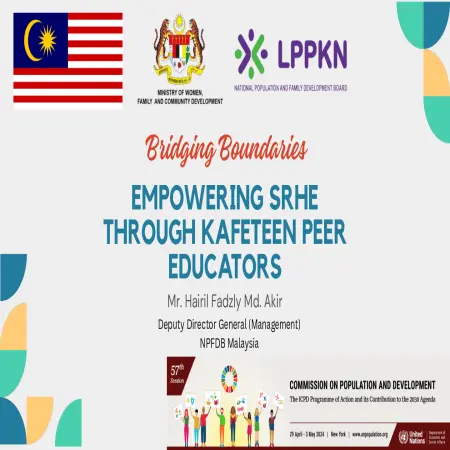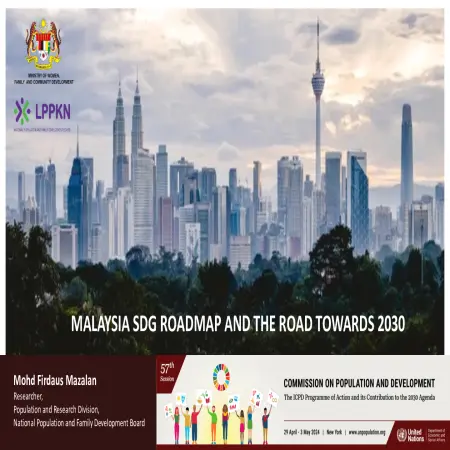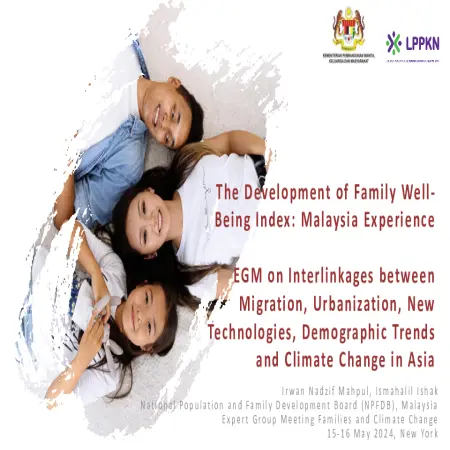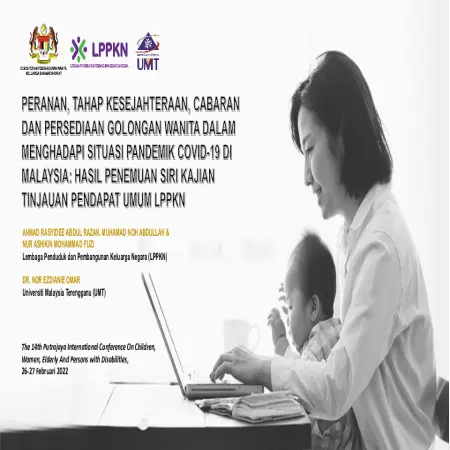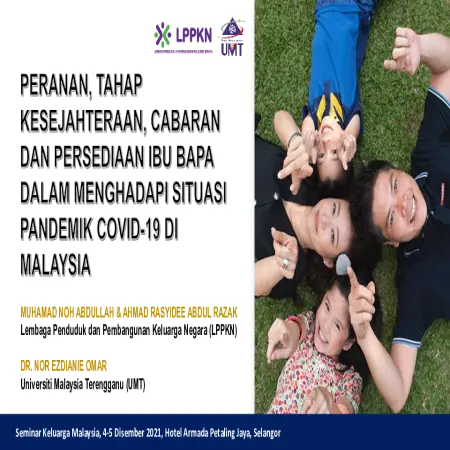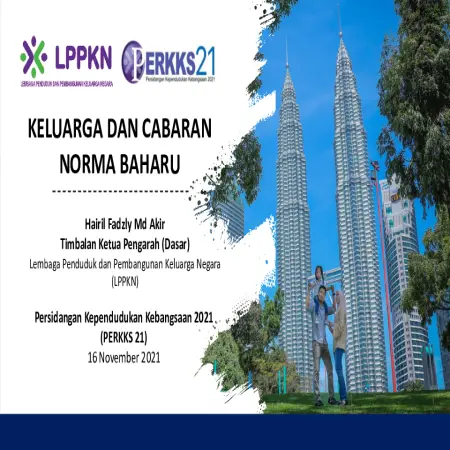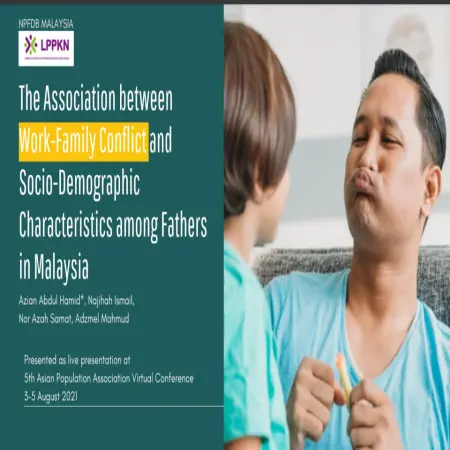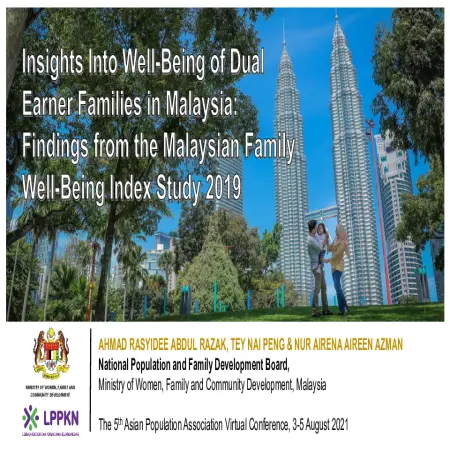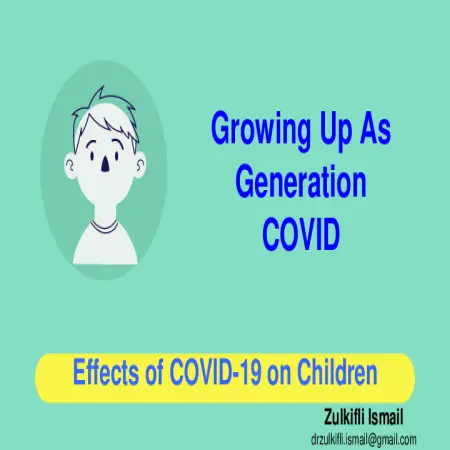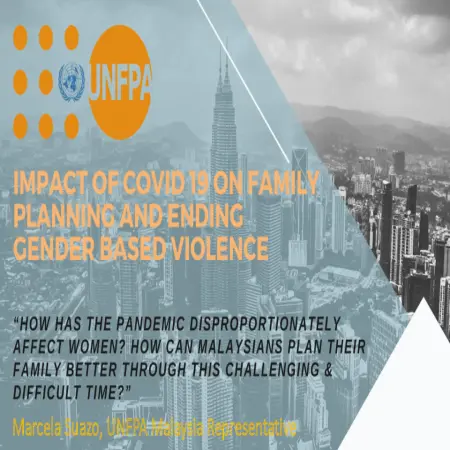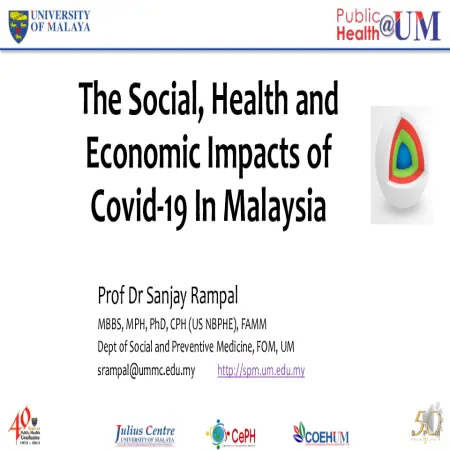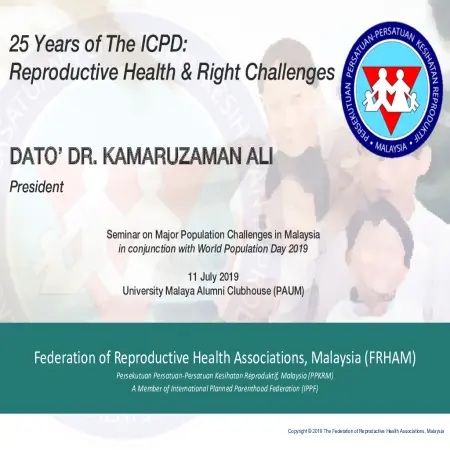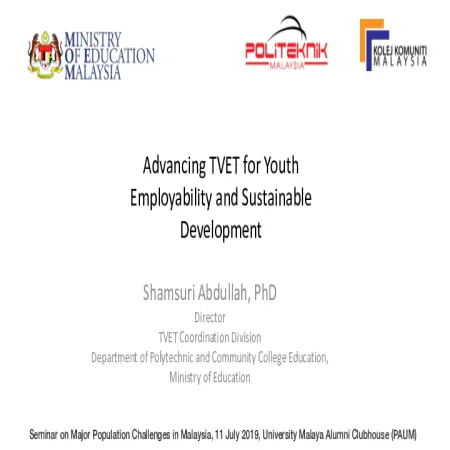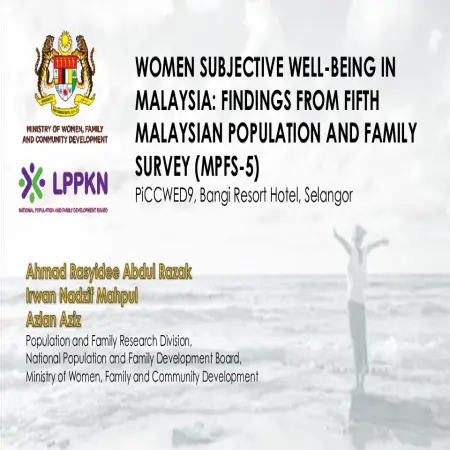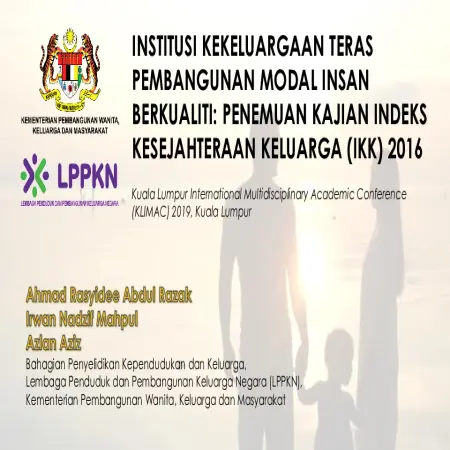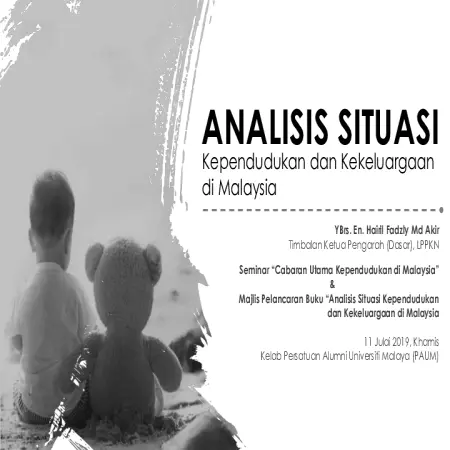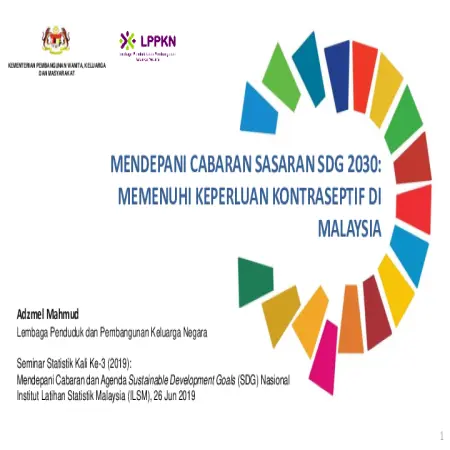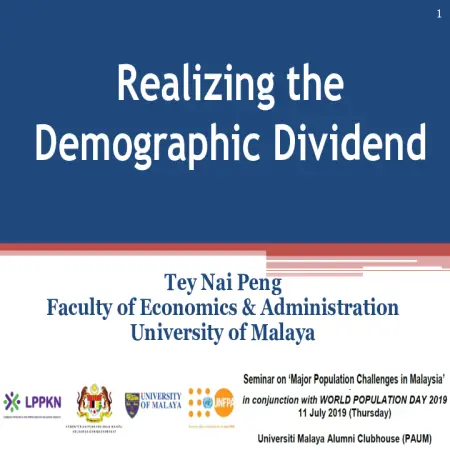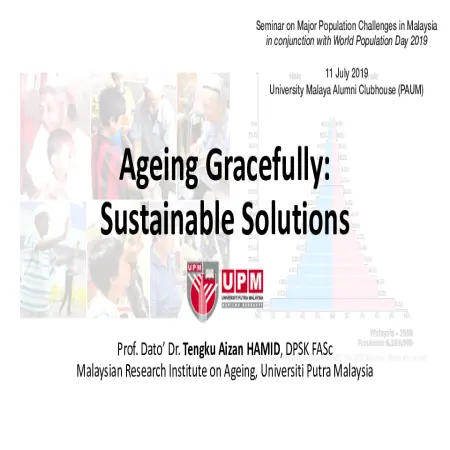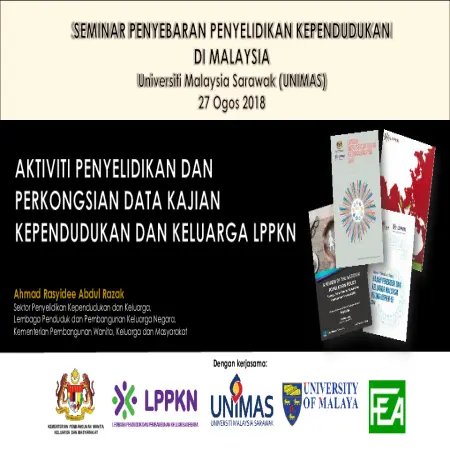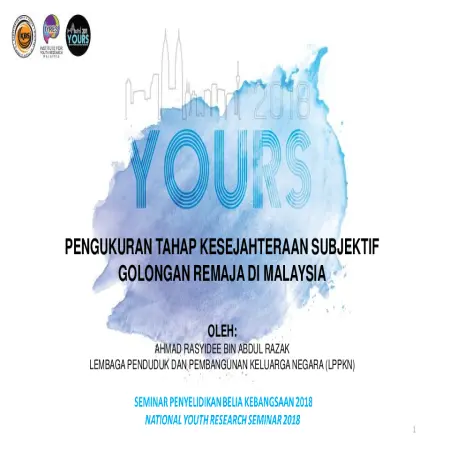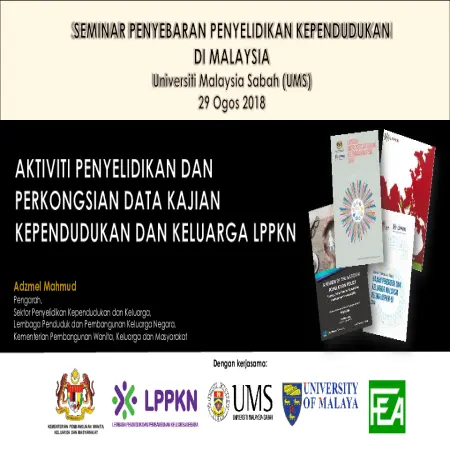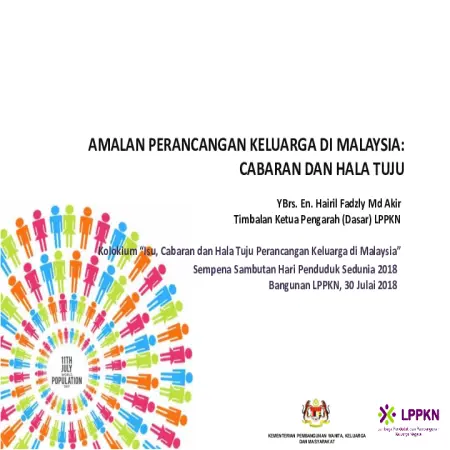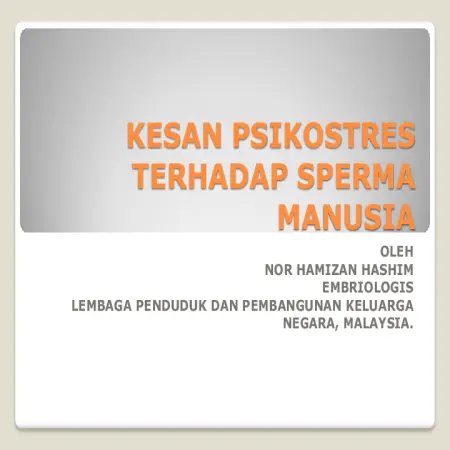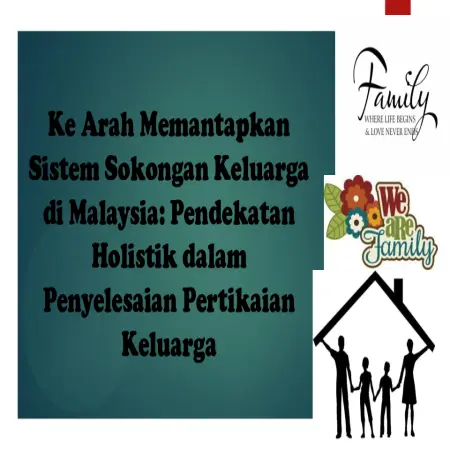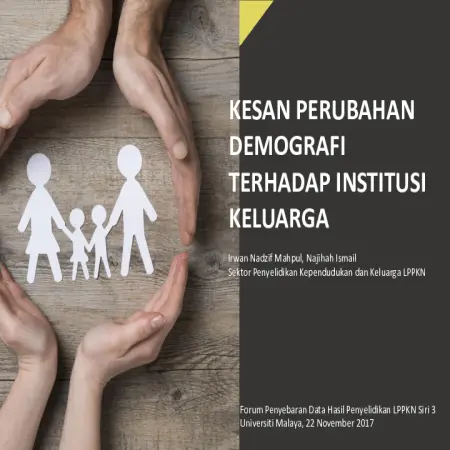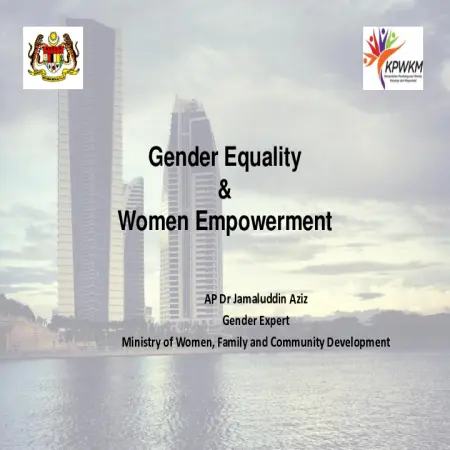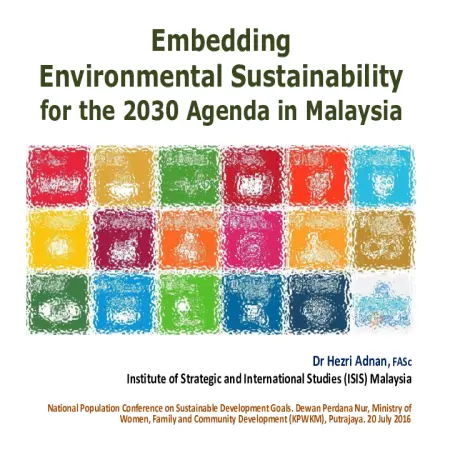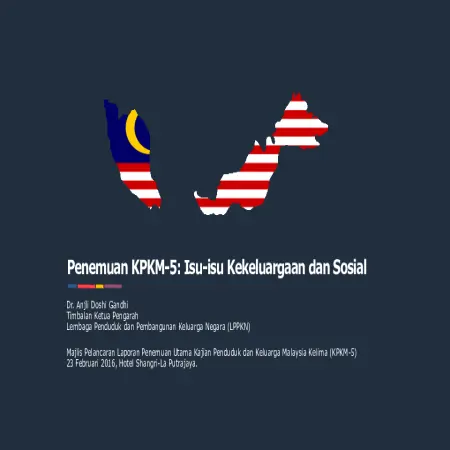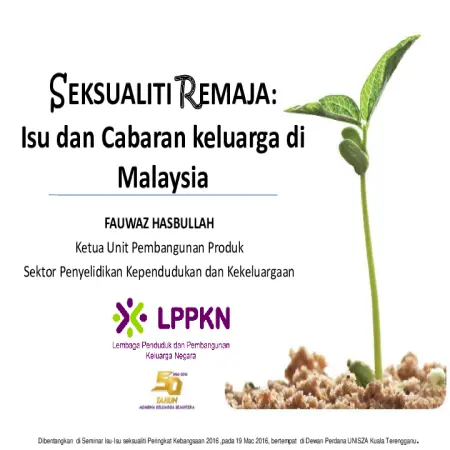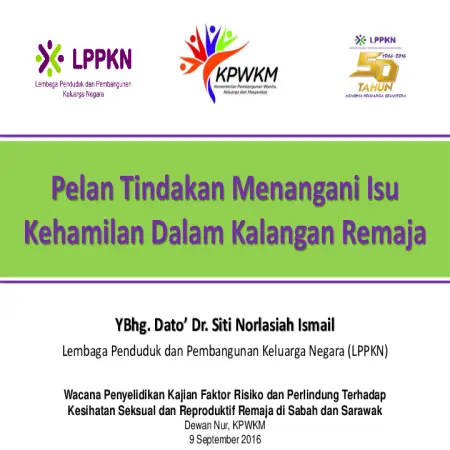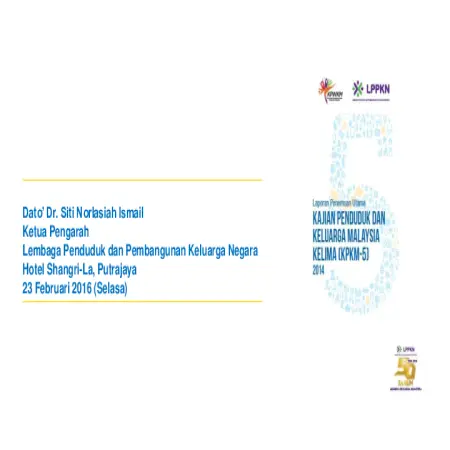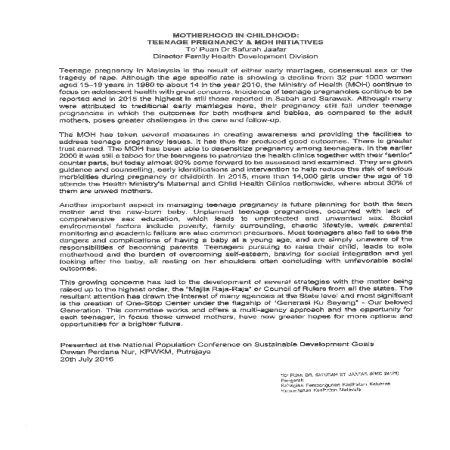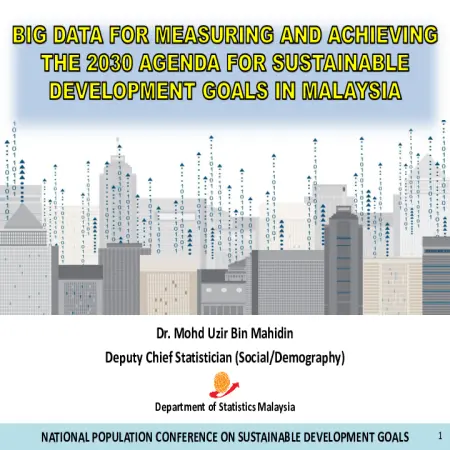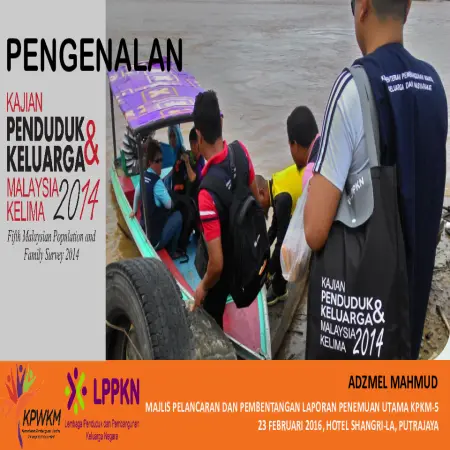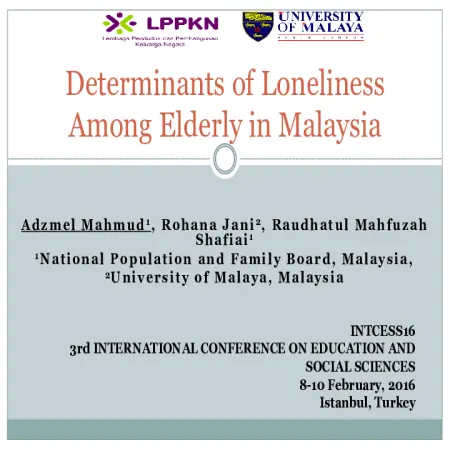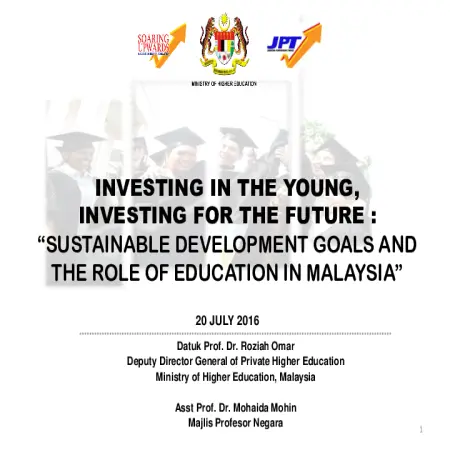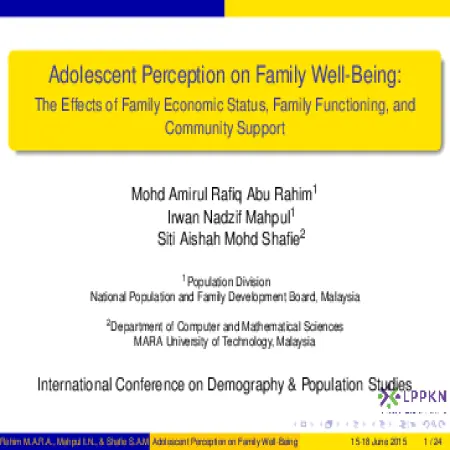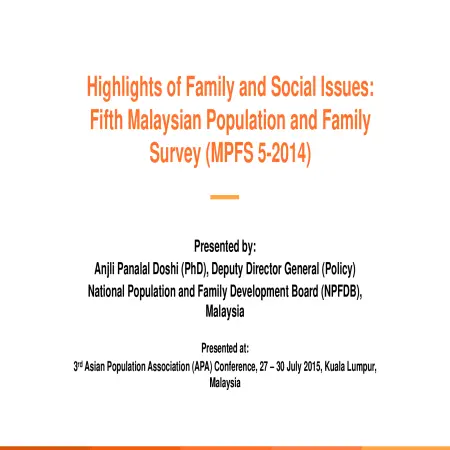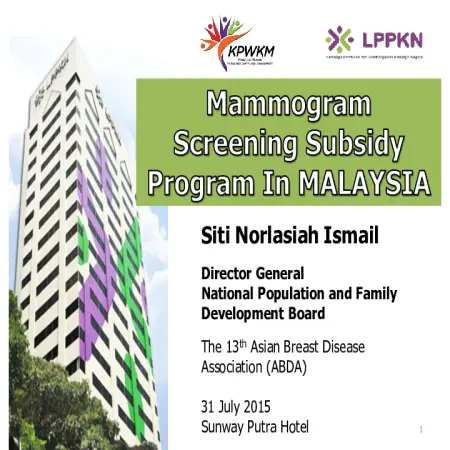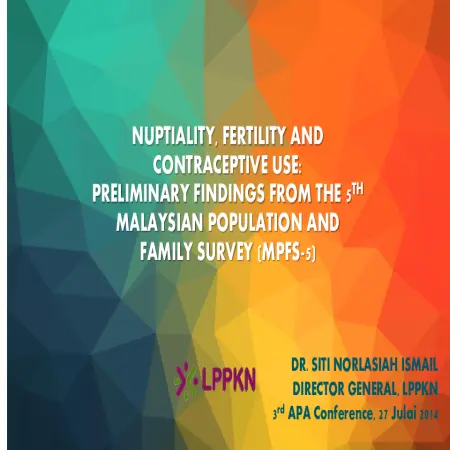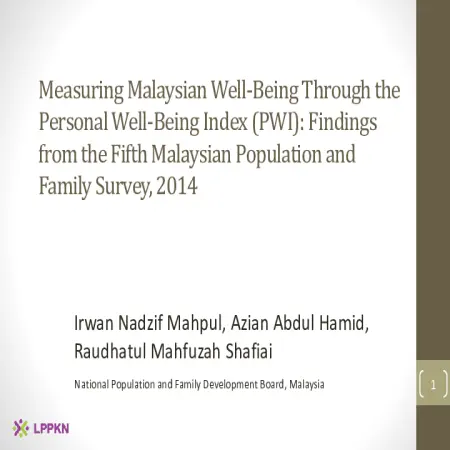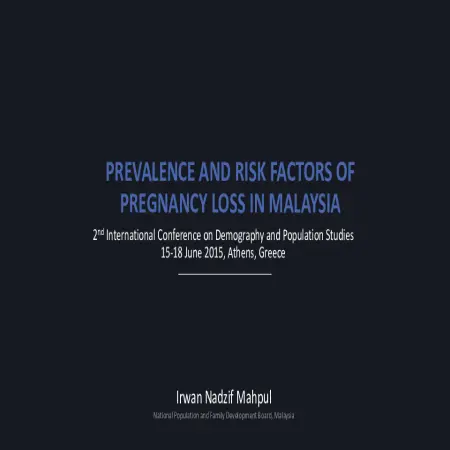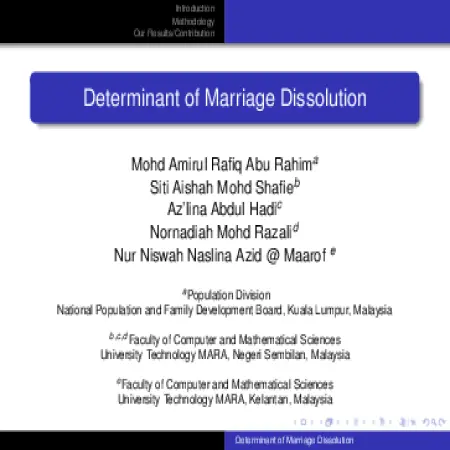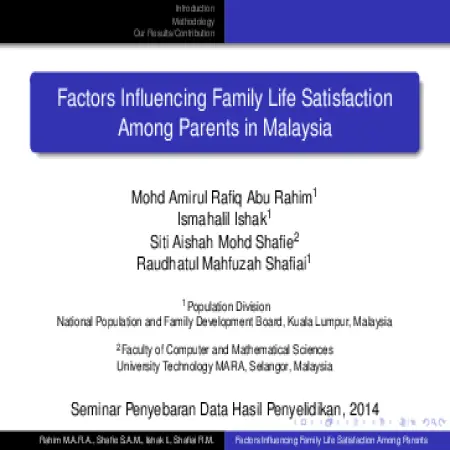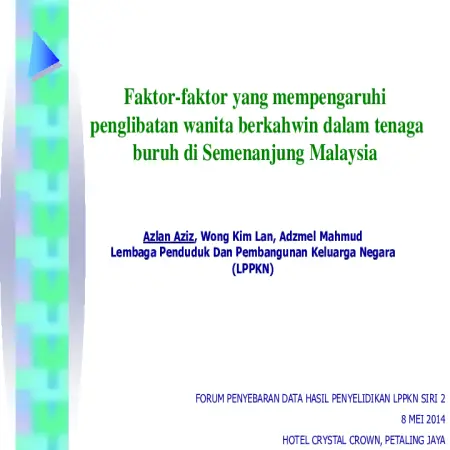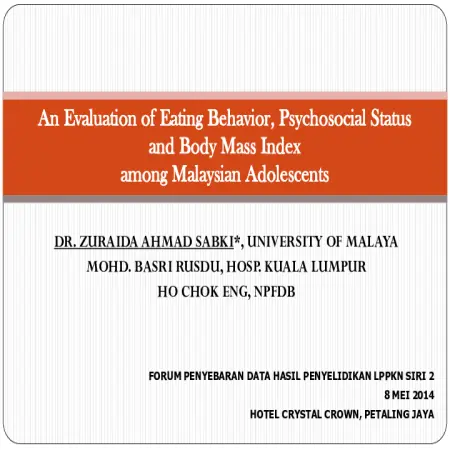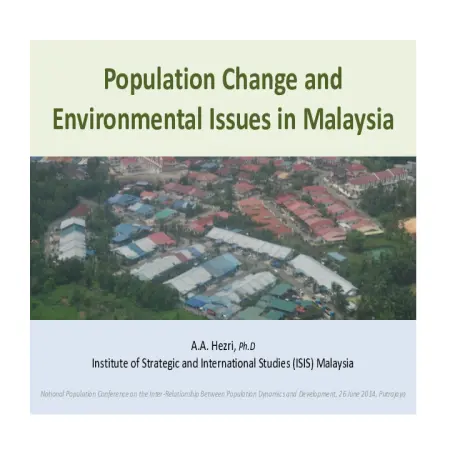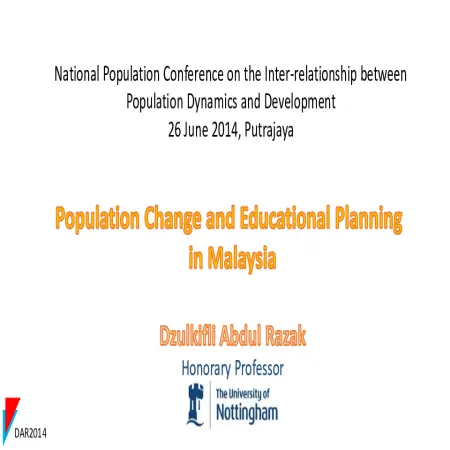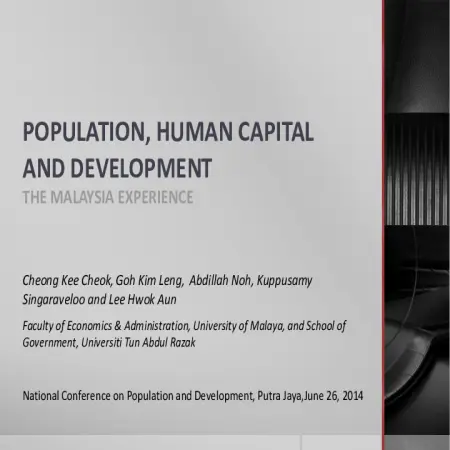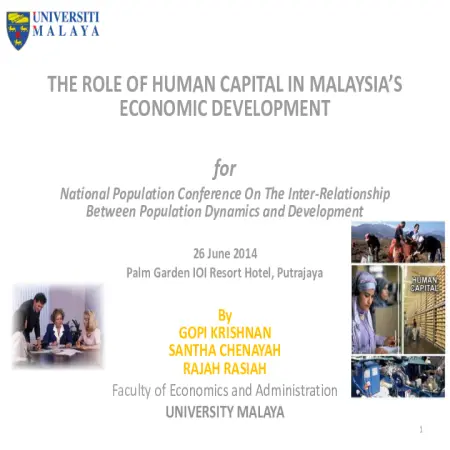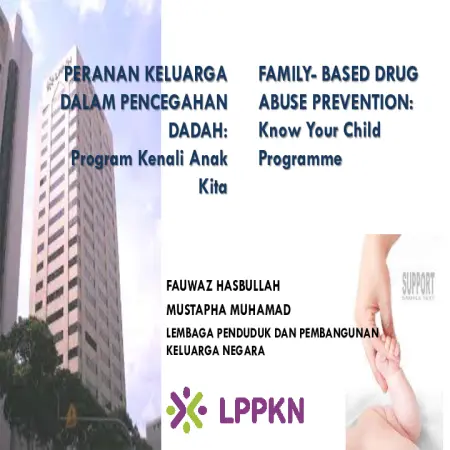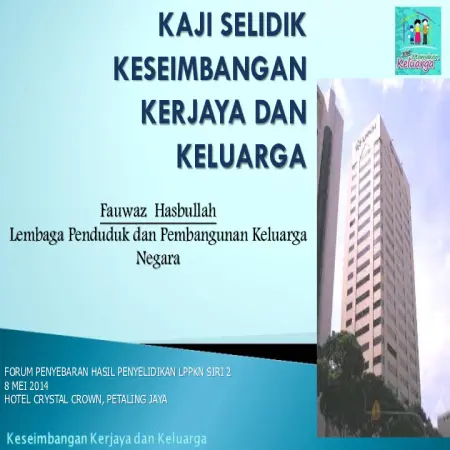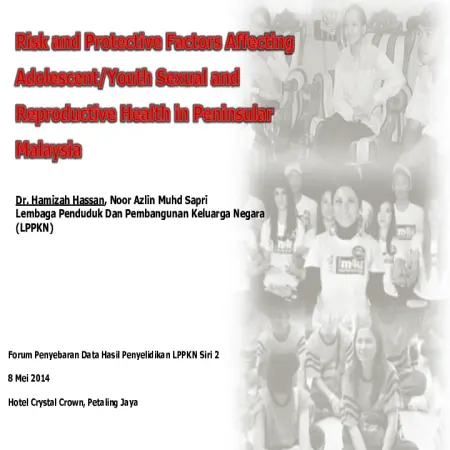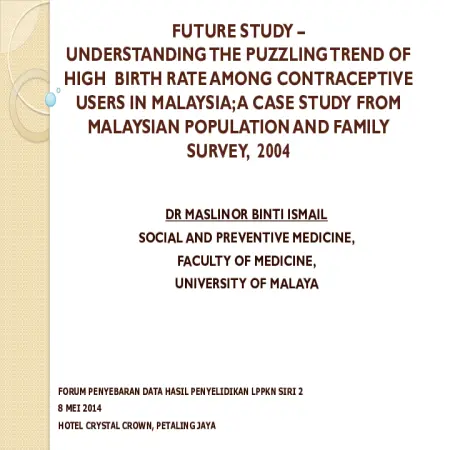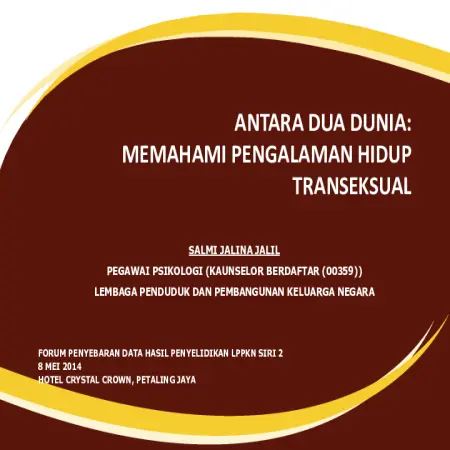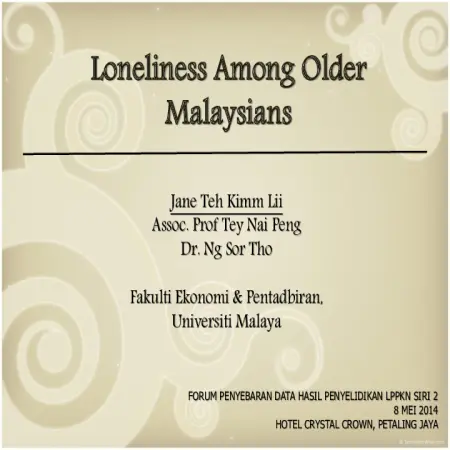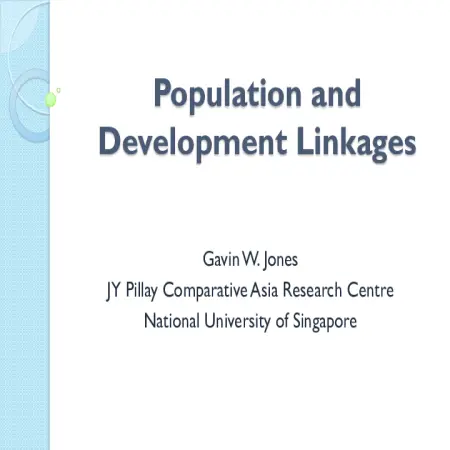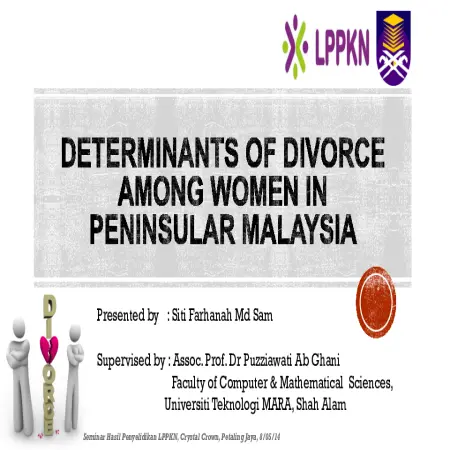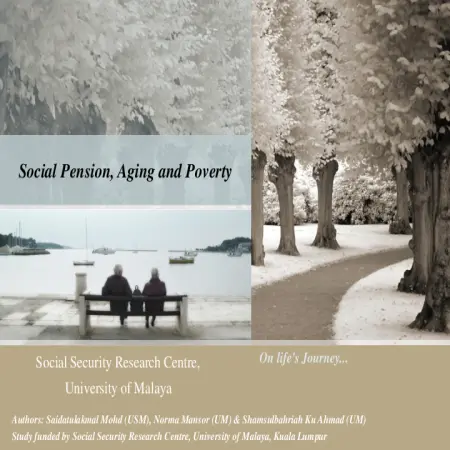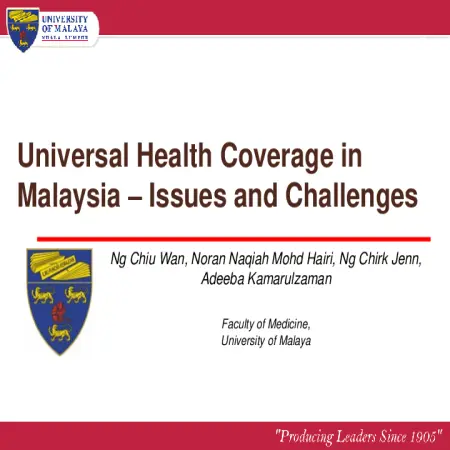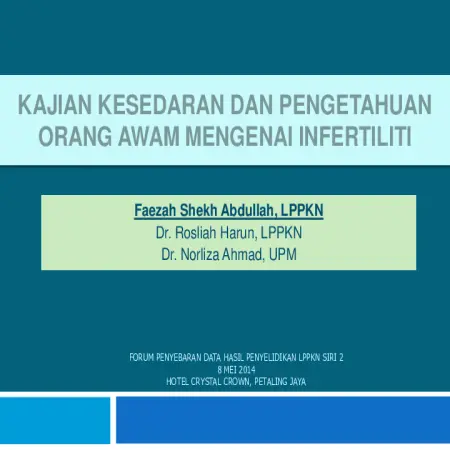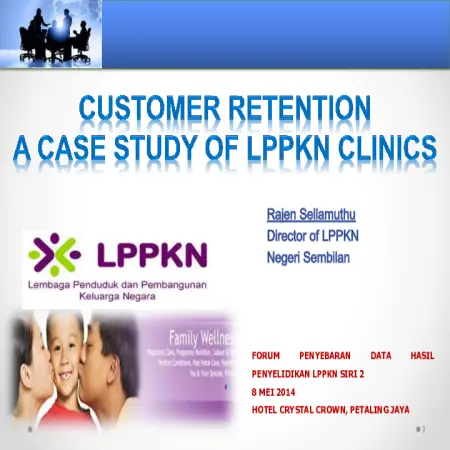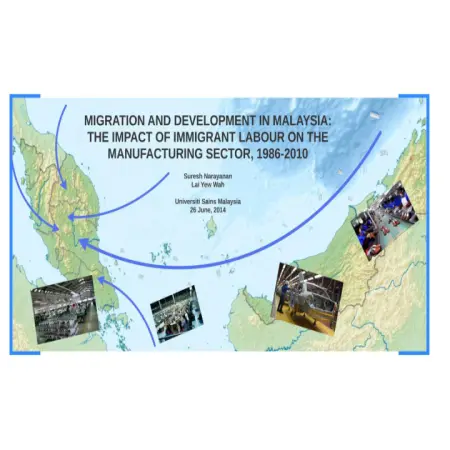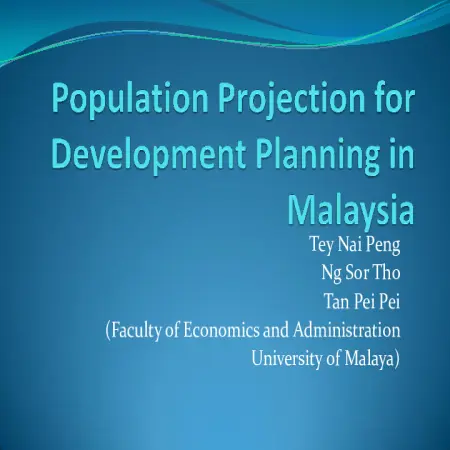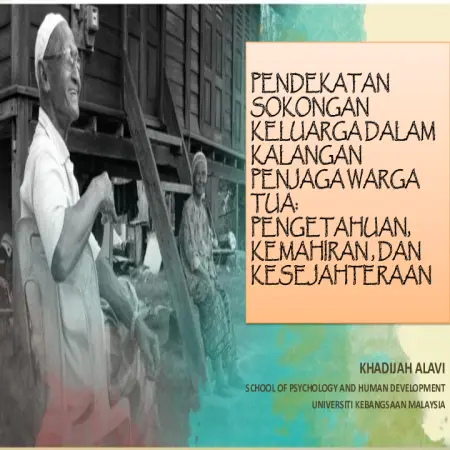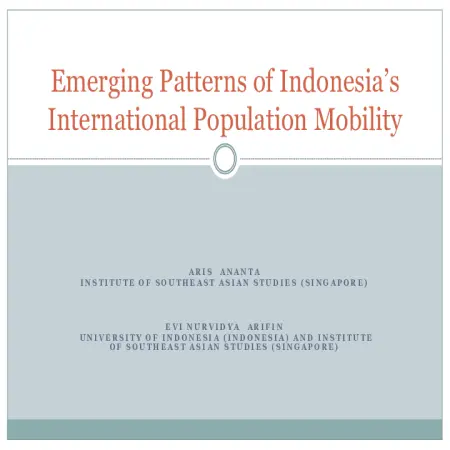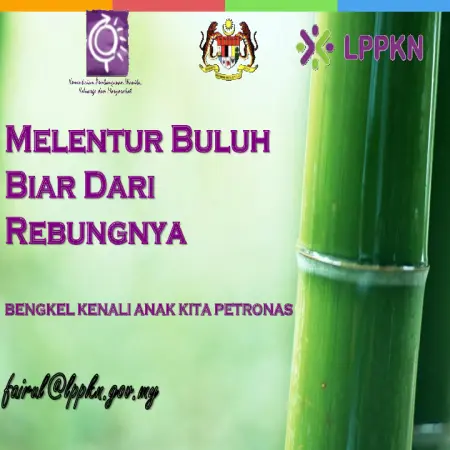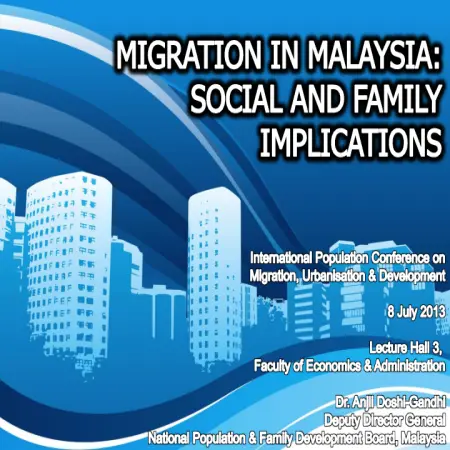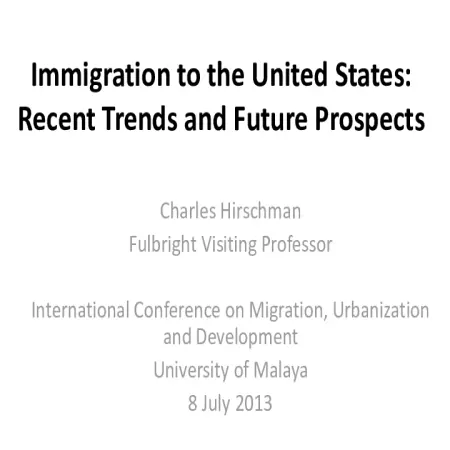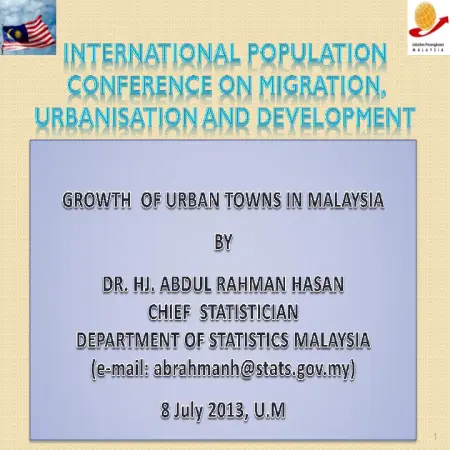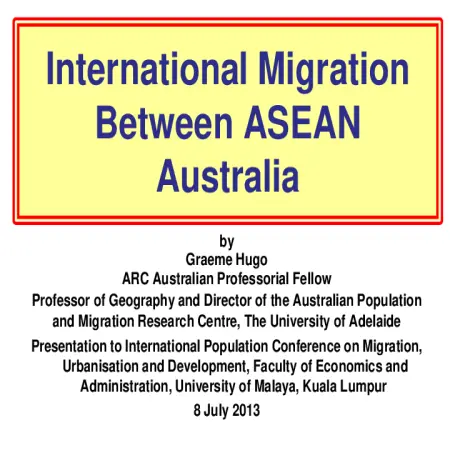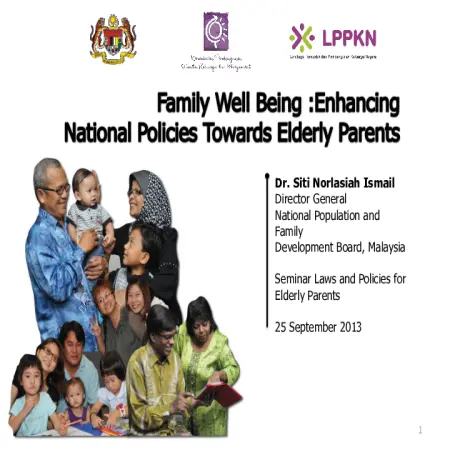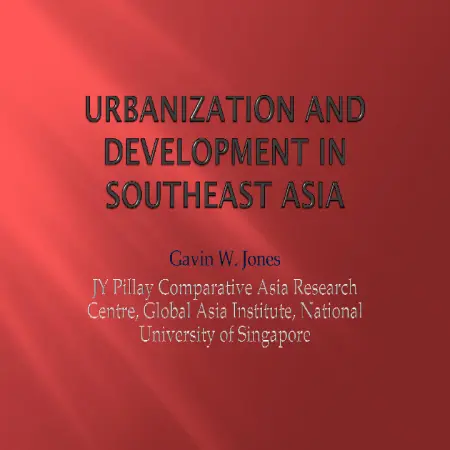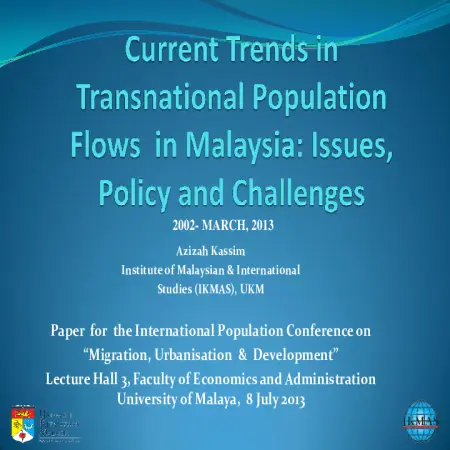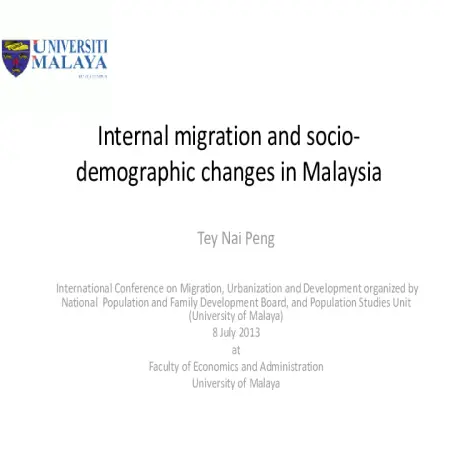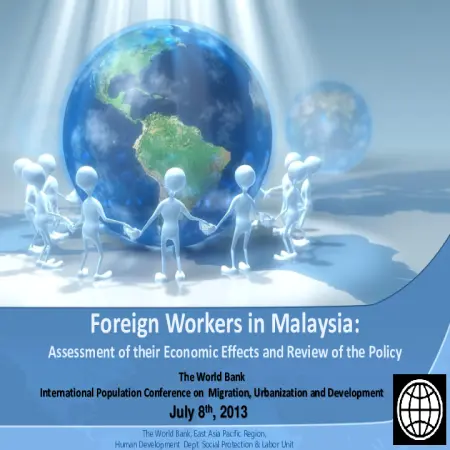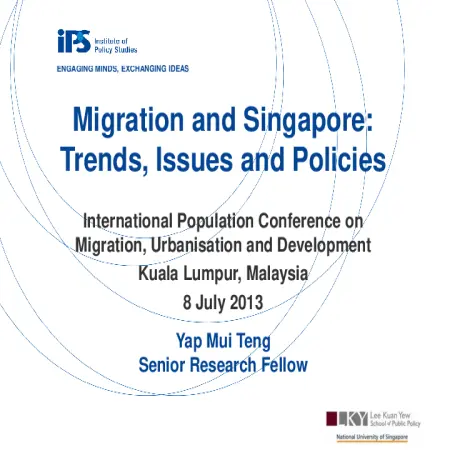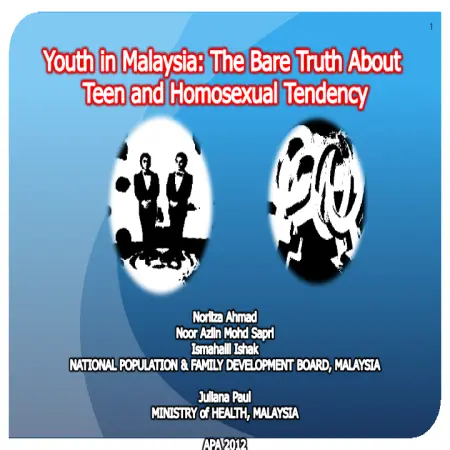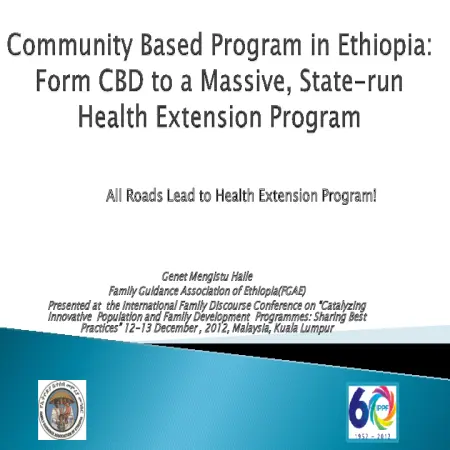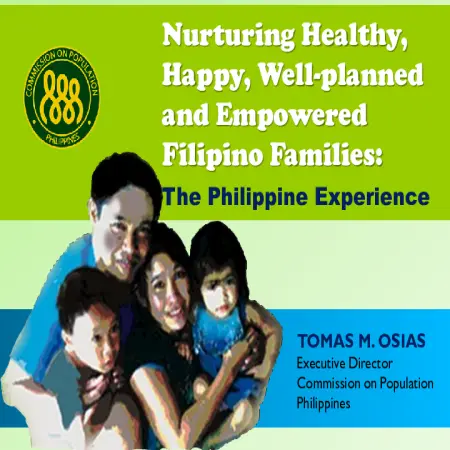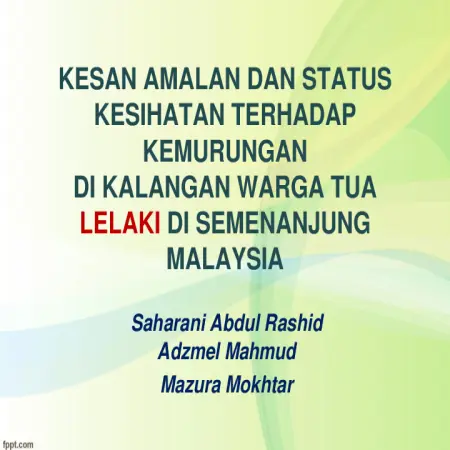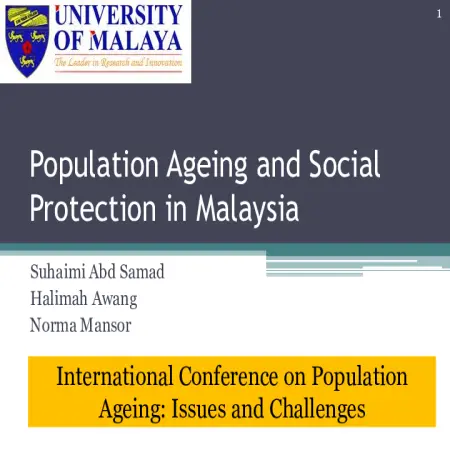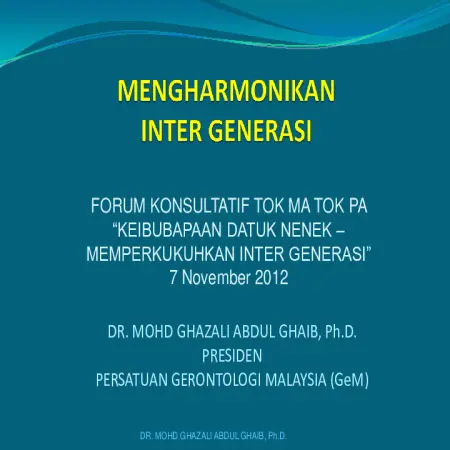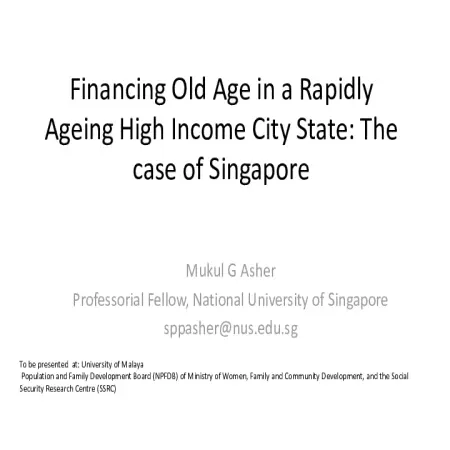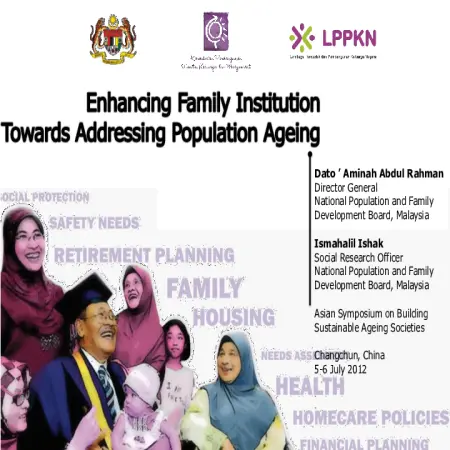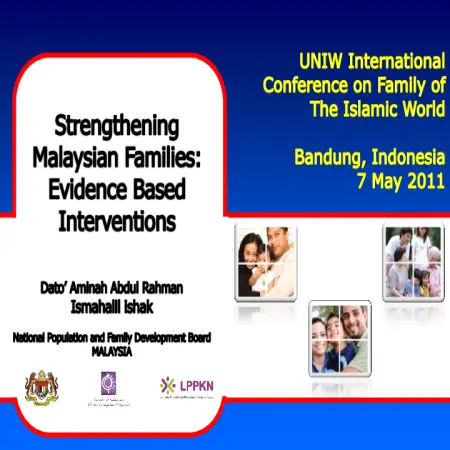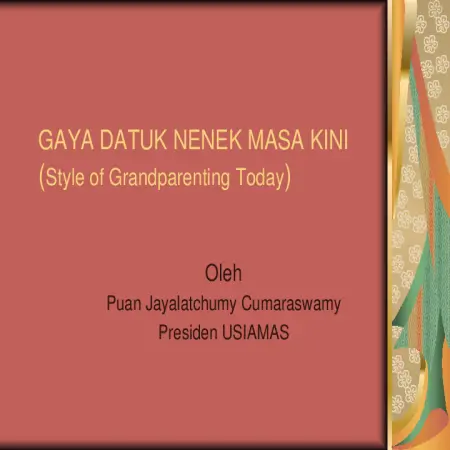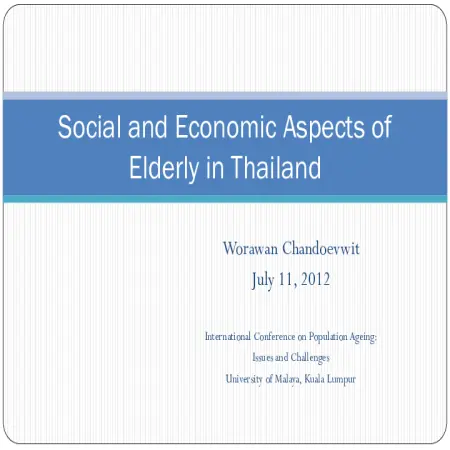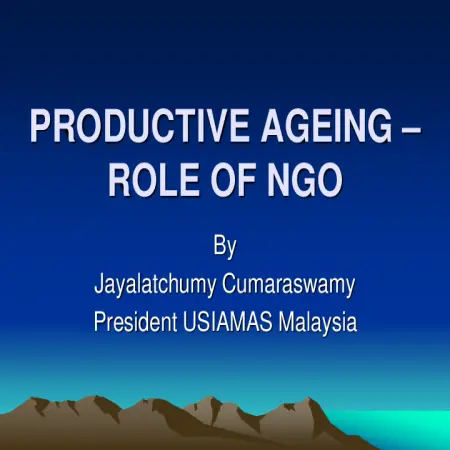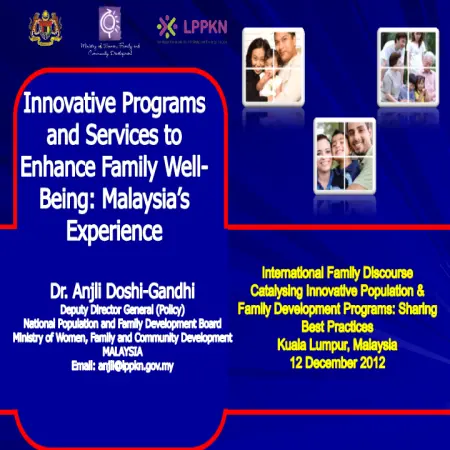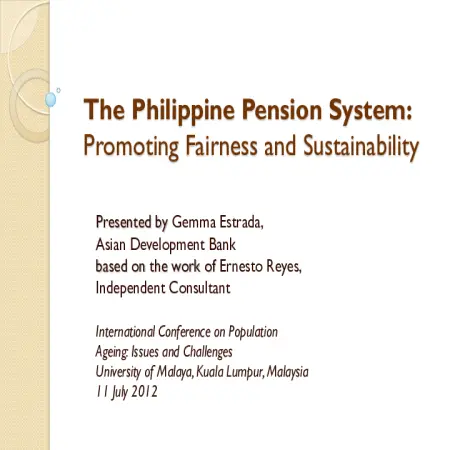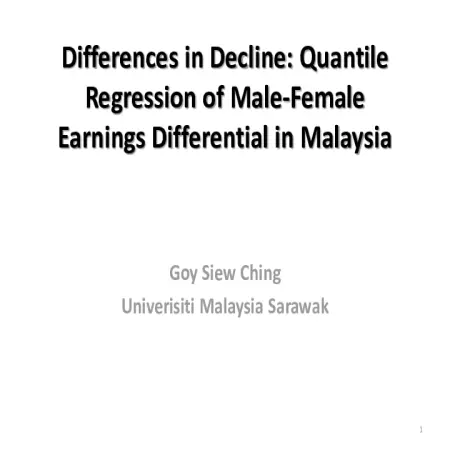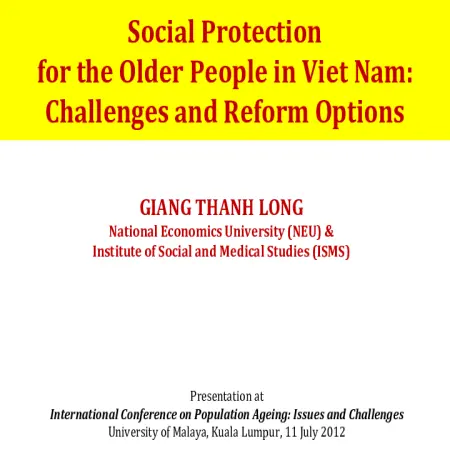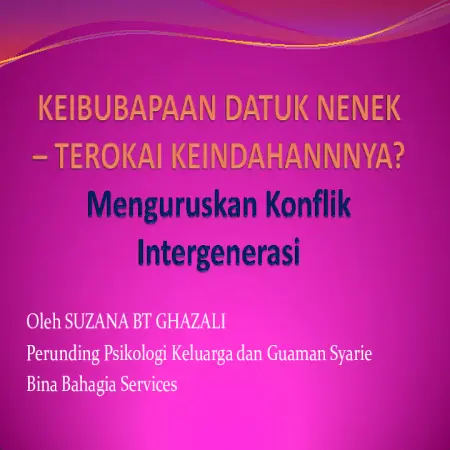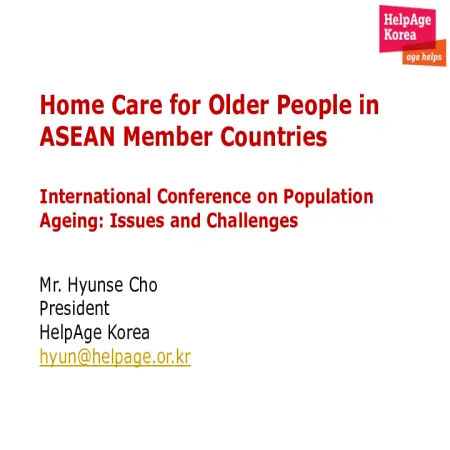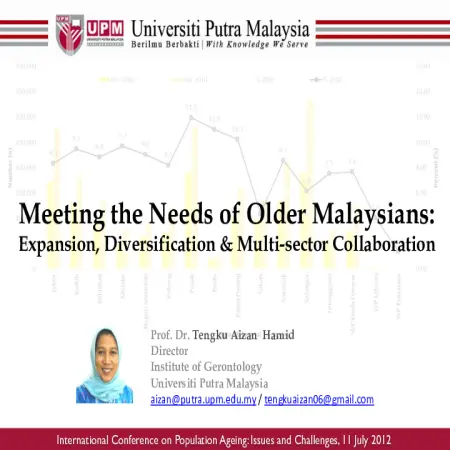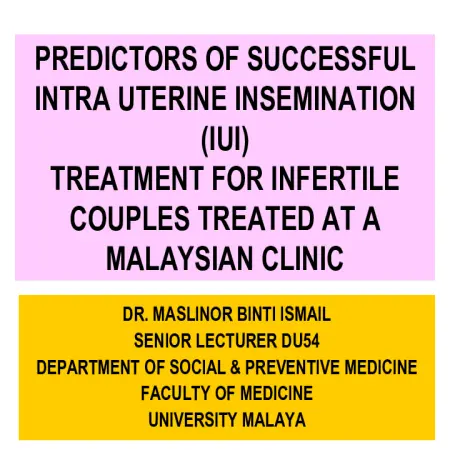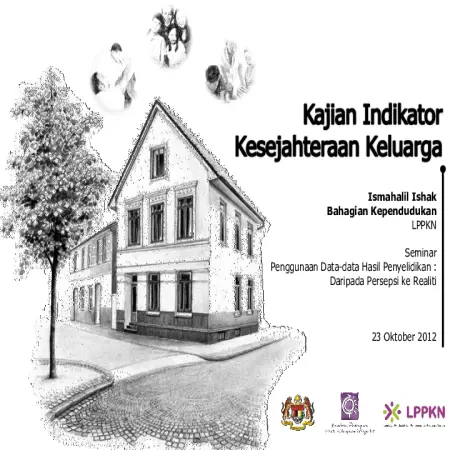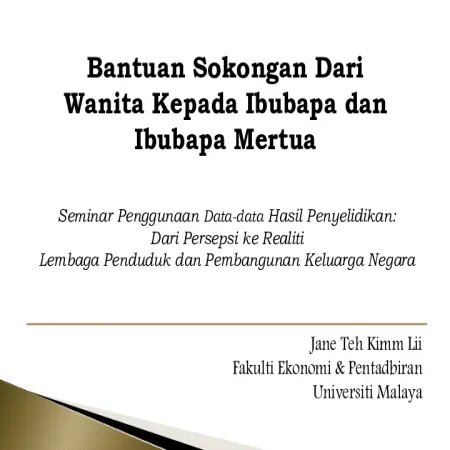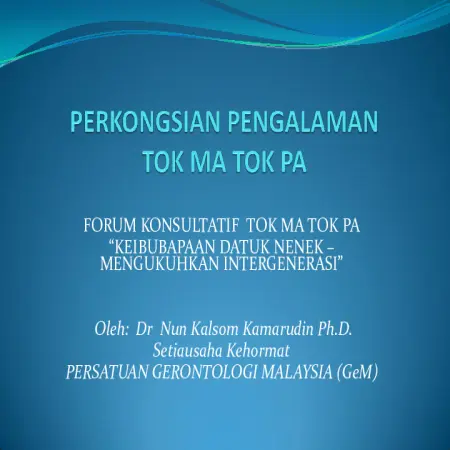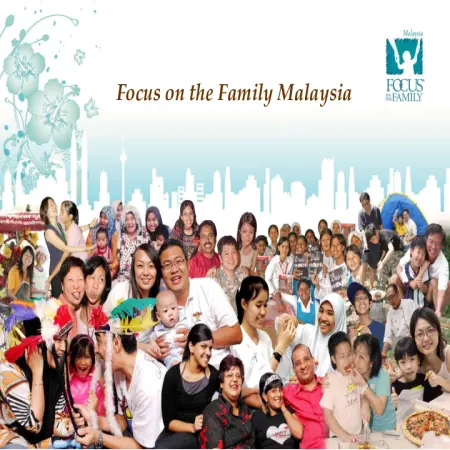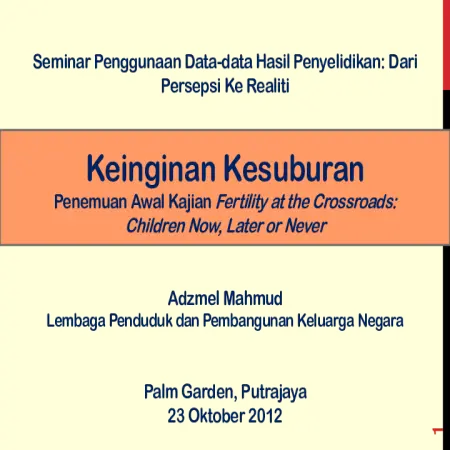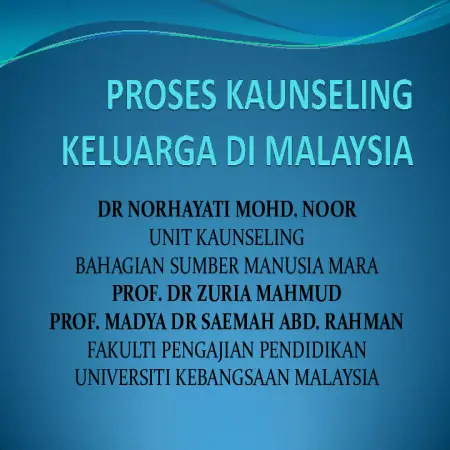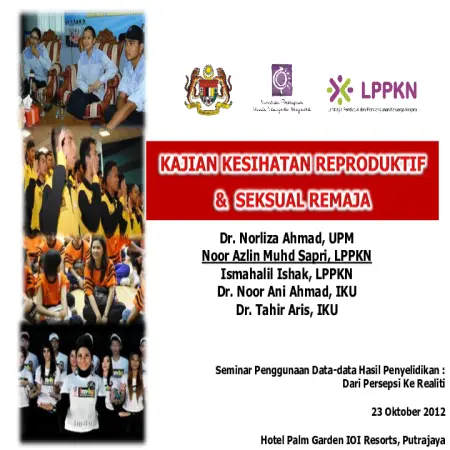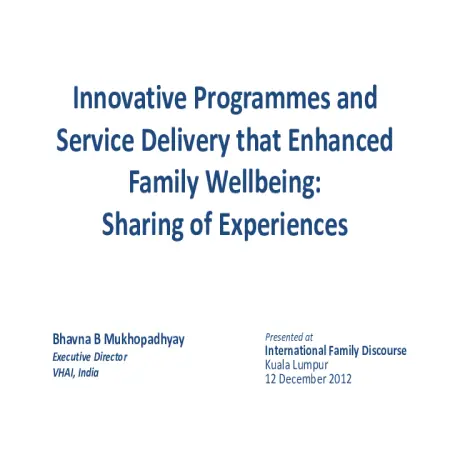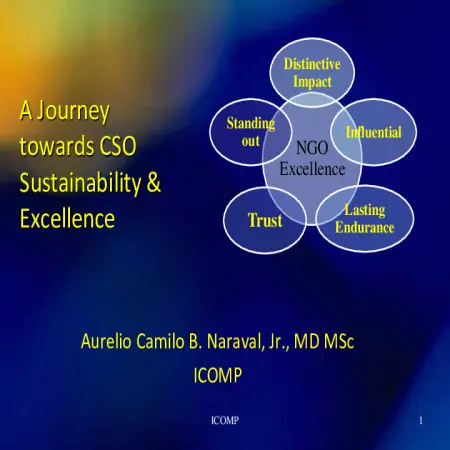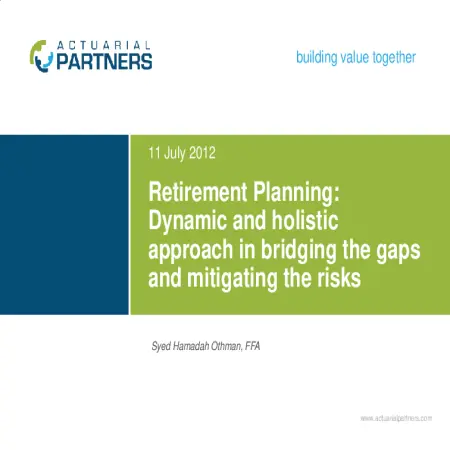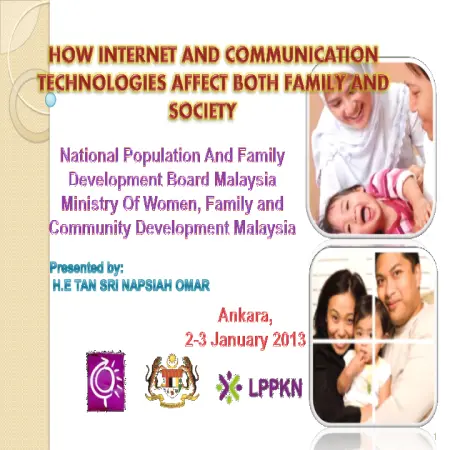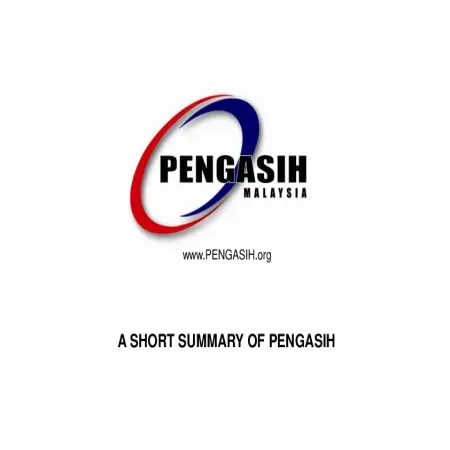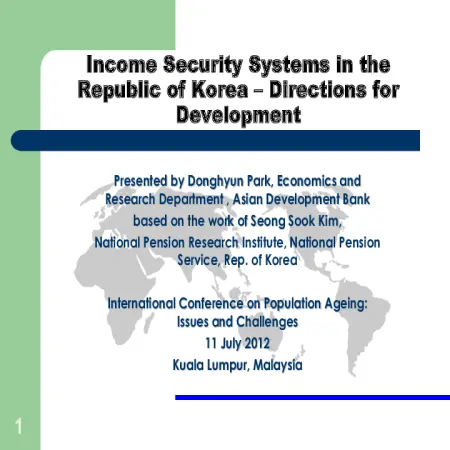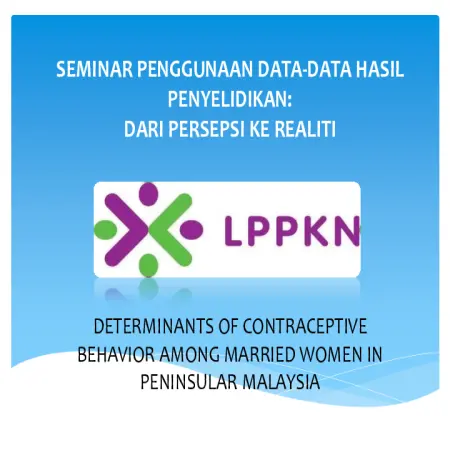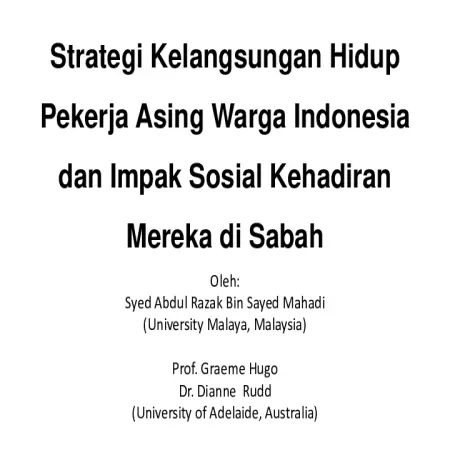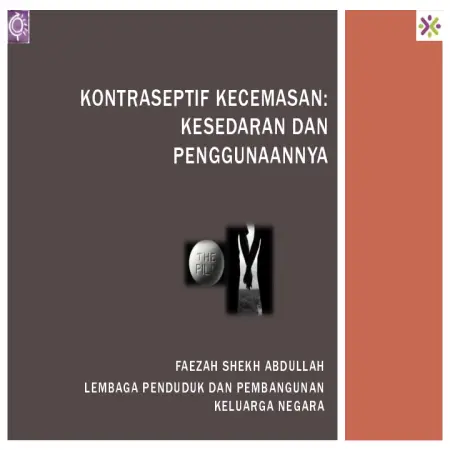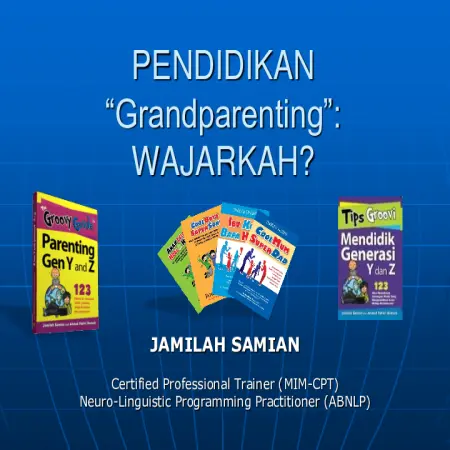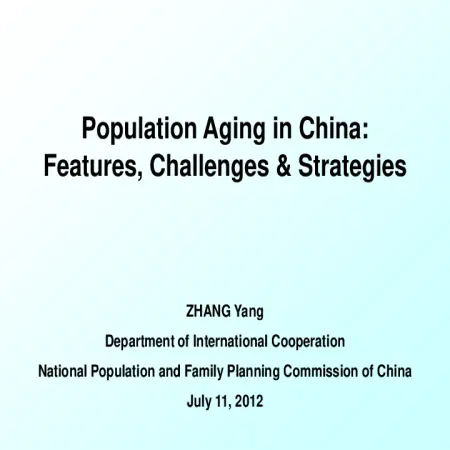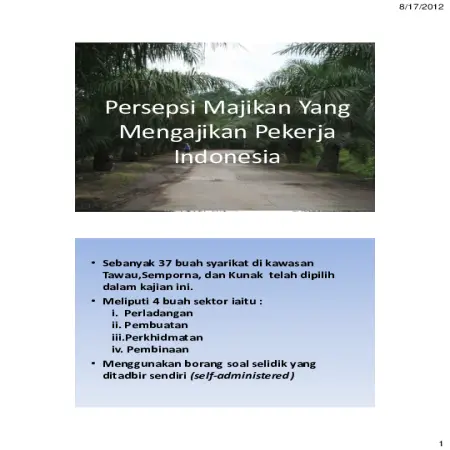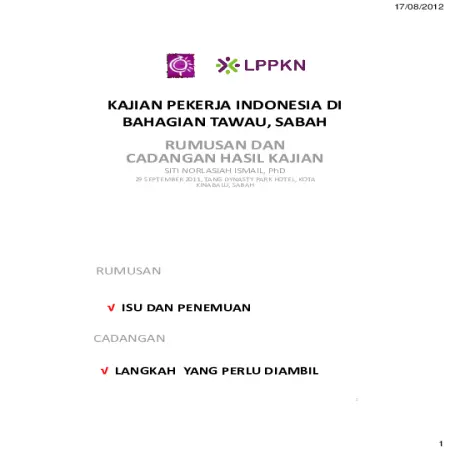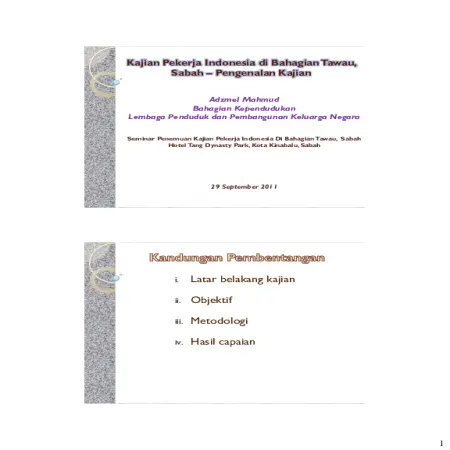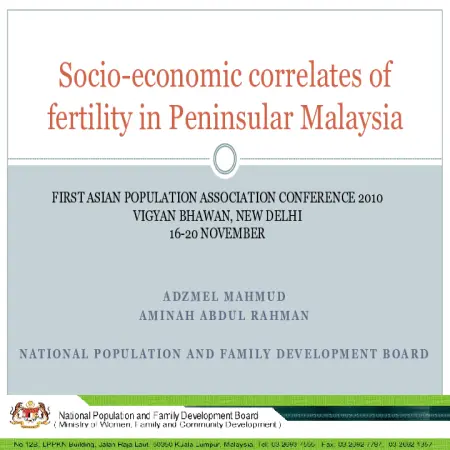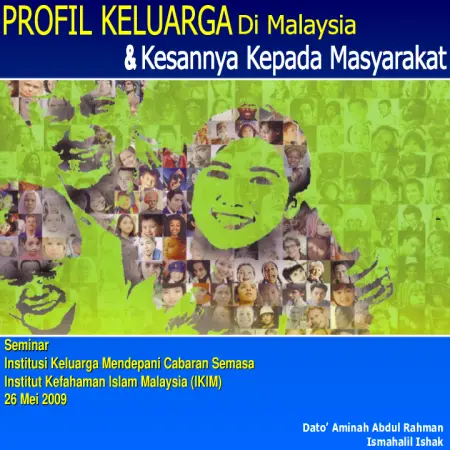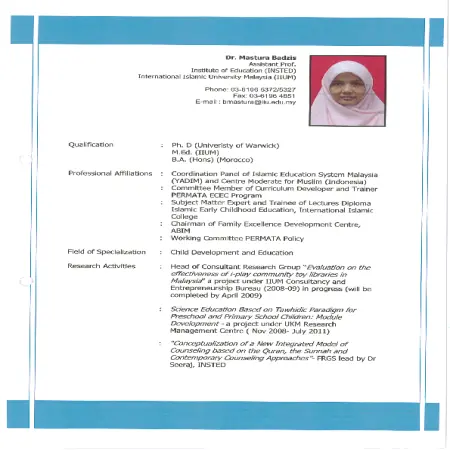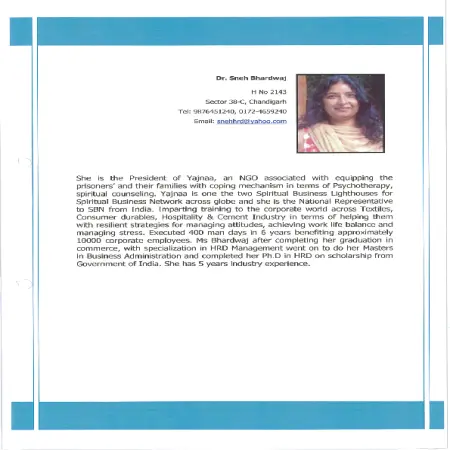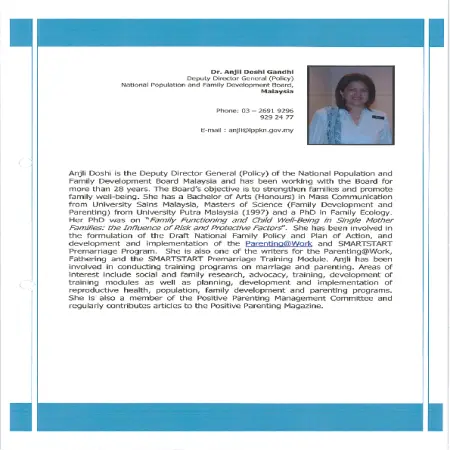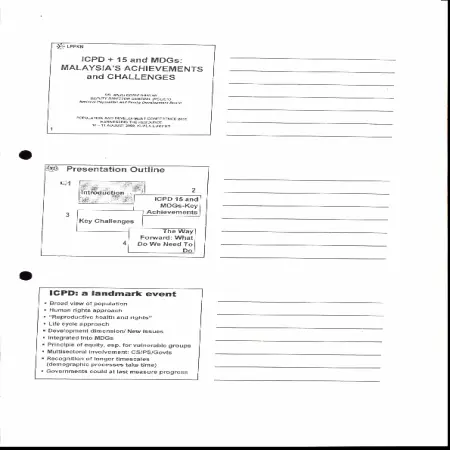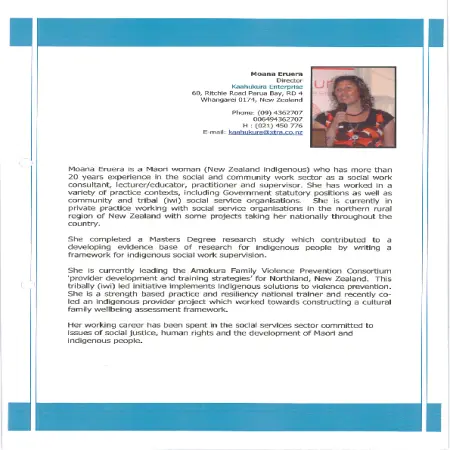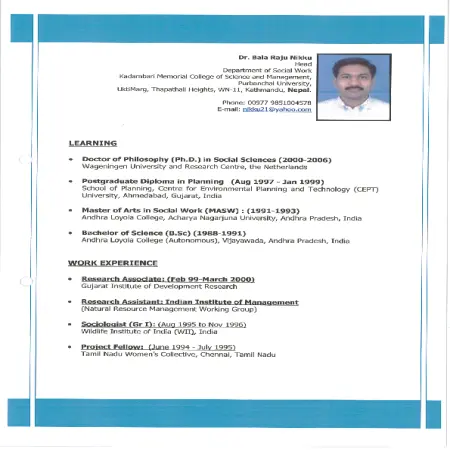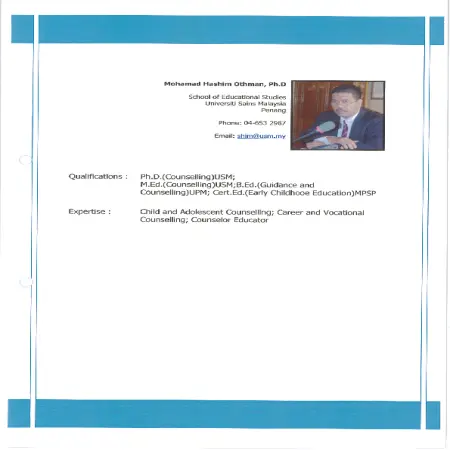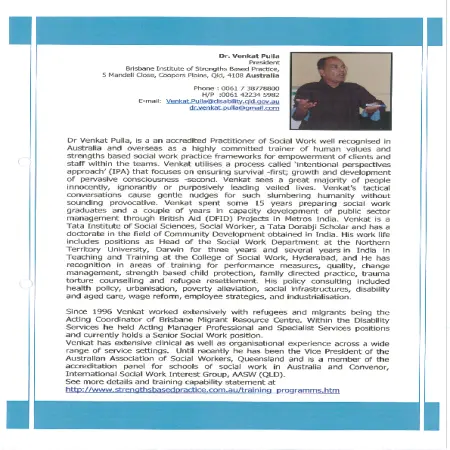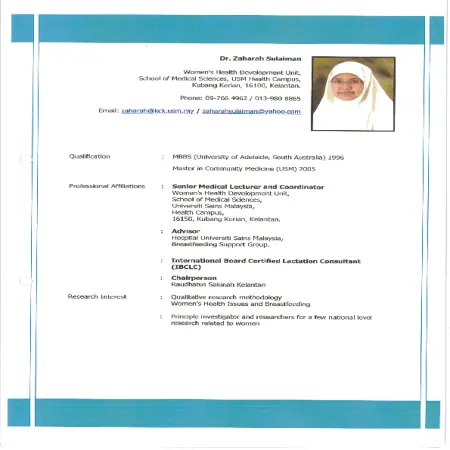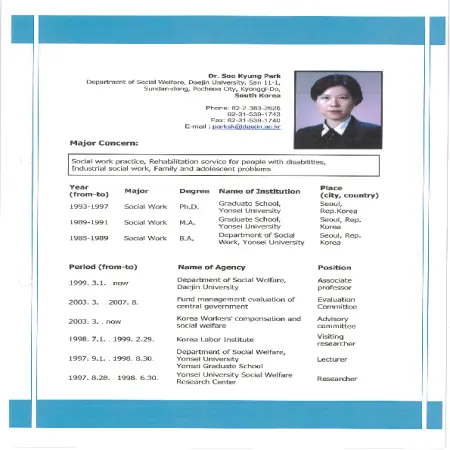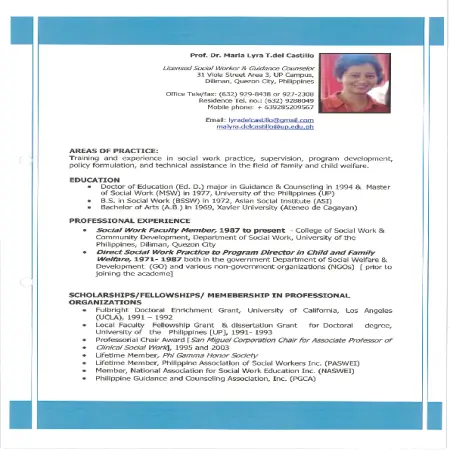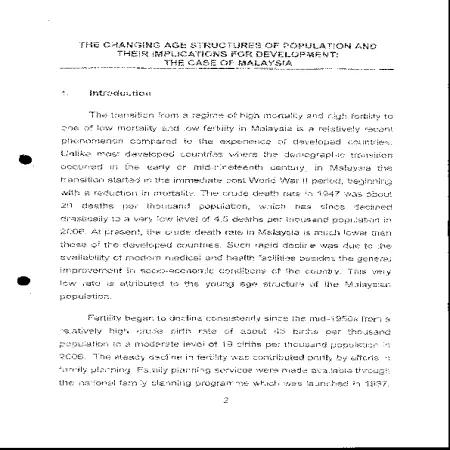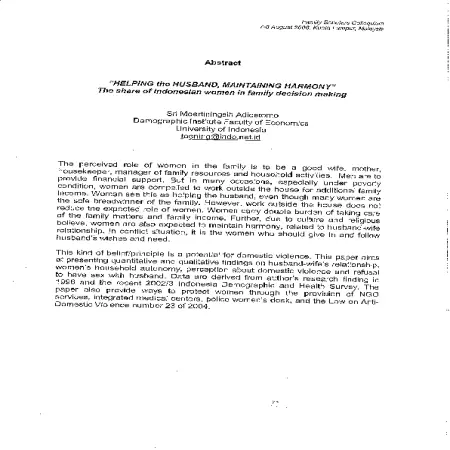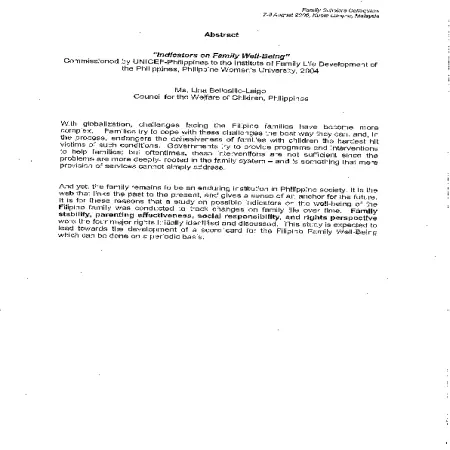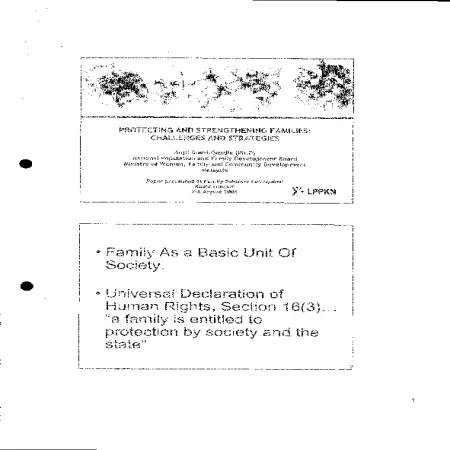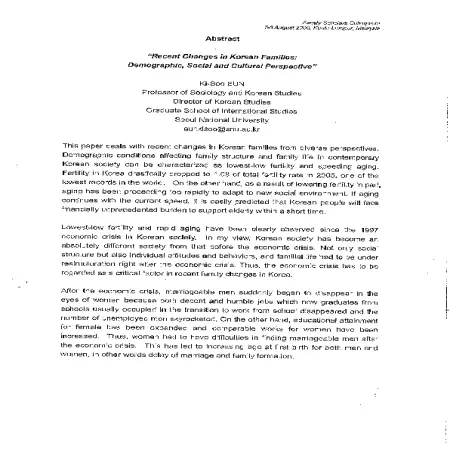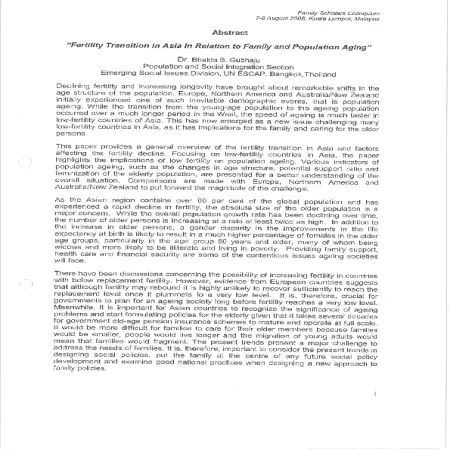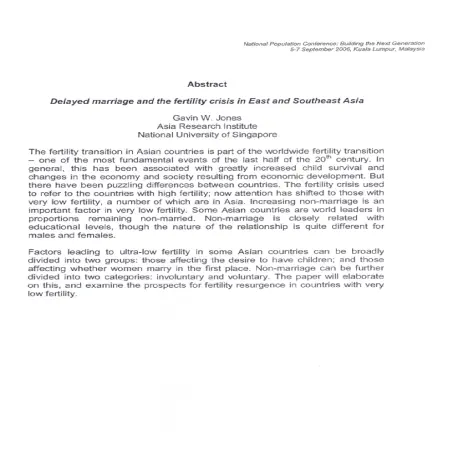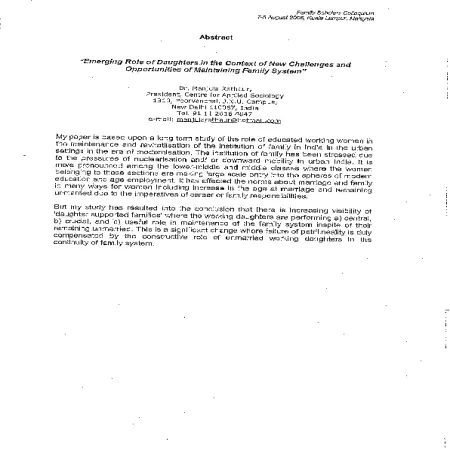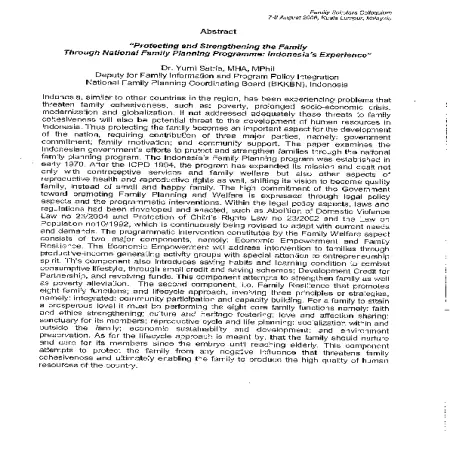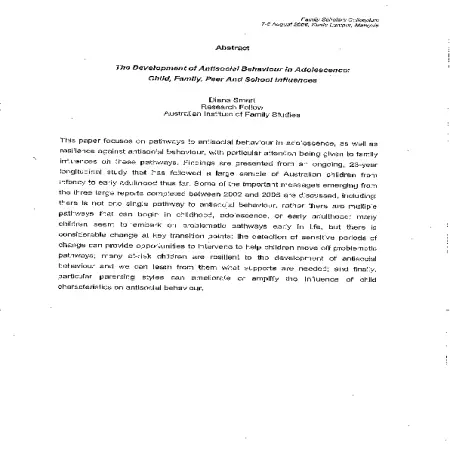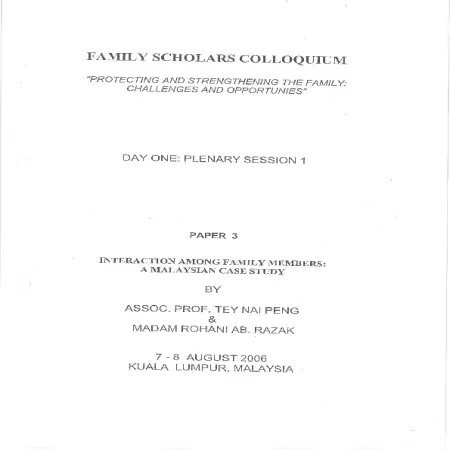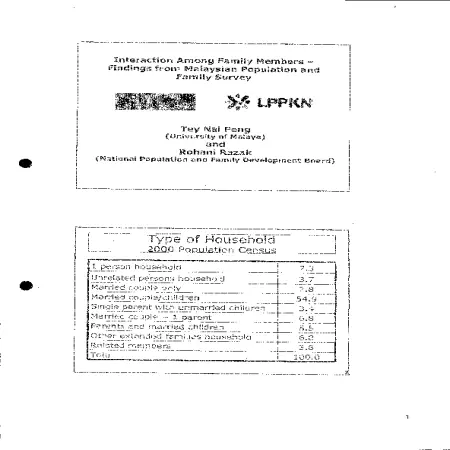Browse by Type
Results for Item type : "Conference or Workshop Item"
2024 (4)
|
|
SDGS and the impact of megatrends on Families: perspectives from Malaysia
Item Type: Conference or Workshop Item
Editor:
Year: 00/05/2024
Abstract: 57th Commissions on Population and Development (CPD57): Assessing the status of implementation of the Programmed of Action of the International Conference on Population and Development and its contribution to the follow-up and review of the 2030 Agenda for Sustainable Development during the decade of action and delivery for sustainable development. Strengthening Malaysian Families in era of megatrends, National Population and Family Development Board Malaysia (NPFBD) had LPPKN Family Centre, Nur Sejahtera Clinic Services, Population and Family Research, Training and education (family), Counseling service and program, online accessibility etc.
|
|
|
|
|
|
Bridging Boundaries: Empowering SRHE Through KafeTEEN Peer Educators
Item Type: Conference or Workshop Item
Editor:
Year: 00/05/2024
Abstract: There is increase in sexual activity prevalence among youth and high risk practice among youth who engaged in sexual activity. SRHE knowledge is known to be one of protective factors in preventing youth from engaging in high risk sexual activity. KafeTEEN YOUTH Centre Program is one of NPFBD initiative to lead SRH education dissemination for youth in Malaysia.
|
|
|
|
|
|
Malaysia SDG roadmap and the road towards 2030
Item Type: Conference or Workshop Item
Editor:
Year: 00/05/2024
Abstract: Malaysia has undertaken periodic reviews to assess the achievement of ICPD goals and objectives. Malaysia has continuously embraced sustainable development in the national agenda. In this regard, the commitment to the 2030 Agenda for Sustainable Development (2030 Agenda) has been mapped with the Mid-Term Review of the 11th Malaysia Plan to support the Sustainable Development Goals (SDGs). The national development priorities of the Twelfth Plan continue to be aligned to the Sustainable Development Goals (SDGs) of the 2030 Agenda.
|
|
|
|
|
|
The development of Family Well-Being Index: Malaysia experience. EGM on interlinkages between migration, urbanization, new technologies, demographic trends and climate change in Asia.
Item Type: Conference or Workshop Item
Editor:
Year: 00/05/2024
Abstract: The Malaysian Family Well-Being Index (MFWBI) was initiated in 2011 by the NPFDB with the aim to measure the levels of family well-being in the country and to recommend strategic initiatives to strengthen the implementation of future family intervention programs in Malaysia. In 2016, measurement of the MFWBI was repeated using an improvised instrument. The MFWBI 2016 had maintained all the 7 domain in the MFWBI 2011 and added one more domain, namely, Family and Communication Technology. The instrument’s refinement exercise was repeated again in 2019, and 2022 in order to measure the family well-being. The purpose of the refinement exercise was to ensure that the questionnaire was valid and relevant for current and near future use. The domain in the MFWBI are Family Relationship, Family Economy, Family Health, Family Safety, Family and Community Engagement, Role of Religion & Spiritual Practice, Housing and Environment, Family and Communication Technology. At the national level, the MFWBI has been recognized by the federal government as one of the national KPI in the country’s 5-year development planning (Eleventh Malaysia Plan, 2016 -2020 and Twelfth Malaysia Plan, 2012 – 2025).
|
|
|
|
2022 (1)
|
|
Peranan, tahap kesejahteraan, cabaran dan persediaan golongan wanita dalam menghadapi situasi pandemik Covid-19 di Malaysia: Hasil penemuan siri kajian tinjauan pendapat umum LPPKN
Item Type: Conference or Workshop Item
Editor:
Year: 26/02/2022
Abstract: Since the outbreak of the COVID-19 epidemic in the country since early 2020, the economy and community life have been severely affected. The increase in the number of daily cases as a result of several new waves of COVID-19 has also prompted the Government to implement a series of Movement Control Orders (MCO) nationwide. As a result, society, especially women, are seen to be increasingly stressed due to the loss of sources of income, limited involvement in outdoor activities and problems in balancing between work and family hours. Aware of this situation, the National Population and Family Development Board (NPFDB) has taken the initiative to conduct a series of public opinion polls throughout 2020 and 2021. This study aims to explore the role, level of well -being, challenges and preparation of women in facing pandemic situations. COVID-19 in Malaysia. This study is an online survey study. The findings of this study are a reflection of the current situation of society and family institutions in the face of the new wave of COVID-19. The results of a survey that focused on women showed that women were more affected than men. Although the level of well -being of women in the country is still at a satisfactory level, various issues and challenges are faced especially for those who are married. Issues of family management, children's education at home and more flexible working hours should be highlighted for consideration by the Government. It is hoped that various initiatives and development plans related to women can be planned as well as further strengthen the existing policies towards achieving the aspirations of the Malaysian Family. In general, this paper contributes to the knowledge related to the current situation of women in the face of new normative life. While in particular, this paper contributes to knowledge related to the role, well-being, challenges and preparation of women in facing the COVID-19 pandemic situation.
|
|
|
|
2021 (4)
|
|
Peranan, tahap kesejahteraan, cabaran dan persediaan ibu bapa dalam menghadapi situasi pandemik COVID-19 di Malaysia
Item Type: Conference or Workshop Item
Editor:
Year: 01/12/2021
Abstract: This slide describes the current situation in family institutions in particular related to the role, level of well-being, challenges and preparation of mothers and fathers in facing the COVID-19 pandemic that has spread in the country since early 2020. The subtopics in this slide are based on 10 public opinion polls conducted by the National Population and Family Development Board (NPFDB) online throughout 2020 and 2021. The survey, which involved nearly 13,000 respondents, focused on Malaysian mothers and fathers who have children aged 3 to 24 years only. There are seven subtopics in this paper, namely (i) Introduction; (ii) Literature Review; (iii) New Norma Family; (iv) The Role of Parents in the Family; (v) Level of Parental Well -Being in Family Institutions; (vi) Challenges and Parental Preparation Related to the Use of Digital Technology; and (vii) Recommendations and Conclusions.
|
|
|
|
|
|
Keluarga dan cabaran norma baharu
Item Type: Conference or Workshop Item
Editor:
Year: 00/00/2021
Abstract: This slide describes the current situation in family institutions during the pre-pandemic COVID-19, by also showing the pattern of family well-being in the country through the Malaysian Family Well-Being Index (FWBI), a special measure introduced by the National Population and Family Development Board (NPFDB) since 2011. Despite the increase in scores in the third series of FWBI in 2019, the situation in family institutions seems to have changed with the onset of the COVID-19 epidemic in the country in early 2020. Sensitive to the increasing number of daily cases of the effects of the COVID-19 pandemic wave in the country, NPFDB has conducted a series of online public opinion poll studies to know some aspects of life including (i) the current situation of the pandemic era family; (ii) the family's behavior in facing a pandemic situation (iii) the role of mothers and fathers in the family during a pandemic; (iv) the level of well -being of mothers and fathers in the family institution; and (iv) the challenges and preparation of parents related to the use of digital technology. The results of this survey have been used as the main input to assist the Ministry of Women, Family and Community Development (MWFCD), especially NPFDB to develop appropriate programs and services as well as disseminate findings through existing social media platforms to the general public. Various initiatives including economic and social stimulus packages have been implemented by the Government to address the issue of the COVID-19 pandemic, particularly to the affected groups, in line with the "No One Left Behind" statement. With the allocation that has been channeled, MWFCD through its agencies including the Social Welfare Department (JKM) and NPFDB has intensified efforts to help the affected target groups, in addition to continuing existing activities, programs and services. In general, these stimulus and assistance packages have not only had a positive impact on economic recovery, but also on the social development of the community. Recently, with the concept of "Malaysian Family" introduced by YAB Dato 'Sri Ismail Sabri Yaakob, the Prime Minister of Malaysia is seen to be able to be a medium for the unification of society across religious, racial and ethnic boundaries to work together to solve the big problems facing the country when this. In addition, it can indirectly help further strengthen the family institution, as a basic unit that produces quality human capital for national development.
|
|
|
|
|
|
The association between work family conflict and social demographic characteristics among fathers in Malaysia
Item Type: Conference or Workshop Item
Editor:
Year: 00/00/2021
Abstract: Those living in urban, Indian, age 30-44 years, higher educational level, single father, and non Muslim’s tend to face Work Family Conflict than their counterparts. More hectic/busy environment and higher cost of living in urban area compared to the rural area may contribute to the Work Family Conflict among fathers.
|
|
|
|
|
|
Insights into the well-being of dual earner families in Malaysia: findings from the Malaysian Family Well-Being Index Study 2019
Item Type: Conference or Workshop Item
Editor:
Year: 00/00/2021
Abstract: Traditionally, GDP has been used as a measure of a country’s level of development, and the quality of life of citizens. Of late, the happiness index has gained increasing attention, as a measure of well-being, to include income distribution and non-financial aspects, such religious and spiritual well-being, and inter-personal relationship. Malaysia has conducted three rounds of the family well-being surveys to provide inputs for the five-year development plans. The overall family well-being score among dual earner families in Malaysia was 7.84 out of a maximum scale of 10, which is at the moderate level.
|
|
|
|
2020 (4)
|
|
Household income and life satisfaction of single mothers in Malaysia
Item Type: Conference or Workshop Item
Editor:
Year: 00/03/2020
Abstract: This study attempts to explore the socio –demographic and economic background of single mothers in Malaysia and to examine their income category and level of poverty. This study utilizes the Fifth Malaysian Population Survey (MPFS5) data. However, for this study, the target respondents are working single mothers (either widowed, divorced, separated); aged 15- 59 years old; residing in Peninsular Malaysia and have children staying together with them. Findings from this study reveal that household income of single mothers falls under the B40 category but there is not enough evidence to claim that their household income is below the poverty line. Chi – Square test of associations prove relationships between poverty level to socio – demographic variables such as level of education and residential states, while PLS – SEM techniques show that income category of single mothers is somehow related to the predictors of life satisfaction construct and the overall life satisfaction. Single mothers are already facing limited job market and reduced salary with their low level of educational attainment. Therefore, some suggested policy recommendations are to protect and promote single mothers involved in elementary occupations and to create more quality jobs to develop these women from the existing low-paid of the informal into the formal sectors.
|
|
|
|
|
|
Impact of Covid 19 on family planning and ending gender based violence
Item Type: Conference or Workshop Item
Editor:
Year: 00/00/2020
Abstract: Women represent 70 % of the global health workforce. Hence, women are disproportionately exposed to the coronavirus. Global Supply chains are disrupted, impacting the availability of contraceptives and heightening the risk of unintended pregnancy. As countries are on lockdown and health systems struggle to cope, sexual and reproductive health services are being sidelined and gender-based violence is on the rise. The pandemic is making existing gender inequality even worse. Recent UNFPA projections highlighted the impact of a 6 month lockdown to women and girls which is 47 million women in developing countries may not be able to access modern contraceptives resulting in 7 million unintended pregnancies. This presentation slides discuss the impact of Covid-19 on family planning and ending gender based-violence.
|
|
|
|
|
|
The social, health and economic impacts of Covid-19 in Malaysia
Item Type: Conference or Workshop Item
Editor:
Year: 00/00/2020
Abstract: Can life ever return to normal? YES... Evolutionary-wise, humans are resilient beings. This is not a life-ending Pandemic. With a prepared healthcare system with sufficient capacity. “March of the Vaccines”. Acknowledging our vulnerability demands humility, but will allow us to mitigate this pandemic better. Fear clouds our intellect. To make better-informed decisions, we need to let go of our fear.
|
|
|
|
2019 (8)
|
|
25 Years of the ICPD: reproductive health and rights challenges
Item Type: Conference or Workshop Item
Editor:
Year: 00/00/2019
Abstract: To increase contraceptive prevalence will require strengthening the information, education and skills development of health care providers, repositioning of family planning, more public awareness on benefits and side effects of modern contraceptives, keeping abreast with modern contraceptive technology including LARC, male/boy responsibility programs, better data collection and monitoring including from the young and unmarried, collaboration and coordination with all stakeholders and delivery of quality services to all without discrimination and stigmatization.
|
|
|
|
|
|
Women subjective well-being in Malaysia: findings from Fifth Malaysian Population and Family Survey (MPFS-5)
Item Type: Conference or Workshop Item
Editor:
Year: 00/00/2019
Abstract: This presentation slide aims to measure the subjective well-being of women between age 20 to 59 years old in Malaysia. A total of 8, 171 respondents in the Fifth Malaysian Population and Family Survey (MPFS-5) with different marital status, employment status, ethnic and strata who answered the PWI instrument were analyzed.
|
|
|
|
|
|
Analisis Situasi Kependudukan dan Kekeluargaan di Malaysia
Item Type: Conference or Workshop Item
Editor:
Year: 00/00/2019
Abstract: Population related program or policies have been introduced since 1966 and have gone through 3 series of studies. IN 1966, The National Family Planning Program was able to reduce the population growth rate from 3% per year to 2% (1985). On June 10 1966, LPKN was established under The National Family Planning Act No.42, 1966. The growth rate decreased to 2.8 in 1980. The 70 million population policy was announced in 1984 to reach 70 million population by 2100. This presentation slide describes the findings of the study of the analysis of the population and family situation in Malaysia, including the 7 main challenges of the population which include aspects of fertility, aging, labor force and productivity.
|
|
|
|
|
|
Mendepani cabaran sasaran SDG 2030: memenuhi keperluan kontraseptif di Malaysia
Item Type: Conference or Workshop Item
Editor:
Year: 00/00/2019
Abstract: This paper will present on the trends and achievements of contraceptive use rates, unmet contraceptive requirements and modern contraceptive demands met. In addition, the presentation will also touch on issues and challenges on the rate of contraceptive use which is still hovering around 50 to 52 percent over the past three decades as well as the level of unmet needs in Malaysia which is relatively high compared to other Asean countries.
|
|
|
|
|
|
Realising the demographic dividend
Item Type: Conference or Workshop Item
Editor:
Year: 00/00/2019
Abstract: Malaysia has done well in harnessing the demographic dividend through pragmatic planning and management, and investment in health and education. It is ranked among the very high Human Development index country (from 63 to 57). Achieved almost all the goals of ICPD (1994-2014) and MDGs (2000-2015).
|
|
|
|
2018 (4)
|
|
Pengukuran tahap kesejahteraan subjektif golongan remaja di Malaysia
Item Type: Conference or Workshop Item
Editor:
Year: 00/00/2018
Abstract: This presentation aims to measure the level of subjective well-being of adolescents in the country aged between 18 and 24 years old. A total of 2,597 respondents were analyzed using data from the Fifth Malaysian Population and Family Survey (MPFS-5). The article found that the level of subjective well-being is higher in female adolescents as compared to male adolescents, the level of well-being especially their standard of living, health and safety will be reduced in tandem with an increase in age.
|
|
|
|
|
|
Amalan perancangan keluarga di Malaysia: cabaran dan hala tuju
Item Type: Conference or Workshop Item
Editor:
Year: 00/00/2018
Abstract: Family planning allows people to attain their desired number of children and determine the spacing of pregnancies. It is achived through use of contraceptive method and the treatment of infertility. Proportion of women of reproductive aged 15-49 years who have their need for family planning satisfied with modern methods.
|
|
|
|
2017 (5)
|
|
Perbandingan kesejahteraan psikologi wanita di kalangan keluarga komuter dan keluarga tradisional di Malaysia: satu kajian awal
Item Type: Conference or Workshop Item
Editor:
Year: 00/00/2017
Abstract: The objective of this study was to make a comparison of the psychological well -being of women among commuter families and not from commuter families based on the factors that contribute to the psychological well -being of each category. The study was also to compare female fertility levels among commuter families and non -commuter families.
|
|
|
|
|
|
Ke arah memantapkan sistem sokongan keluarga di Malaysia: pendekatan holistik dalam penyelesaian pertikaian keluarga
Item Type: Conference or Workshop Item
Editor:
Year: 00/00/2017
Abstract: This topic gives an overview of the institutions that are dealing with family disputes in Malaysia. Generally, these institutions can be divided into judicial institutions and non-judicial institutions. Judicial institutions refer to the civil courts and Syariah courts. While non-judicial institutions refer to the other bodies that provide family services, including the Ministry of Women, Family and Community Development, LPPKN, Legal Aid Department, Malaysian Mediation Centre, religious institutions, private counsellors and NGOs. However, one of the downsides in the present system is lack of cooperation between judicial and non-judicial institutions that are dealing with family matters. In the meantime, resolution of legal disputes does not necessarily indicate that the disputes have been treated from the root. In order to promote holistic resolution of family disputes, family members need to be given further treatment outside of the courts, to tackle other non-legal issues, such as emotional and mental conflicts. The family support system can facilitate the individuals, particularly by giving social support and counselling. In fact, the family support institutions are able to deal with family conflicts at the early stage, thus reducing the number of cases that need to go for court trial. Family service centres that have been established in other countries such as Singapore and Australia indicated a high success rate in the resolution of family disputes. It is viewed that a cooperation between judicial and non-judicial institutions can provide a holistic approach to the resolution of family disputes. Therefore, it is suggested that a strong networking to be established between these institutions, so as to improve the referral function between them. At the same time, it is important to create awareness among the society regarding family services that are available and how these services can help them in handling their family disputes.
|
|
|
|
|
|
Malaysian infertile men and women : do they suffer mental health issues?
Item Type: Conference or Workshop Item
Editor:
Year: 00/00/2017
Abstract: This study revealed that Malaysian infertile men and women demonstrated susceptibility to mental health problems that occurs more commonly among women than men. Thus, this study may facilitate fertility facilities to strategize and redesign better intervention for the infertile couples.
|
|
|
|
|
|
Kesan perubahan demografi terhadap institusi keluarga
Item Type: Conference or Workshop Item
Editor:
Year: 00/00/2017
Abstract: Since the 1980s, the fertility rate (TFR) has declined slowly from 4.0 to 2.0 children per woman in 2016. This means that every woman in the country at this point , on average, gives birth to 2 children in her lifetime. The rapid decline in fertility rate (TFR) has accelerated the aging process of the country. The TFR is likely to remain between 1.9 and 2.0 by 2020 and below 1.9 in the next decade. This presentation is about the impact of demographic change on family institutions.
|
|
|
|
2016 (14)
|
|
Gender equality and women empowerment
Item Type: Conference or Workshop Item
Editor:
Year: 00/00/2016
Abstract: The term gender equality is usually seen as synonymous with women’s empowerment. In Malaysia, the task of promoting gender equality as a vision and mission of the country’s development project has been shouldered by the Ministry of Women, Family and Community Development (henceforth KPWKM). Throughout the year, KPWKM has been focusing on empowering women in all areas of life, particularly in politics and economy. The formulation of the National Policy on Women and its ensuing Action Plan is the epitome of this effort. In addition, Gender Mainstreaming has been employed, albeit rather flighty, as KPWKM’s strategy to achieve gender equality. However, in contemporary Malaysian context, the link between gender equality and women’s empowerment has turned into a stigma that belies the importance of this development mission. This paper presentation seeks to address one of the reasons, that is, the dissemination of information about gender equality and women’s empowerment. I argue that the inconsistency and lack of strategy in the Ministry’s effort to strategically promote gender equality and women’s empowerment is a course for concern.
|
|
|
|
|
|
Embedding the environment sustainability for the 2030 agenda in Malaysia
Item Type: Conference or Workshop Item
Editor:
Year: 00/00/2016
Abstract: The presentation will outline the rationale and overarching vision for embedding the environment in the SDGs. These are guided by four interlocking ideas: the environment is a prerequisite for socio-economic development; human health and wellbeing depends on good environmental quality; environment has intrinsic values; and finally, protecting the environment can be a new source of economic growth.
|
|
|
|
|
|
Motherhood in childhood: teenage pregnancy & MOH initiatives
Item Type: Conference or Workshop Item
Editor:
Year: 00/00/2016
Abstract: Teenage pregnancy in Malaysia is the result of either early marriages, consensual sex or the tragedy of rape. Although the age specific rate is showing a decline from 32 per 1000 women aged 1-19 years in 1980 to about 14 in the year 2010, the Ministry of Health (MOH) continue to focus on adolescent health with great concerns. Incidence of teenage pregnancies continue to be reported and in 2015 the highest is still those reported in Sabah dan Sarawak. The MOH has taken several measures in creating awareness and providing the facilities to address teenage pregnancy issues. They are given guidance and counselling, early identifications and intervention to help reduce the risk of serious morbidities during pregnancy or childbirth. This presentation discusses about teenage pregnancy problem in Malaysia.
|
|
|
|
|
|
Big data for measuring and achieving the 2030 agenda for sustainable development goals in Malaysia
Item Type: Conference or Workshop Item
Editor:
Year: 00/00/2016
Abstract: The Sustainable Development Goals (SDGs) have set 17 goals and 169 related targets to be achieved by 2030. In line to support SDGs indicators, Big Data plays a pivotal role to achieve the aspiration by providing real time information and evidence-based decision making through the predictive analytics. Thus, Big Data Analytics (BDA) has become a top priority for Malaysia’s government and one of the key pillars for national ICT development under the 11th Malaysia Plan. In becoming a leading statistical agency internationally by 2020, DOSM has taken efforts to utilise big data to improvise outcome and produce a more comprehensive and quality services. DOSM is vital to ensure the statistical products and services are able to fulfil users’ expectations. In tandem with DOSM's Transformation Plan 2015-2020 and aiming to make the most of the fast-growing volume of digital data, DOSM has initiated the implementation of Big Data Analytics under the project of StatsBDA. This presentation aims to highlight DOSM’s experiences in constructing official statistics by using big data which is aligned to the 2030 Agenda for SDGs. In addition, we will also share on the issues and challenges faced by DOSM pertinent to utilising the Big Data.
|
|
|
|
|
|
Pengenalan Kajian Penduduk dan Keluarga Malaysia Kelima 2014
Item Type: Conference or Workshop Item
Editor:
Year: 00/00/2016
Abstract: The objective of this study to provide time series data related to demographic and socioeconomic information and to be source of data for national socioeconomic planning. Tha last objective is to evaluate the efficiency and effectiveness of planning and implementation of policies, programs and activities. This slide presentation is about the introduction and key findings of the Malaysian Population and Family Survey-5, 2014.
|
|
|
|
|
|
Determinants of loneliness among elderly in Malaysia
Item Type: Conference or Workshop Item
Editor:
Year: 00/00/2016
Abstract: As of 2014, there is an estimated of 2.7 million elderly in Malaysia or 8.9% out of the total population of 30.3 million. Recent projections estimated that Malaysia will become an ageing nation by 2035 when 15% of the population falls into this group. As the number of the elderly population continues to grow, loneliness is becoming one of the major issues leading to impaired quality of life among elderly. Loneliness might lead to mental problems and stress among the elderly. This study attempts to examine the characteristics and influencing factors of loneliness among elderly in Malaysia. Data for this study is a sub-sample of a bigger national study gathered through the Fifth Malaysian Population and Family Survey (MPFS-5) conducted in 2014 by the National Population and Family Development Board Malaysia.
|
|
|
|
|
|
Living the 'reduce, reuse and recycle' lifestyle
Item Type: Conference or Workshop Item
Editor:
Year: 00/00/2016
Abstract: In this presentation, the author will emphasise the urgency for "living the ‘reduce, reuse & recycle’ lifestyle” because humanity is living well beyond the ecological limits of one planet. Based on ecological footprint analysis, a tool for measuring sustainability, the biocapacity for humanity to be sustainable in 2012 was 1.7 global hectares (gha) per person (Global Footprint Network 2016; EF&B in 2012). Yet, the actual footprint of 2.8gha per person in that year globally indicates we were consuming the resources of 1 ½ planets. When we note further that some countries only survived on the equivalent of 0.7gha per person while others consumed the resources of over four planets at more than 8gha per person, it highlights the inequity of consumption across the human population. If this trend continues without shifting to a ‘reduce, reduce, reduce’ lifestyle, we will not achieve the sustainable development goals or Agenda 2030. Further, we will be borrowing from the future generations and compromising on their ability to meet their own needs. With a footprint of 3.7gha per person, Malaysians are already consuming the resources of more than two planets. Next, consumption patterns in 550 urban households in Malaysia based on data from an EPSM survey will be presented. In order to make the sustainable shift to ‘reduce, reuse & recycle’ lifestyle, an institutional framework needs to be created to mainstream sustainable development, as advocated by EPSM’s ongoing Sustainable Living in Malaysia (SLiM) campaign. Serious efforts need to be made to reduce our consumption of energy (electricity and fuel), water, meat and waste generation, including unnecessary shopping. In conclusion, the author will highlight examples of living the ‘reduce, reuse and recycle’ lifestyles.
|
|
|
|
|
|
Investing in young people: matching education with employment needs
Item Type: Conference or Workshop Item
Editor:
Year: 00/00/2016
Abstract: Education has always been the engine of growth for Malaysia. Malaysia aspiration to become a high income nation by 2020. Multi-prong strategies which include access to education for all among the pillars to transforming the nation. Malaysia has always been embracing with the strategies and action plans of the sustainable development goals regardless of class, race, gender, age and creed.
|
|
|
|
|
|
Corporate initiatives in empowering societies
Item Type: Conference or Workshop Item
Editor:
Year: 00/00/2016
Abstract: Digi’s ambition is to enable the Internet in the hands of every Malaysian for youth, children, women, the underserved, netizens and more. We passionately believe that all Malaysians should be given the opportunity to benefit from the power of the internet. Empower Societies is our commitment to enable the internet for all communities to inspire a better Malaysia and this promise to make meaningful impact in the lives of Malaysians is enabled through our corporate programmes; helping more segments of the society benefit from being connected.
|
|
|
|
|
|
Analisis strategi kelangsungan hidup migran pekerja Bugis Indonesia ke Sabah
Item Type: Conference or Workshop Item
Editor:
Year: 00/00/2016
Abstract: Bugis migration to Sabah especially the Tawau Division in the 19th Century not only had provided the workforce but also created the early Bugis community in Sabah. They had assimilated with local people and become Malaysian citizens after the formation of Malaysia in 1963. Bugis migration flow to Sabah still continues to date and it is difficult to control. This paper studies migration of Indonesian workers phenomenon, especially the Bugis who dominate a few districts in Tawau and Sandakan Divisions. In collaboration with the LPPKN, a study involving 896 Indonesian workers who responded to a survey was conducted using face-to-face interview, while 20 legal and illegal workers, respectively participated in the in-depth interview. This study focuses on survival strategies using the role of social network in assisting migration process in three phases namely pre, while and post migration. This study found that new migrants were assisted by social network to reduce migration cost to achieve successful migration. Based on the Push and Pull theory, the decision to migrate and the selection of migration destination was influenced by economic factors such as job opportunity and wages in the origin and destination which could be explained by Neo Classical Economy theory. What is more important was, this study found that, non-economic pull factors such as social network, historical links and geographical proximity; as well as culture, ethnicity, religion and language similarity strongly influenced new migrants in making the decision to migrate. In conclusion, survival strategies using trusted social network crosses political boundary has continued to assist flow of information and resources, and reduced the risk of unsuccessful migration. Ethnicity-based recruitment strategy assisted by Mandur was found to be beneficial and thus, maintaining the migration flow of Bugis to Sabah until today.
|
|
|
|
2015 (6)
|
|
Adolescent perception on family well-being: the effect of family economic status, family functioning, and community support
Item Type: Conference or Workshop Item
Editor:
Year: 00/00/2015
Abstract: The objective of this presentation is to examine the difference of family well-being across several demographic information and to examine the relations between the family well-being in adolescents perceived family economic status, quality of family functioning, and community and neighbourhood support.
|
|
|
|
|
|
Highlights of family and social issues : Fifth Malaysian Population and Family Survey (MPFS 5-2014)
Item Type: Conference or Workshop Item
Editor:
Year: 00/00/2015
Abstract: This slide Highlights of Family and Social Issues from finding of the Fifth Malaysian Population and Family Survey (MPFS 5-2014).
|
|
|
|
|
|
Mammogram Screening Subsidy: Program in Malaysia
Item Type: Conference or Workshop Item
Editor:
Year: 00/00/2015
Abstract: In Malaysia, a woman has a 1:19 life time risk of developing breast cancer in her lifetime. Breast cancer contributes 32.3% of all female cancers. To reduce the incidence of breast cancer, the Government has embarked on the subsidised Mammogram Screening Program. This aims at promoting greater awareness and encouraging women to undergo mammogram screening for early detection of breast cancer. The objective of this subsidy is to promote greater awareness on breast cancer and the importance of breast examination.
|
|
|
|
|
|
Nuptiality, fertility and contraceptive use: preliminary findings from the 5th Malaysian Population and Family Survey (MPFS -5)
Item Type: Conference or Workshop Item
Editor:
Year: 00/00/2015
Abstract: The current marital trend status shows more than 90 % are currently married while the percentage of divorce or separation is increasing. Next, current marital status by age group in 2014 showed that 93.1 % is currently married and 5.3 % among women 20-24 are divorce or separated. This paper discuss about nuptiality, fertility and contraceptive use from preliminary finding of the Fifth Malaysian Population and Family Survey (MPFS-5) 2014.
|
|
|
|
|
|
Measuring Malaysian well-being through the personal well-being index (PWI): findings from the fifth Malaysian Population and Family Survey, 2014
Item Type: Conference or Workshop Item
Editor:
Year: 00/00/2015
Abstract: The aim of this study is to measure the well-being of Malaysian population through the use of PWI scale developed by the International Wellbeing Group (IWbG). Responses on the PWI scale were collected from over 10,000 adults aged 18 to 59 drawn from a sample of 18,852 living quarters throughout the country. Through the MPFS-5, the Personal Well-Being Index for the Malaysian was recorded at 7.71 out of a maximum score of 10. Out of the eight domains identified, the Spirituality or Religion domain recorded the highest score of 7.56. It then followed by the domain scores of Personal Relationships (7.54), Community-Connectedness (7.52), Personal Safety (7.35), Personal Health (7.10), Future Security (6.96), Standard of Living (6.58) and Achieving in Life (6.56).
|
|
|
|
|
|
Prevalence and risk factors of pregnancy loss in Malaysia
Item Type: Conference or Workshop Item
Editor:
Year: 00/00/2015
Abstract: The objective of this paper is to study the prevalence and risk factors of pregnancy loss in Malaysia. The risk of pregnancy loss is highest among Indian, followed by Malay and Chinese. The risk of pregnancy loss increases with level of education, age at 1st marriage and number of previous non-live births.
|
|
|
|
2014 (23)
|
|
Population and Family Policies in Malaysia
Item Type: Conference or Workshop Item
Editor:
Year: 26/06/2014
Abstract: One of the objectives of development in the country is to improve the quality of life for all the people. Therefore, populations are at the core of development. Understanding demographic trends provides policy-makers with the tools to design interventions that lead to development especially in social sectors (family, health, education and labour) and providing infrastructure services. Knowledge on the population is crucial for planning resource allocation and designing appropriate policies. This paper intends to provide a review of population trends and population-related policies in Malaysia.It considers descriptions of Malaysia demographic changes, and then turns to the 1966 family planning programmes, the 70 million Population Policy in 1984 and to the recent Family Policy. This paper also attempts to provide insight into these policies by their evolutions, patterns and approaches, characteristics and provide recommendations for the future challenges.
|
|
|
|
|
|
Determinant of marriage dissolution
Item Type: Conference or Workshop Item
Editor:
Year: 00/00/2014
Abstract: Nowadays, the number of divorce cases among Muslim couples is very worrisome whereby the total cases reported in 2013 increased by half of the total cases reported in the previous year. Thus, the objective of this study is to reveal the factors that contribute to the dissolution of marriage. A total of 181 cases and ten potential determinants were included in this study. The potential determinants considered were age at marriage of husband and wife, educational level of husband and wife, employment status of husband and wife, income of husband and wife, the number of children and the presence at a counseling session. Logistic regression analysis was used to analyze the data. The findings revealed that four determinants, namely the income of husband and wife, number of children and the presence at a counselling session were significant in predicting the likelihood of divorce among Muslim couples.
|
|
|
|
|
|
Factors influencing family life satisfaction among parents in Malaysia
Item Type: Conference or Workshop Item
Editor:
Year: 00/00/2014
Abstract: The study attempts to investigate the factors that influence family life satisfaction (FLS) among parents in Malaysia. The study modeled the variable of parental involvement, family functioning, family resilience and time with family as independent constructs. Data for the study was gathered from nationally representative survey of “Family Well-Being Index” study conducted by National Population and Family Development Board Malaysia. Response from 2808 sampled households which involved about 1484 (52.8%) fathers and 1324 (47.2%) mothers of having a child aged at least 13 years old were utilized for the purpose of the current study. A Structural Equation Modeling (SEM) was employed by using Analysis of Moment Structure (AMOS) software. The study found all the modeled independent constructs tested had a significant and direct influence on family life satisfaction among the respondents except for parental involvement construct.
|
|
|
|
|
|
Faktor-faktor yang mempengaruhi penglibatan wanita berkahwin dalam tenaga buruh di Semenanjung Malaysia
Item Type: Conference or Workshop Item
Editor:
Year: 00/00/2014
Abstract: This study is to identify the influences of socio-economic factors towards the labour force participation among married women in Peninsular Malaysia. Bivariate correlations and logistic regression analysis was applied to the data set containing 2,366 married women aged 15-49 years, interviewed during the Fourth Malaysian Population and Family Survey, 2004. It was found that only half of the women were currently working. Chinese had the highest percentage who were currently working as compared to the Malays and Indians. The logistic statistical analysis had also identified several variables which were important determinants of the current work status of married women. Based on logistic statistical analysis, it was found that stratum, previous occupation prior to marriage and presence of young children had significant relationships to women’s participation in the labour force.
|
|
|
|
|
|
An evaluation of eating behavior, psychosocial status and body mass index among Malaysian adolescents
Item Type: Conference or Workshop Item
Editor:
Year: 00/00/2014
Abstract: This study is an attempt to produce an abbreviated Malay version of Weight and Lifestyle Inventory (MWALI), as an evaluation tool to assess eating and related bio-psychosocial factors among adolescents attending kafe@TEEN, Kuala Lumpur. The MWALI was translated ‘forward–backward’ from English to Malay and then administered to 135 adolescents to assess the factor construct of the eating behaviour and its relationships with the demographic profile, dysphoria, global self-esteem and body mass index (BMI). The exploratory factor analysis of the eating behaviour yielded five factors are Negative Emotion, Poor Impulse Control, Social Cues, Snacking and Early Meals in relation to over-eating which were significantly and positively correlated with BMI. Eating in response to Social Cues was negatively correlated with self-esteem, overeating at Early Meals was positively correlated with dysphoria. Female has significantly higher mean score of eating in response to Negative Emotion and eating in response to Social Cues. MWALI is appropriate for assessing eating behaviour and associated bio-psychosocial factors among overweight and obese adolescents in the primary care setting in Malaysia.
|
|
|
|
|
|
Population change and environmental issues in Malaysia
Item Type: Conference or Workshop Item
Editor:
Year: 00/00/2014
Abstract: Human influence on ecological footprint was negligible for thousands of years until population numbers started to increase dramatically. For instance, prior to the Industrial Revolution, the forests of many European countries were cleared mainly for subsistence, with little effect on ecosystem functioning. By the late 17th century, the fall in mortality and higher birth rates had catalysed the spread of settled agriculture with a rapid decline in Europe's forest cover. The population growth also triggered migration within Europe. When some natural resources fell into short supply, European powers started to search other parts of the New World. These explorations later on resulted in migration not just for subsistence, but also for settlements, agriculture and industry. This presentation will explains about population change and environmental issues in Malaysia.
|
|
|
|
|
|
Population change and educational planning in Malaysia
Item Type: Conference or Workshop Item
Editor:
Year: 00/00/2014
Abstract: Strengthen national capacity to plan and manage changing. Educational systems in response to the needs of society. Planning and preparing the education sector through long-term involvement and focused [sustainable] interventions. Improve the quality of the educational experience itself. Realise global agenda like ESD, EFA, MDGs and post-2015 Development (Education) Agenda. This presentation is describes about population change and educational planning in Malaysia.
|
|
|
|
|
|
Population, human capital and development: the Malaysia experience
Item Type: Conference or Workshop Item
Editor:
Year: 00/00/2014
Abstract: Like other countries in East and Southeast Asia, Malaysia has undergone a rapid demographic transition to low fertility. This has meant a growing share of the economically active population that will eventually peak as ageing becomes more pronounced. The potential increase in the labor force has been undermined by both rising enrollment in upper secondary and tertiary education, as well as by many females remaining outside the labor force. Together with high economic growth, this has created a shortage of labor. Immigrant labor, both legal and illegal, has stepped in to fill the gap but entrenched a low labor cost model. Breaking out of this requires strengthening the country’s human capital base. While generous government expenditure and liberalization of the education sector has resulted in significant gains in numbers enrolled, several factors have had a negative effect on education quality. Unless reversed, this deterioration has long-term implications for the country’s development.
|
|
|
|
|
|
The role of human capital in Malaysia's economic development
Item Type: Conference or Workshop Item
Editor:
Year: 00/00/2014
Abstract: This paper examines the impact of human capital on economic development using Malaysia as an example. The evidence shows that Malaysia’s economic growth among the upper middle income countries has been driven considerably by resource exports. The country has not demonstrated strong human capital and innovation capabilities relative to countries classified among the upper middle income countries. The evidence suggests that efforts must be taken to raise the quality of human capital produced in the country and to attract more vigorously Malaysians carrying tacit knowledge to lead critical human capital producing organizations.
|
|
|
|
|
|
Family-based on drug abuse prevention: know your child programme
Item Type: Conference or Workshop Item
Editor:
Year: 00/00/2014
Abstract: This study was to evaluate the effectiveness of the Drug Prevention Program from family perceptive. The respondents was the participants who attended the Know your Child (Kenali Anak Kita) Drug prevention program and sampled by convinence in all the six zones in Malaysia. The aim of this program is to create awareness of family to prevent deviant behaviours, particularly substance abuse among teenagers. The campaign had been implemented phase by phase in six zone involve from various organization, agencies and individual.
|
|
|
|
|
|
Kajian keseimbangan kerjaya dan keluarga
Item Type: Conference or Workshop Item
Editor:
Year: 00/00/2014
Abstract: The main objective of this study is to investigate the time arrangement between career and family among working peoples. This study leads to identifying the trend of work and family life balance in today’s families. As the result of this study, average time spent by respondent on working hour is 9 hours and 36 minutes per day, 48 hours 3 minutes per week. That duration is approach the result of the International Labor Organization ( ILO ) in 2000 which is Malaysia was ranked the longest spend time for working after South Korea. The findings also obtained the annual leave by respondent was high (26 days per year) compared to some other countries in the world . The duration of travels time to work is not much different in urban areas where respondents took 46 minutes commuting to work and the respondent metro-urban was takes about 55 minutes. This phenomena was influence the time management in their family life daily. The average time of sleep duration about 6 hours 41 minutes. Which is respondent went to sleep at 11:07 pm and wake up at 5:43 am by average. An important aspect of work-life balance is the amount of time a person spends at work. Overall in average in OECD Country, men spend more hours in paid work and the percentage of male employees working very long hours across OECD countries is 12%, compared with less than 5% for women. Finding a suitable balance between work and life balance is a challenge for all employee, especially working parents. The amount and quality of leisure time is important for people’s overall well-being, and can bring additional physical and mental health benefits. A full-time worker in the OECD works 1765 hours a year and devotes 62% of the day on average or close to 15 hours, to personal care (eating, sleeping and others) and leisure (socialising with friends and family, hobbies, games, computer and television use and others).
|
|
|
|
|
|
Risk and protective factors affecting adolescent youth sexual and reproductive health in Peninsular Malaysia
Item Type: Conference or Workshop Item
Editor:
Year: 00/00/2014
Abstract: This study shows that over the last 10 years, youth sexual and reproductive health (SRH) had raised a lot of concern on the national agenda. According to the statistics, age at first sexual intercourse to be as early as 9-10 years for both male and female adolescents (The Youth Sexuality Survey, 1996). The proportion of HIV infection due to sexual transmission is increasing from 18.8 % in 2000 to 55.5 % in 2011. About 26 % of newly infected cases of heterosexual transmission in 2011 are among teens and youth aged between 13 to 29 years. This study is to determine the prevalence of SRH behaviours of adolescent/youth and to identify risk and protective factors that influence adolescent/youth sexual reproductive health in Peninsular Malaysia.
|
|
|
|
|
|
Future study- understanding the puzzling trend of high birth rate among contraceptive users in Malaysia: A case study from Malaysian Population and Family Survey, 2004
Item Type: Conference or Workshop Item
Editor:
Year: 00/00/2014
Abstract: In 1957-1966, Family Planning Association has pioneering the family planning services in most of the states of Malaysia. At that time, the family planning services were mostly available only in urban areas (NPFDB: Kuala Lumpur, Report on Malaysian Population and Family Survey, 1974). Family planning was first made as an official policy during the First Malaysia Plan in 1966, successfully through the National Planning Programme (NPP). The objectives of this study is to examine the fertility levels of respondents whose practiced family planning compared to that of who have never practiced it and this study also to study the link between socio-economic and cultural variables with those eight intermediate variables on fertility in Malaysia.
|
|
|
|
|
|
Antara dua dunia: memahami pengalaman hidup transeksual
Item Type: Conference or Workshop Item
Editor:
Year: 00/00/2014
Abstract: This study aims to understand the life experiences of transexual people. Researchers used a semi -structured interview method to obtain the required information. A total of three (3) male to female transexual respondents in their 30s, 40s and 50s were involved in this study. The data obtained were analyzed based on topics and sub-topics. The main topics in this study are the life experiences of transexual and four (4) sub-topics in this study are the experiences of childhood and adolescence, relationships with family, employment and social life of transexual. The findings in this study are able to provide a clearer understanding of transexual people. In addition, these findings can be considered by parties who are directly or indirectly involved with transexual people in implementing policies, interventions, programs and even counseling. This study is also a pioneer to other studies involving transexual people, especially studies involving parents who have children who have a tendency to transexual identity.
|
|
|
|
|
|
Loneliness among older Malaysians
Item Type: Conference or Workshop Item
Editor:
Year: 00/00/2014
Abstract: Loneliness is a prevalent issue among older persons and it is an important indicator of their subjective well-being. Persistent loneliness or extreme cases of loneliness may lead to higher risks of psychological disorder, mental health problems, depression or suicide. Family support is a great importance in determining the quality of life and well-being of older persons. The objective of this study is to examine factors influencing the feeling of loneliness among older Malaysians. We hypothesize that loneliness among older persons varies according to their socio-demographic characteristics and is affected by their health and physical condition and community participation as well as the various forms of family support.
|
|
|
|
|
|
Population and development linkages
Item Type: Conference or Workshop Item
Editor:
Year: 00/00/2014
Abstract: Demographic factors remain very important in the overall development equation, but the meaning of development remains contested, the increasing inequality in many countries’ income distribution provides a fundamental challenge to current economic systems, and the sustainability of what we have achieved remains in question. The United Nations has issued a challenge to academics and planners by claiming that the framework for population and development beyond 2014 should rest on the five thematic pillars of dignity and human rights, health, place and mobility, governance and accountability, and sustainability. Integrating population policy into overall development policy will continue to require both good analytical abilities and a broader vision of what the goals are.
|
|
|
|
|
|
Determinants of divorce among women in Peninsular Malaysia
Item Type: Conference or Workshop Item
Editor:
Year: 00/00/2014
Abstract: Many studies concerning divorce had been conducted especially in the West to investigate the pattern of divorce as well factors that that are related to divorce. However, there is not much research work on divorce in Malaysia. Therefore, the objective of this study is to explore the divorce trend at the macro level based on the data provided by the Department of Islamic Development Board and National Registration Department of Malaysia. Based on the trend analysis, it demonstrates that the divorce rate in Malaysia has been rising during a period of 17 years from 1995 to 2010. In addition, the trend of divorce between Muslim and non-Muslim couples display a divergent pattern especially during the economic downturn. At the micro level, the Fourth Malaysian Population and Family Survey (MPFS IV) data obtained from the National Population and Family Development Board was utilized to identify the determinants of divorce among women in Peninsular Malaysia. The results based on Cox-Regression analysis show that age, age at marriage, the number of marriages and the existence of children are the significant factors that are related to divorce. Besides, irreconcilable differences, imprudent husbands and the meddling in-laws family are the reasons why couples end their marriages, as found from the MPFS IV data.
|
|
|
|
|
|
Social pension, aging and poverty in Malaysia
Item Type: Conference or Workshop Item
Editor:
Year: 00/00/2014
Abstract: The increasing number of elderly in Malaysia calls for a more stringent policy to safeguard the well-being of the elderly. The old age protection such as the pension scheme, Employees Provident Fund and the old age cash assistance although in tact, deemed to be inadequate to eradicate elderly poverty. One possible solution to secure financial protection during old age is through social pension that provides non-labor income for the retirees or elderly with the purpose of preventing or reducing elderly poverty. This paper attempts to estimate the financial cost of social pension scheme and quantify its potential role in reducing elderly poverty in Malaysia. The financial cost of social pension scheme was calculated as a percentage to GDP. By using the 2009 household income expenditure survey, the paper estimated the potential roles of social pension in eradicating elderly poverty. Sensitivity analysis indicated that the cost social pension could be kept at an average of 1.30 percentage of GDP. The 2009 HIES data also indicated that poverty could be eventually be eradicated with social pension while cost of the social pension was kept at reasonable levels.
|
|
|
|
|
|
Universal health coverage in Malaysia: issues and challenges
Item Type: Conference or Workshop Item
Editor:
Year: 00/00/2014
Abstract: Socioeconomic development in Malaysia, over the past few decades, has led to the improvement and expansion of the public healthcare system. This system has provided universal access to a low-priced package of comprehensive health care leading Malaysia to claim to have achieved universal health coverage (UHC). However, the Malaysian health landscape is changing rapidly. Provision of private care has grown especially in large urban towns, mainly in response to public demand. Thus far, private care has been predominantly bought and utilised by the rich but because of differentials in quality of care between the public and private sector, unabated expansion of the private health sector has the potential to adversely affect universal access to care. This effect may be accentuated in the coming years by demographic changes in the country specifically by the ageing of the population. This paper is intended to highlight challenges to UHC in Malaysia in the face of the changing health landscape in the country and to offer some suggestions as to how these challenges can be met.
|
|
|
|
|
|
Kajian kesedaran dan pengetahuan orang awam mengenai infertiliti
Item Type: Conference or Workshop Item
Editor:
Year: 00/00/2014
Abstract: The infertility rate in Malaysia is estimated around 10 to 15 %. World Health Organization has classified infertility as a disease that needs attention as early as possible. It is one of the factors that contribute to decreasing total fertility rate. Public misunderstanding regarding infertility may affect on how they handle this issue. People always take this issue lightly since it is not a life-threatening disease, unlike heart attack, diabetes and cancer. The Bertarelli Foundation Scientific Board (1999) had found that infertility awareness was still low in a few countries in Europe, such as Belgium, Italy, France, Germany, Sweden and United Kingdom. Knowledge on infertility is very crucial because it helps couples to prepare when they are having difficulty in conceiving. The objective of this study was to identify our local people awareness and knowledge on infertility issues as very few studies have been done in Malaysia.
|
|
|
|
|
|
Customer retention: a case study of LPPKN clinical services
Item Type: Conference or Workshop Item
Editor:
Year: 00/00/2014
Abstract: This is a descriptive study intended to identify the main factors which contribute to the customer retention among the “Clinical Clients” of National Population and Family Development Board or LPPKN. The study focused on three variables to check on the level of influence, affect and effect to the process of customer retention. Those variables are service branding, perceived value and service quality. The study also covered the impact and influence of the demographic element to the service branding, perceived value and service quality in the process of customer retention. This study was conducted at the LPPKN Clinics in Klang Valley and Seremban. Understanding and fulfilling the customers need will contribute to retaining existing customers and reduce the customer switching intentions. The research findings show there is a positive relationship between perceived value and service quality with customer retention. Nevertheless relationship between service branding and customer retention is not supported for the LPPKN clinical setting. Analysis on the demographic factor showed that, it has a significant influence in regard to service branding, perceived value, services quality and customer retention. The output of the study will be helpful to managers and marketers of the clinical service to understand the customer needs, priority and expectations. Furthermore the findings of the research will enable the managers and policy makers to take necessary actions in their marketing and operational planning to stay competitive and maintain a stable income for a long term. This study will also help LPPKN Clinics to improve service quality, increase number of clinical clients, facilitate the process of customer retention and in long term improve financial performance.
|
|
|
|
|
|
Migration and development in Malaysia: the impact of immigrant labour in the manufacting sector, 1986-2010
Item Type: Conference or Workshop Item
Editor:
Year: 00/00/2014
Abstract: The heavy reliance on immigrant labour in manufacturing remains a contentious issue and we address three concerns with respect to their impact are did they displace native workers or complement them? Did their influx impede real wage growth? And did they lower real productivity growth? We found that immigrants complemented local workers in the initial phase when a labour shortage emerged at prevailing wage levels but displaced them in later periods because employers favoured them due to significant non-wage cost savings. Finally, the contention that immigrant labour use contributed to keeping productivity low found some support. In the light of these findings we discuss policy options with respect to immigrant workers.
|
|
|
|
|
|
Population projection for development planning in Malaysia
Item Type: Conference or Workshop Item
Editor:
Year: 00/00/2014
Abstract: The purpose of this paper is to identify the data needs, and provide projected population figures, disaggregated by age and other characteristics, which may be used by planners from the government and the industry for planning purposes. Specifically, the paper seeks to illustrate the requirements for education, health and economic sectors in terms of human resources, infrastructure and expenditure to meet the needs of the population.
|
|
|
|
2013 (13)
|
|
Pendekatan sokongan keluarga dalam kalangan penjaga warga tua: pengetahuan, kemahiran dan kesejahteraan
Item Type: Conference or Workshop Item
Editor:
Year: 00/00/2013
Abstract: This study is conducted in line with global development (modernization) the impact on the care of elderly parents in their own (informal) families is declining and may worsen in the future. This phenomenon does not only occur in Malaysia but it is a global issue especially in developed and developing countries. Among the causes of this phenomenon are due to the increase in life expectancy of elderly parents (Department of Statistics Malaysia, 2000), the effects of modernization and changes in family structure, increase in divorce rates, reduction in birth rates, geographical movements and globalization.
|
|
|
|
|
|
Emerging patterns of Indonesia's international population mobility
Item Type: Conference or Workshop Item
Editor:
Year: 00/00/2013
Abstract: This paper attempts to examine some new trends in Indonesia’s international migration, both out-migration from and in-migration to Indonesia. More and more Indonesians have moved to other countries to pursue higher education, job opportunities and to settle down. On the other hand, rapid economic growth and the large consumer market have attracted increasing number of foreigners to work and invest in Indonesia. International population mobility is becoming a more important demographic process, with profound ramifications on economic development in Indonesia and other countries, in ASEAN and beyond.
|
|
|
|
|
|
Migration in Malaysia: social and family impact
Item Type: Conference or Workshop Item
Editor:
Year: 00/00/2013
Abstract: This paper highlights the key findings from surveys done by the Ministry of Women, Family and Community Development (MWFCD) and the National Population and Family Development Board (NPFDB). The Survey on the Implications of Employing Foreign Domestic Helpers (FDH) on the Family Institution in Malaysia was conducted by the MWFCD in 2009. The study found that many families rely on FDH for child care and domestic work. Some of the families find that having a FDH has a negative effect on their family relationships while some have no problems with it. The study on Indonesian Migrants in Tawau, Sabah conducted by the NPFDB in 2010 found that the local community in Sabah felt that the presence of Indonesian migrants in their community had both positive and negative effects. The effects of migrants were studied from the perspective of economy, education, health, safety, culture, housing and neighbourhood.
|
|
|
|
|
|
Immigration to the United States: recent trends and future prospects
Item Type: Conference or Workshop Item
Editor:
Year: 00/00/2013
Abstract: The United States is popularly known as a “nation of immigrants.” For recent immigrants and their descendants, this term means that they belong part of a long tradition of peoples who came the United States seeking economic opportunity, fleeing injustice or oppression in their homeland, and a better life for their children. Long term residents of the United States, those who immigration experience is several generations in the past, often have mixed feelings about new immigrants. They may be very proud of their immigrant forbearers from Italy, Poland, or Ireland, but this historical experience does not always generate sympathy for recent arrivals. They often think the new immigrants are somehow different and less deserving than those who arrived in the past. These beliefs about new immigrants are based on assumptions of difference--the recent newcomers have a different religion, a different language, or are from a different country that will make them less likely to assimilate to American society and culture. Then, there is a significant proportion of Americans are strongly hostile to new immigrants – they would like to stop all immigration and even to expel those who are already here, including the estimated 12 million immigrants who do not have any legal standing to be in the US. This ambivalence about immigration, and even hostility to immigrants, is part of the fabric of American society, past and present. Immigrants from around the world have been coming to the United States in large numbers for almost 4 centuries, long before the founding of the nation in 1787. Although immigrants are often welcomed, particularly by family and friends from their homeland, they often encounter indifference and occasional prejudice from long resident Americans. In this overview, I survey the trends in immigration to the United States with a focus on the most recent period. Current levels of immigration are very high, but relative the national population. In fact, the portion of the US population that is foreign born (or the children of the foreign born) was even higher during the first decade of the 20th century and during the 1840s and 1850s. These earlier waves of mass migration generated an extreme levels of American nativism that were much hostile than those at present. There was a significant number of Chinese, Japanese and Filipino immigrants in the late 19th and early 20th century, but the majority originated in Europe. At present, about half of new immigrants come from Mexico and other Latin American countries, and about one-quarter come from Asia, including China, India, Vietnam, and the Philippines. In the 1970s and 1980s, most immigrants settled a few states, particularly California, New York, Texas, Florida, and Illinois. In the 1990s, immigrants spread out to “new destinations,” including small towns and cities in the South and Midwest. They are not the poorest of the poor. Some immigrants arrive with very high educational credentials and play a disproportionate role in the American high tech sector. In general, the children of immigrants do very well in American society, both educationally and economically. Immigrants and their children are also distinctive in terms of their determination to succeed. Of course, not all immigrants are successful. Some join gangs and experience downward mobility. They may even adopt attitudes that reject the goal of social mobility. But, all in all, most empirical research shows that contemporary immigrants are making a positive contribution to American society, just as earlier waves of immigrants did.
|
|
|
|
|
|
Growth of urban towns in Malaysia
Item Type: Conference or Workshop Item
Editor:
Year: 00/00/2013
Abstract: Malaysia has experienced an outstanding growth of urban towns since its formation in 1963. The shift from agricultural to an industrial based economy has inevitably led to rapid physical, social and economic changes. The impact of urban spatial transformation accentuated the growth in the number of urban towns with urban centres increasing in size and expansion of major towns outwards to sprawl into peripheries. This paper highlights the growth of urban towns in Malaysia based on the data available from the 1970, 1980, 1991, 2000 and 2010 Population and Housing Censuses. The data reveals a surge of growth in number from 72 towns in 1980 to 228 towns in 2010. The increase in the growth of urban centres and the urbanization process is the result of spatial transformation, demographic phenomenon and various government measures for a measureable balanced development.
|
|
|
|
|
|
International migration between ASEAN Australia
Item Type: Conference or Workshop Item
Editor:
Year: 00/00/2013
Abstract: International migration is an increasing influence in ASEAN. The 2013 United Nations Population Report indicates that ASEAN had the third fastest growing international migration currently of all world regions over the 2000-13 period. This presentation examines the global context in which this increase in mobility is occurring. It summarises the main elements in this increased importance of migration. It focuses then on recent developments in the migration relationship with Australia. Australian international migration data is of very high quality and allows the movement between ASEAN countries and Australia to be qualified. It detects permanent immigration and emigration as well as non-permanent moves. It is demonstrated that the migration relationship between ASEAN and Australia is emphatically an interacting one. It is a system rather than a south-north movement. The characteristics of migrants are examined and issues of brain drain addressed. The paper considers some policy dimensions of the migration relationship for development in ASEAN.
|
|
|
|
|
|
Family well being: enhancing National Policies towards elderly parents
Item Type: Conference or Workshop Item
Editor:
Year: 00/00/2013
Abstract: Malaysia will be aged by the year 2030. The objective of National Policy for Older Persons, 2011 is to enhance the respect for and self-worth of the elderly in family, society and nation, to develop the potential of the elderly so that they remain active and productive in national development and to create opportunities for them to continue to live independently and to encourage the establishment and the provision of specific facilities to ensure the care and protection of the elderly.
|
|
|
|
|
|
Current trends in transnational population flows in Malaysia: Issues, policy and challenges
Item Type: Conference or Workshop Item
Editor:
Year: 00/00/2013
Abstract: In the last 40 years there has seen a substantial increase in Malaysia’s foreign pop. According to the last National Census in 2010, out of a pop of 28.4 million, over 8.3% are non-citizens. The increase is mainly the result of labour inflow since the early 1970s due to Malaysia’s relatively better economic development and political stability which attract economic migrants and asylum seekers from within and outside the ASEAN region. This paper which focuses on current transnational flows in the country has the following objectives: 1. To provide an overview of transnational population flows in Malaysia in the last decade and identify major streams that are causing considerable concern to the state and the Malaysian public. The focus is on the low skill foreign workers, the largest category of migrants in Malaysia. 2. To examine public perceptions of foreign workers, how such perceptions are formed and what their impacts are on state policy. 3. To discuss the state policy on foreign workers, both legal and irregular, the objective of the policy and its strategies. 4. To highlight the challenges faced by the state in implementing the foreign worker policy. 5. To evaluate the achievement and shortcomings of the policy. The writer identifies five types of transnational inflows into Malaysia i.e. that of low skill migrant workers both legal and irregular; asylum seekers; expatriates; foreign students; and participants of Malaysia’s My Second Home (MM2H) project.
|
|
|
|
|
|
Internal migration and socio-demographic changes in Malaysia
Item Type: Conference or Workshop Item
Editor:
Year: 00/00/2013
Abstract: This paper re-examines the levels, trends and patterns of internal migration, followed by some discussions on the causes and consequences of internal migration in Malaysia in 1991 and 2000. A more up to date analysis awaits the release of migration data from the 2010 census. The focus of this paper is on inter-state and inter-regional rather than intra-state migration as more people moved across states than within state. Key questions to be addressed include the reasons for the high concentration of migration in the Klang Valley since the 1970s, migration selectivity in terms of age, education and ethnicity. The migration impact on socio-demographic changes and policy issues will also be examined.
|
|
|
|
|
|
Foreign workers in Malaysia: assessment of their economic effects and review of the policy
Item Type: Conference or Workshop Item
Editor:
Year: 00/00/2013
Abstract: This study aims to help Ministry of Human Resource to better manage existing human resources in the country and to plan for the development of future human capital needs.
|
|
|
|
2012 (40)
|
|
Youth in Malaysia: the bare truth about teen and homosexual tendency
Item Type: Conference or Workshop Item
Editor:
Year: 01/07/2012
Abstract: Sexuality is a result of the interplay of biological, psychological, socio-economic, cultural, ethics and religious/spiritual factors. Youth sexuality, particularly homosexuality has always been a matter of concern to many parties. Furthermore, the issue of homosexuality has already caused much controversy in Malaysia recently. This study aims to explore the homosexual tendency among Malaysian youths. Methods a nationwide cross sectional study was done using secondary data from Adolescent Health Screening Forms (BSSK/R/1/2008). Data was obtained from randomly selected participants of a national youth programme aged between 18-25 years and was analyzed using SPSS. Results A total of 22,750 youth participated with almost equal ratio by sex. Mean age was 19.0 years old. This study revealed that the homosexual tendency was more common amongst male youths (4.1%), 21-24 years old (5.5%) and no formal education (6.1%). There is a relationship between homosexual tendency and sex, ethnicity and educational attainment. Homosexual tendency was found to be significantly associated with risky behavior, abuse, anti-social behavior, substance abuse and family connectedness. Multivariate analysis using logistic regression found that homosexual tendency was two times higher among abused youth followed by youth with anti-social (OR=1.9), risky behavior (OR=1.6), lack of family connectedness (OR=1.7), less religious (OR=1.4) while controlling for age, ethnicity and education level. Conclusion, the prevalence of homosexual tendency among youths in Malaysia is an alarming issue and many cases are still under-reported. Misunderstanding and a lack of information on sexual diversity have caused a concern for many, as there is a tendency for judgments, stereotypes, discrimination and prejudice towards homosexuality in society. Instead of treating it as a disease, ways and measures of educating youths need to be explored.
|
|
|
|
|
|
Community based program in Ethiopia: from CBD to massive, state-run health extension program
Item Type: Conference or Workshop Item
Editor:
Year: 00/00/2012
Abstract: The Family Guidance Association of Ethiopia (FGAE) pioneered a Community-based FP Distribution [CBD] program in Ethiopia in 1991. The CBD agents were selected by the community members through prior set selection criteria including interest and willingness to volunteer for community work and sufficient knowledge about the socio-economic and cultural context of the community. The CBD program was very widely replicated by many other institutions as a low cost, effective strategy to increase access to modern contraceptive services in under-served communities. Considering the challenges related to distance and access to fixed health facilities among women with high unmet needs and the lessons drawn from project based success stories of the CBD programs, the government of Ethiopia initiated the Health Extension Program (HEP) in 2003 to accelerate utilization of primary health care services in rural communities. The HEP is implemented by trained health extension workers or practitioners at the community level with strong focus on health promotion and disease prevention and empowering community members to make decisions and take actions on their own health. The Health Extension Workers (HEW) were recruited from the community among those who completed high school and trained for one year. Currently, two female HEWs are assigned at each kebele (the lowest administrative unit) and to implement a package of 16 primary health care services including FP and maternal health. A total of about 35,000 rural HEWs and 4,800 urban Health Extension Professionals [Graduate Nurses] are deployed by MoH as government employees throughout the country. The program has created a better opportunity, particularly for rural women and young people to access health services including FP/RH.
|
|
|
|
|
|
Nurturing healthy, happy, well-planned and empowered Filipino families: the Philippine experience
Item Type: Conference or Workshop Item
Editor:
Year: 00/00/2012
Abstract: This paper discuss about challenges facing by Filipino families in nurturing healthy, happy, well-planned and empowered and the strategies in Philippine Development Plan 2011-2016 to overcome this problem.
|
|
|
|
|
|
Kesan amalan dan status kesihatan terhadap kemurungan di kalangan warga tua lelaki di Semenanjung Malaysia
Item Type: Conference or Workshop Item
Editor:
Year: 00/00/2012
Abstract: This study aims to look at the factors of practice and health status that contribute to depression among elderly men aged 60 years and above in Peninsular Malaysia. The data used in this study was obtained from the 4th Malaysian Population and Family Survey which was conducted by the National Population and Family Development Board (LPPKN). The data obtained were analyzed using Descriptive Statistics and Logistic Regression. Among the variables used were the level of health, frequency of treatment, disease, frequency of exercise and health check-ups. The results of the analysis showed that coronary heart disease, decreased labor capacity, restless inability to sleep and attending religious ceremonies were independent variables influencing the risk of depression.
|
|
|
|
|
|
Population ageing and social protection in Malaysia
Item Type: Conference or Workshop Item
Editor:
Year: 00/00/2012
Abstract: With rapid increase in number of older persons, Malaysia is faced with multitude issues of graying population resulting from declining birth rate and rising life expectancy. In 2010 4.7% of the population was above 65 years old and the life expectancy was 71.7 years for males and 75 years for females. The New Economic Model for Malaysia (NEM) 2010 defines inclusiveness, high income and sustainability, as the three prong objective towards a developed nation in 2020. The underlying principle of the inclusiveness objective is to enable every Malaysian to have access to opportunities in order to contribute to the economy and to ensure that essential needs of the people are met. At least ten policy measures were recommended to improve the well being of the bottom 40% of the population, which has been identified as underserved. The question is, to what extent is the existing social safety net policy adequate to support every Malaysian to sustain a decent living? What are the issues and gaps with social safety net for older people? This paper attempts to answer these questions and to examine other related issues. It is divided into three parts: the first parts is an assessment of the existing social safety net in Malaysia; the second part looks at some case studies of NGO’s working with the older people and the final part offers some policy recommendations as a way forward.
|
|
|
|
|
|
Mengharmonikan intergenerasi
Item Type: Conference or Workshop Item
Editor:
Year: 00/00/2012
Abstract: The purpose of the presentation is to give an overview of the differences between the older and younger generations in Malaysia and suggest some steps to bring the old and the young together. The formulation of more policies that consider the needs of the younger generation such as in sports, education, tourism, politics and media. Among the steps that can be taken to bridge the gap between the old and young is to increase public awareness of the issue aging and intergenerational unity through seminars, conferences, writings, films or hold special activities such as concerts, exhibitions, competitions video-games and others.
|
|
|
|
|
|
Financing old age in a rapidly ageing high income city state: the case of Singapore
Item Type: Conference or Workshop Item
Editor:
Year: 00/00/2012
Abstract: Singapore, an affluent city state, is among the most rapidly ageing society globally. This is due to low fertility rate (TFR of 1.2 in 2011); and increasing life expectancy (18.3 years for men and 21.8 years for women at age 65 in 2011). Its support ratio (working age persons/elderly) is projected to decline from 7.9 in 2011 to 2.2 by 2030, representing a steep decline. It primarily relies on a mandatory savings tier to finance old age. This tier is administered by a statutory Board called Central Provident Fund (CPF) under the Ministry of Manpower. The CPF has over the years been used not just for retirement, but for housing health care, and other purposes. Its wide scope and mandate has resulted in considerable complexity. This paper provides an assessment of the extent to which the current old age financing arrangements are likely to address longevity, inflation, and survivors’ risks faced by individuals in their old age. Not only each person will need support for a longer period in old age, but societal and individual expectations about old age support are also changing, reflecting the affluent society.
|
|
|
|
|
|
Enhancing family institution towards addressing population ageing
Item Type: Conference or Workshop Item
Editor:
Year: 00/00/2012
Abstract: Malaysia will be aged by the year 2030. The objective of National Policy for Older Persons, 2011 is to enhance the respect for and self-worth of the elderly in family, society and nation at the same time to develop the potential of the elderly so that they remain active and productive in national development and to create opportunities for them to continue to live independently and to encourage the establishment and the provision of specific facilities to ensure the care and protection of the elderly. The areas of Plan of Action: Promotion and Advocacy, Lifelong Learning, Safety and Protection, Governance and Shared Reasonability, Involvement and Intergenerational Solidarity, Research and Development.
|
|
|
|
|
|
Strengthening Malaysian families: evidence based interventions
Item Type: Conference or Workshop Item
Editor:
Year: 00/00/2012
Abstract: Malaysian families today are facing numerous challenges related to changing family relationships, values, need for work life balance and support systems. Some of these key challenges are as a result of a new family forms, postponement of marriage, declining fertility and effects of inflation on family economic stability. At the same time, the impact of globalization has led to different values accepted by the young. Indeed, the challenges that Malaysian families will be facing in the future will be enormous. Despite changes in the structure, families remain the most basic unit of society and this has led to the formulation of the National Family Policy (NFP). The NFP seeks to increase the family perspective in all socio-economic development design by engaging the public, private and people sectors. The Ministry of Women, Family and Community Development through National Population and Family Development Board (NPFDB), lead the family programme which includes formulation, review as well as getting the commitment of all stakeholders. Current programmes were value added based on knowledge and information from censuses, surveys, opinion polls, local views and assessment of programmes.
|
|
|
|
|
|
Gaya datuk nenek masa kini
Item Type: Conference or Workshop Item
Editor:
Year: 00/00/2012
Abstract: Based on conversative views of grandparents, grandparents are individuals who have gray hair, weak, wearing glasses and sitting on a rocking chair. Nevertheless, advances in health and socio-economic conditions have led to healthy, highly educated, still working and active seniors. Statistics show men and women spend longer time as grandparents (25years) compared to being parents with responsibilities to children (18 years). Research indicates there are substantial benefits to children interacting with grandparents. This slide presentation discuss about style of grandparenting today.
|
|
|
|
|
|
Social and economic aspects of elderly in Thailand
Item Type: Conference or Workshop Item
Editor:
Year: 00/00/2012
Abstract: Thailand is already an aging society. About 14% of population are elderly. Using a national survey, it can be shown that 16% of elderly households in the rural area have substandard living condition. The majority of elderly (60%) rely on remittance for their living. About 20% of elderly have to work for living and only 4% have government pension. Thailand is now organizing a National Saving Fund to promote saving for retirement. Another national survey finds that 80% of population want to save for their retirement but only 48% think that they can make regular monthly saving. This is consistent with another survey which finds that 50%-60% of elderly actually prepared themselves physically and mentally into the elder period. Elderly are less happy than the young. They are quite healthy, about 90% of those in the 65-74 age group can take care of themselves. It was quite normal in the Thai culture that children take care of their old parents. Above 80% of population expect that their children will take care of them physically, mentally, and financially when they become old. Taking care of old parents is something done by daughter. About 45% of elderly who are older than 94 years are taken care by daughter or daughter-in-law, another 38% take care of themselves. UN projects that Thailand will have 20 million elderly in the next 20 years which makes the elderly account for 26% of population or 45% of working age population. Without income security and long term care schemes for elderly, it would be very difficult for children to take care of their parents.
|
|
|
|
|
|
Productive aging - role of NGO
Item Type: Conference or Workshop Item
Editor:
Year: 00/00/2012
Abstract: Butler and Gleason (1985) define productive ageing as “the capacity of an individual or a population to serve in the paid workforce, to serve in volunteer activities, to assist in the family and to maintain himself or herself as independent as possible.” USIAMAS is a non-governmental organization (NGO), registered in 2002 with the Registrar of Societies. It is a non-profit and welfare related organization whose members are senior citizens themselves. USIAMAS was formed with the objectives of being a smart partner or consultant to government, corporate and other volunteer bodies who share the same mission and vision of planning, implementing, coordinating, evaluating policies, projects and programs for the wellbeing of senior citizens towards quality and meaningful life. Among the various programs run by USIAMAS to support productive ageing are seminars, capacity training programs for volunteers and with the cooperation of the Social Welfare Department of Malaysia manages an Activity Center for Senior Citizens in Kompleks Penyayang Sungai Buloh. USIAMAS was honored to be chosen by HELPAGE Korea to implement a pilot project on home-help in 2005. Home-help is a community support program aimed at ‘recruiting, developing and deploying volunteers to make regular visits as informal companions and soft-skilled caregivers to older persons staying in their homes.’The normal duties of a volunteer in a home-help program include ‘personal grooming, running errands, feeding, reminders on medication, writing letters, accompanying them on recreational activities, visit to hospitals, banks or supermarkets’ More often the mere art of listening and responding to the needs of older persons will help to overcome their feelings of ‘rejection, isolation, boredom and loneliness’. The pilot project which commenced in 2005 has now been extended to Negeri Sembilan and Melaka with the support of the Social Welfare Department of Malaysia.
|
|
|
|
|
|
Innovative programs and services to enhance family well-being: Malaysia's experience
Item Type: Conference or Workshop Item
Editor:
Year: 00/00/2012
Abstract: Families constantly face new pressures and challenges due to rapid Industrialisation, modernisation and globalisation. Globalization in general brings benefits to families but it also creates risks and challenges that must be anticipated and adapted to. Hence, we have to be alert and responsive to future challenges that families will face and equip them with the necessary knowledge, skills as well as provide the needed services. As family is the most fundamental and important social unit, commitments at the highest level should be sought. Family well-being in Malaysia has been affected positively or negatively by development. Currently, Malaysian families face many challenges as a consequence of the changes in its structure, the increase in the proportion of nuclear families and changing lifestyles. Adaptations will have to be made so as not to lose the family support system, such as for child care, care of the elderly and the infirmed. Hence, the 3P Approach (Public, Private and People) which involves the partnership of multiple stakeholders such as the government, civil society and CSOs in ensuring that the present and future generation is more peaceful, secure, tolerant, prosperous and sustainable is most paramount in nation building. There are various innovative initiatives that have been undertaken in strengthening the family institution such as the National Family Policy, 1Malaysia Family First (1MF1st) and 1 Malaysia Youth and Empowerment Support (1MYes) under the National Blue Ocean Strategy, Strengthening of Marriage Institution (SmartStart Pre-Marriage Program), 1 Stop Family Centre, family education programmes such as KASIH Modules, Parenting@Work, Smart Belanja@Lppkn, Lppkn@Community and counselling programmes. Realizing that the happiness of the people and wellbeing of the family is an important goal in becoming a high income country by 2020, the government is developing its own model of the United Nations World Happiness Index. Currently, Malaysia is placed 51st among 156 countries. Meanwhile, a National Family Wellbeing Index developed by the Ministry Of Women, Family and Community Development through the National Population and Family Development Board in 2011 found that the Family Wellbeing Index is 7.55 out of 10. The Family Well-Being (FWB) Index consists of seven domains; Family Functioning, Economy, Health, Safety, Community, Religion and Spirituality, and Housing and Environment. The FWB Index indicates that Malaysian families have a relatively high level of wellbeing but more still needs to be done.
|
|
|
|
|
|
The Philippine pension system: promoting fairness and sustainability
Item Type: Conference or Workshop Item
Editor:
Year: 00/00/2012
Abstract: This paper presentation about sharing knowledge on the retirement system in the Phillippines, currently characterized by a four-pillar structure. The first pillar refers to social assistance programs created to address the needs of the elderly poor. The second pillar covers the following mandatory defined-benefit programs: (i) the Social Security System (SSS) for private sector workers, (ii) the Government Service Insurance System (GSIS) for public sector workers, and (iii) the Armed Forces of the Philippines Retirement Service Benefit System for the military, which altogether cover about 79% of the labor force. The third pillar encompasses mandatory defined contribution programs, which can be further expanded. The fourth and final pillar covers voluntary pension programs, involving various forms of savings instrument. Because the pension system is fragmented, contributions and benefits vary depending on the program.
|
|
|
|
|
|
Social protection for the older people in Vietnam: challenges and reform options
Item Type: Conference or Workshop Item
Editor:
Year: 00/00/2012
Abstract: This paper aims to argue that the Vietnamese population has been aging more quickly than expected, and as such policies toward an aging population, particularly delivery of social protection services for the aged, should be well-prepared from now in order to have older and wealthier population in the coming decades. The paper shows that the social protection schemes in Viet Nam, especially pensions and social allowances, have expanded and reached various groups of old-age persons and played an important role in reducing old-age poverty. Yet, there have remained a number of challenges that will substantially influence the current system in term of financial sustainability and generational equity. For the pension scheme, the paper argues that the current setting will not be financially stable and generational equity and as such it should be transformed toward a new setting. For the social allowances, a universal cash transfer program for older people would be influential and cost-saving in terms of poverty reduction.
|
|
|
|
|
|
Keibubapaan datuk nenek - terokai keindahannya? menguruskan konflik intergenerasi
Item Type: Conference or Workshop Item
Editor:
Year: 00/00/2012
Abstract: This topic discusses conflicts that occur involving intergeneration. Among the conflict that occur are in term of acceptance (as a non-son/daughter-in-law of choice), trust (ability to look after the child’s welfare) and confidence (do not wanting the heirs to be ‘damaged’). Some of the steps that can be taken to overcome this conflict are to understand the roles and responsibilities of each as well as perform the role with full responsibility and tolerance.
|
|
|
|
|
|
Home care for older people in ASEAN member countries
Item Type: Conference or Workshop Item
Editor:
Year: 00/00/2012
Abstract: It is estimated that population of over 60 years in the South-Asia will triple between 2000 and 2050. By 2050, one out of four older people will be over the age of 80. This causes a growing need for welfare and health services for older people. However, the traditional family support system is under pressure due to the trend towards nuclear families, prevailing migration of children and increasing participation of women in the workforce. In most developing countries, the lack of appropriate programmes, policies and financing places further strain on an already stressed family system. In order to meet the growing needs of “CARE” services for older people in the community, HelpAge Korea have implemented HOME CARE project under the ROK-ASEAN Cooperation Project, which provides basic social and health related care services for older people who are poor and having difficulties of ADL at their home by volunteers. The HOME CARE project has been implemented in collaboration with government, non-government organizations and community people in 10 ASEAN member countries for 9 years from April 2003 to May 2012. The presentation shares the outcomes of HOME CARE project that has been successfully conducted in terms of developing localized model, strengthening GO & NGO collaboration for the expansion and influencing GO to integrate HOME CARE into policy framework. HOME CARE is one of community based care system to reduce the burden of the society and to improve the quality of life of older people. However, in responding to the need of vulnerable older people, there is no single solution but a series of care system is necessary. The presentation shares the future plan of ROK-ASEAN Cooperation Project on COMMUNITY BASED SERVICES of HelpAge Korea.
|
|
|
|
|
|
Meeting the needs of older Malaysians: expansion, diversification, and multi-sector collaboration
Item Type: Conference or Workshop Item
Editor:
Year: 00/00/2012
Abstract: The older population in Malaysia grew from 0.5 million in 1970 to almost 2.3 million in 2010, making up about 8% of the current total population. By 2020, one in ten Malaysians will be an older persons aged 60 years or over. Older Malaysians are a heterogeneous group with diverse demographic, socio-economic, cultural and religious characteristics. This paper assesses the adequacy, affordability, sustainability, equitability, predictability and robustness of current policies, programs and services to meet the needs of the ageing population in Malaysia. Based on the World Bank’s multipillar pension taxonomy, the analysis will focus on the social assistance scheme for the elderly (BOT), Pay-as-you-go financed state pension (JPA) and defined contribution funds (EPF). Between conditional cash transfers and mandatory retirement savings, the central role of informal support systems in old age has often been overlooked. Result from the past studies have shown that the family has played a central role in providing care and support for aged in Malaysia. A majority of older Malaysians still co-reside with their adult children and receives financial assistance from them. Older Malaysians today are living longer, better educated and wealthier and they will become consumers of a burgeoning silver industry. Balancing social and economic priorities in national development is a challenging task, but the two goals are not mutually exclusive. My topic focus on welfarism or paternalism will continue to render ageing populations as a dependent population, instead of empowering them. An inter-dependence approach, rooted in a mix of individual responsibility, family obligations, active civil society and state provisions (regulatory and non-regulatory), will enable a more broad-based and sustainable solution to meet the present and future needs of the elderly.
|
|
|
|
|
|
Predictor of successful Intra Uterine Insemination (IUI) treatment for infertile couples treated at a Malaysian clinic
Item Type: Conference or Workshop Item
Editor:
Year: 00/00/2012
Abstract: The purpose of the study was to determine prognostic factors that affect the success rate of Intrauterine Insemination (IUI) as well as association of prognostic factors with success rate of IUI treatment for infertile couples. A retrospective cohort study investigating the prognostic factors affecting success of IUI was done at National Infertility clinic. A total of 1585 couples involving 3249 IUI cycles with ovarian stimulation using clomiphene citrate and/or human menopausal gonadotrophin (HMG) were recruited from lst January 2000 till 3lst December 2006. The pregnancy rate per cycle and per couple was 3.7% and 7.4%, respectively. Logistic regression analysis had determined three prognostic variables as regards pregnancy namely as duration of infertility a = 0.002), interval of menstrual cycle a = 0.00025) and sperm count a = 0.016). The percentage of women successfully pregnant after cycle one till cycle 5 IUI were ranging from 3.4% to 4.8%. Results showed that no pregnancy occurred after the sixth cycle of IUI. The result suggests that duration of infertility is of utmost important determinants of an infertile couple in view of IUI success rate.
|
|
|
|
|
|
Indikator kesejahteraan keluarga
Item Type: Conference or Workshop Item
Editor:
Year: 00/00/2012
Abstract: Family well-being is a multi-dimensional concept that covers various aspects of an individual or family's living situation. To date, there is no specific measure that can describe the state of family well -being in Malaysia. Thus, the Ministry of Women, Family and Community Development through the National Population and Family Development Board (LPPKN) and the International Islamic University of Malaysia (IIUM) has implemented a research project called the Study of Family Well -Being Indicators in 2011 to understand more comprehensively about family well -being where at the end of this project, an index will be developed. In total, after going through several formative processes such as literature review, focus group discussion and pilot study, there are 7 domains and 23 indicators have been identified. The development of such domains and indicators of family well-being has focused on subjective well-being where each family is asked to provide an assessment on certain aspects related to their family. The study was conducted on 2,808 households involving a total of 5,616 respondents, consisting of 1,484 fathers, 1,324 mothers and 2,808 adolescents aged between 13 to 24 years. The selection of households in this study has used stratified random sampling method and done by face -to -face interviews. The results show that the Family Well -Being Index is at 75.5 which means that the well -being of Malaysian families is quite high. The Family and Religion/Spirituality domain recorded the highest domain score of 82.5. This was followed by the domain scores Family and Community (78.3), Family Relationships (78.2), Family Safety (73.9), Family Health (73.8), Family and Environment (72.8) and Family Economics (69.0). Based on the results of the IKK study, some suggestions that can be taken into account to improve the level of family well -being are to improve family living standards, increase family resilience, balance work and family demands as well as increase awareness on family safety.
|
|
|
|
|
|
Bantuan sokongan dari wanita kepada ibubapa dan ibubapa mertua
Item Type: Conference or Workshop Item
Editor:
Year: 00/00/2012
Abstract: This study investigated ethnic diversity and other influencing factors among Malaysian women in Peninsular Malaysia in providing tangible support to their parents and parents-in-law. Data from the Women Sample of Malaysian Population and Family Survey (2004) was utilized. Tangible support was defined as either co-residing with parents (or in-laws), or financial/material transfers. Using logistic regression, we estimated the support to parents and parents-in-law separately. All possible pairwise interactions were tested using likelihood ratio test and Wald statistics, and significant interactions were added into each main effects model. Results revealed ethnic diversity in support. More offspring of women reduced support to parents only, while higher socioeconomic status of women increased support to both parents. Results also revealed that most divorcees co-resided with parents. Overall, most Malaysian women provide support to both sets of parents. Social policy should address opportunities for improving social mobility in women.
|
|
|
|
|
|
Perkongsian pengalaman tok ma tok pa
Item Type: Conference or Workshop Item
Editor:
Year: 00/00/2012
Abstract: This presentation shares experiences on how to empower family institutions as well as how these changes are impacting the current scenario such as increasing social or negative symptoms. A new culture that is not filtered to the family. The institution of the family is increasingly challenging, parents are unaware of the condition of the children. Parents, grandparents and the community are unprepared from the knowledge, mentality and awareness to cope with new scenarios. Actions that can be taken to cope with the transition of new scenarios are through continuous learning for parents, grandparents and the community, creating a mutually supportive growing environment, enabling grandparents to assist in parenting, more integrated, more knowledgeable and sustainable family governance and a more caring community.
|
|
|
|
|
|
Civil society and family well being: sharing of experience
Item Type: Conference or Workshop Item
Editor:
Year: 00/00/2012
Abstract: Focus on the Family Malaysia is a non-profit organization set up with a clear vision to strengthen families. The vision of focus on the Famliy Malaysia is to enriched families and communities nationwide. Meanwhile, to assist families to gain practical skills and support at the same time to equip and strengthen their relationship through the program like bonding program. For example, Father & Son Adventure Camps, Mother & Son Connections, Father & Daughter Banquet and Mother & Daughter connection. This program is design to help enhance relationships and foster a greater understanding between parent and child. Besides, No Apologies program, is a character-based abstinence program for youths aged 13-24 years as well as providing support for individuals and families through counseling.
|
|
|
|
|
|
Keinginan kesuburan
Item Type: Conference or Workshop Item
Editor:
Year: 00/00/2012
Abstract: The decline in fertility rates in Malaysia is happening rapidly and it is expected that the rate will reach the replacement level (replacement level = 2.1) in 2015. A woman's desire/decision to have a child has a direct impact on the fertility rate and population growth. Thus, the study aims to identify the factors that influence women's desire to have children or do not need to be implemented. Data and Methodology: This paper presents the preliminary findings of the study Fertility at the Crossroad: Children Now, Later or Never conducted by LPPKN in 2012. This study uses a cross -sectional survey design method with a focus on women in the reproductive age group. 15-49 years working in the public sector in Kuala Lumpur, Putrajaya and Selangor. The method of data collection was through face -to -face interviews and self -administered using a questionnaire. Through stratified sampling method, a total of 98 public sector agencies were selected. To achieve the objectives of the study, the data obtained were analyzed using Descriptive Statistics, Chi Square and Logistic Regression (Forward LR Method). The dependent variable studied was the desire to have children (0 = do not want more children, 1 = want more children). While there are nine (9) independent variables studied namely age, ethnicity, education level, job grade (Management and Professional/Support), income, number of childbirths, pregnancy history (miscarriage/stillbirth/abortion), fertility problems and The husband lives far away. Findings: In total, a total of 1,898 data for women working in the public sector were analyzed. A total of 75.9% of respondents have a desire to have children. The results of Chi -Square analysis showed that the variables of age, ethnicity, income, number of births, pregnancy history, fertility problems and husbands living far apart had a significant relationship with the desire to have children. However, there is no evidence to suggest that post grade has a relationship with childbearing desire. Logistic regression test (Forward LR Method) showed that 57.8% of the variation in women's desire to have children can be explained by four independent variables, namely fertility problems, ethnicity, age and number of births. Conclusion: The results of the study found that women's desire to have children can be considered high. To support women's desire to have children, various forms of assistance/support should be provided by the employer/government. Among the main assistance/support needed are childcare centers at work, holiday facilities to care for sick children, subsidized childcare costs and full-paid facilities for children in need of special care.
|
|
|
|
|
|
Fertility and religion in Malaysia
Item Type: Conference or Workshop Item
Editor:
Year: 00/00/2012
Abstract: This paper presents a summary of literature review on the subject of religious fertility differential for a research at the Institute of Graduate Studies, University of Malaya and initial results from investigations using the MPFS 41 (Peninsular Malaysia) data. Conceptual frameworks due to Davis and Blake (1956) and Bongaarts (1978) are used to construct a framework of data analysis using SPSS, concentrating on one-way ANOVA and Stepwise Multiple Regression. Next, the influence of religion on age-at-firt-marriage is compared to that of education level, pre-marital working experience and place of residence. Similar to studies done elsewhere, Muslims in Peninsular Malaysia have the highest fertility level and the lowest age at first marriage.
|
|
|
|
|
|
Proses kaunseling keluarga di Malaysia
Item Type: Conference or Workshop Item
Editor:
Year: 00/00/2012
Abstract: Family counseling is one of the interventions in family services for built a healthy family in Malaysia. This is a qualitative case study of a variety of 'settings' aims to explore the phenomenon of family counseling process conducted by practitioners in Malaysia with an in-depth interview technique, observation and document analysis. Study participants in the study were 12 family counseling practitioners from three counseling service centers. This study has five research questions namely to (i) identify the type of cases handled, number of cases and causes of problems in the family counseling process (ii) identify the initial relationship in the family counseling process (iii) explore the family counseling process (iv) identify approaches and skills used in family counseling and (v) explore the impetus and challenges of the family counseling process among family counseling practitioners in various settings in Malaysia. Cross -case analysis method based on interviews, observations and document analysis on family counseling practitioners was implemented using Nvivo 8 software. In this study, 190 themes and sub -themes were produced from 12 study participants. The results show that there are some similarities and differences between the family counseling process in Malaysia and the process framework in Western countries. These similarities and differences occur at all levels of the counseling process, skills, use of techniques, application of theory, and challenges in practice. The results of the study also show that the family counseling process among practitioners in Malaysia is tied to the education and training received by the practitioner, the context of religion, culture, values and SES of the family and community in Malaysia. Therefore, this study contributes to the provision of family counseling process that is very necessary in strengthening the family institution and can be an intervention in building a generation of excellent Malaysian society.
|
|
|
|
|
|
Kajian kesihatan reproduktif & seksual remaja
Item Type: Conference or Workshop Item
Editor:
Year: 00/00/2012
Abstract: The increase in reproductive and social health issues among adolescents has been hotly debated both nationally and internationally. Every day, Malaysians are presented with news on adolescent misconduct, especially those involving cases of abortion and out -of -wedlock pregnancies. Therefore, a specific study to look at the level of reproductive and sexual health of adolescents and the factors that influence it was conducted based on the results of the national level of adolescent health research. Methodology this cross -sectional study was conducted in 2010 using secondary data from the Adolescent Health Screening Form (BSSK/R/1/2008) which was filled by trainees of the National Service Training Program (NSTP) in 80 NSTP camps throughout the country. To achieve the objectives of the study, the analysis used is descriptive analysis, chi -square test and logistic regression using SPSS software. The parameters studied included socio-demographic characteristics (gender, age, ethnicity and level of education) and social characteristics (risky behavior, history of abuse, anti-social behavior, substance abuse, religion, and family relationships). While there are nine (9) SRH issues that were studied, namely masturbation, watching pornography, extramarital sex, multi -partner sex, STIs, homosexual tendencies, homosexual relationships, pregnancy and abortion. Results A total of 23,231 data were analyzed. Of these, a total of 22,750 respondents aged 18-24 years were screened for the purpose of study analysis. The results of the analysis showed that the issue of watching and reading pornographic material among adolescents recorded the highest percentage (39.5%) followed by masturbation (28.5%) and extramarital sex (6.5%). All socio -demographic factors studied had a significant relationship with extramarital sex, homosexual predisposition and abortion (p <0.05). Risk factors for extramarital sex are the age group of 20-24 years (OR = 2.710, SK95% 1.967, 3.759), risky behavior (OR = 30.495 SK95% 19.683, 47.427), involvement in substance abuse (OR = 12.33 SK95% 8,051, 18,891), anti-social (OR = 2,615 SK95% 2,206, 3,100) and ever abused (OR = 1,726 SK95% 1,389, 2,145). While the appreciation of religion is a protective factor for adolescents where the study found that adolescents who appreciate religion are twice as likely to have sex compared to adolescents who do not appreciate religion. There is no evidence to suggest that familial relationship variables influence adolescents to have sex. Conclusion overall it can be concluded that adolescent reproductive and sexual health issues need to be given serious attention. This is because the results of the study show that the trend of extramarital sex among adolescents which is a key indicator of the level of adolescent reproductive and sexual health issues has increased from 2.2% in 2004 (MPFS-4) to 6.5% in 2010. Therefore, multisectoral cooperation programs are needed to address this issue. The implementation of intervention programs should also be focused on high-risk adolescents such as having risky behaviors, anti-social and involved in cases of substance abuse. The planning and preparation of the program must also take into account the concepts and teachings of religion practiced in Malaysia through an approach that can be accepted by adolescents. Further studies need to be conducted more extensively taking into account other factors that have yet to be explored.
|
|
|
|
|
|
Innovative programmes and service delivery that enhanced family wellbeing: sharing of experiences
Item Type: Conference or Workshop Item
Editor:
Year: 00/00/2012
Abstract: While India has been on the path of economic progress over the last decade, our health system is at crossroads today. Even though Government initiatives in public health have recorded some noteworthy successes over time, the Indian health system is ranked 118 among 191 WHO member countries on overall health performance. There are wide variations in health indicators across the States (11 states with a population of 60%, still have a TFR of over 3 whereas 6 states with 11.4% of the population have already achieved replacement levels of fertility of 2.1. Some of the flagship programmes to improve the availability of and access to quality health care, especially for those residing in rural areas, the poor, women, and children, have been National Rural Health Mission (NRHM) and Mahatama Gandhi National Rural Employment Guarantee Act (MGNREGA). This paper discusses the sharing of information on the health system in India.
|
|
|
|
|
|
A journey towards CSO sustainability & excellence
Item Type: Conference or Workshop Item
Editor:
Year: 00/00/2012
Abstract: This paper talk about leadership development towards organizational excellence or sustainability. This presentation reflects strengthening capacity of leaders among Reproductive Health, Family Planning, HIV, and AIDS organizations.
|
|
|
|
|
|
Retirement planning: Dynamic and holistic approach in bridging the gaps and mitigating the risks
Item Type: Conference or Workshop Item
Editor:
Year: 00/00/2012
Abstract: Most of us will one day row old and frail. Some will be fortunate enough to be endowed with wealth and good health in retirement years. But others in fact many of us, some call it the 99% group, will not be so fortune. We may have wealth but not health. We may be healthy but not wealthy. Many will probably have enough income to put food and drink on the table, and roof over the head, but will there be enough to cover unexpected expenses? Can we depend on our children to financially and/or physically take care of us in our golden years? They too will likely be facing similar problems such as soaring costs of housing, children’s education, lifestyle upgrading, busy schedule and others making it less likely that we can depend on them for assistance. This paper discusses the needs as we age, identifies gaps that may occur and suggests the best ways for us to share and meet needs as individuals and as a nation. Retirement planning is dynamic and holistic. We are not just planning to build up wealth and good health, we must also plan to protect our wealth and health. When planning for retirement, all risks that we might face must be understood at the outset and strategies to mitigate them must be worked out.
|
|
|
|
|
|
How internet and communication technologies affect both family and society
Item Type: Conference or Workshop Item
Editor:
Year: 00/00/2012
Abstract: This slide presentation shares about 65.1% Malaysians using the internet more than 9 hours. The population of internet users is 17.5 million out of a total of 28.6 million. Broadband penetration is 65% of the population in 2012. The positive impact on family is to enhance communication, strengthens relationships, enable parents to work from home and monitoring of children. Meanwhile, the negative impact on family are such as internet addiction, weakening family relationship, “narcissistic” behavior, excessive self-admiration especially among teens. Playing on the computer in the long term can lead to addiction, ill tempered nature and becoming antisocial. Children also can become more aggressive due to expose to violent games.
|
|
|
|
|
|
A short summary of Pengasih
Item Type: Conference or Workshop Item
Editor:
Year: 00/00/2012
Abstract: This paper discuss about a short story summary of PENGASIH. Persatuan PENGASIH Malaysia is registered as an NGO in 1991. Our main activities for the past 22 years are Rumah PENGASIH which is a rehab and treatment centre for recovering addicts using the Peer-Pressure Community System. Seruan Kasih refers a continuous drug intervention and prevention campaign to students, youth and communities. Sidang Kasih is a monthly Family Support Group for family members of recovering users. Teduhan Kasih refers to half-way houses for recovering users to re-enter their mainstream societies by way of work, schooling and training. Finally, Khidmat Kasih is an economic projects towards self-sustenance for PENGASIH and members of PENGASIH.
|
|
|
|
|
|
Income security systems in the Republic of Korea? Directions for development
Item Type: Conference or Workshop Item
Editor:
Year: 00/00/2012
Abstract: The four goals of public pensions - extension of coverage, provision of adequate benefits, an equitable share of costs between generations, and financial stability - are all important. However, as these four goals conflict and influence one another, it is difficult to attain them simultaneously. Therefore, it is necessary to compromise these goals at a certain level. National Pension in Korea has been developed within an astonishingly short period. However, coverage is still unsatisfactory and long-term financial state is unstable. These two issues seem to be the most urgent reform priorities. The former may be the most important issue because National Pension exists for the income security of people. Meanwhile, adequacy of benefit was partly relaxed through two reforms. Though long-term financial stability and equity between generations have been improved through some sacrifice of benefit level, these issues are still regarded as unresolved and need additional measures in Korea, one of the most rapidly ageing countries. In this paper, we examine the four major goals of National Pension, namely coverage, adequacy of benefit, inter-generational equity, and long-term financial stability. The coverage of the scheme should be extended and the average contribution period should be increased. Coverage must increase 10% by 2030 in terms of the ratio of old age pensioners to total old age people aged 65 and over. The benefit level of the National Pension may be targeted to 30% of average earnings in real term as of 2030. Other sources of old-age income can be from working, private pensions, and savings. For more stable finance and better equity between generations, we review four financial goals.
|
|
|
|
|
|
Determinants of contraceptive behaviour among married women in Peninsular Malaysia
Item Type: Conference or Workshop Item
Editor:
Year: 00/00/2012
Abstract: Modelling the trends and patterns of contraceptive use have drawn great interests among researchers worldwide but the case is not so in Malaysia. This study models the relationship between contraceptive use and several socio-demographic factors that include age at first marriage, ethnic group, level of education, employment status, place of residence, and number of life birth, of married women in Malaysia. The objectives of this study are; to describe the trend of contraceptive behaviour according to socio-demographic factors that affect their decision in contraceptive practices and also to identify determinants of contraceptive use among married women in Malaysia. Based on the trend analysis, the study indicates that there is an increasing pattern of women delaying marriage. The general trend of contraceptive use also indicates that there have been changes in the behaviour of users according to selected socio-demographic characteristics across these surveys. Specifically, Malay women are more likely to practice family planning compared to Chinese and Indian women. The overall trend across ethnic group shows that Malay contraceptive users’ behaviour were in contrast with that of Chinese users in most aspects. Favourable contraceptive methods among Malaysian women were oral and traditional methods. Binary logistic regression was applied to identify the determinants of Malaysian women’s decision in birth control practice. Multinomial logistic regression was also applied to estimate the probability of favourable contraceptive method among these women in their contraceptive practice. Based on this study, it is found that among all selected socio-demographic characteristics, women’s employment had no significant effect on women’s decision in contraceptive practice and their choice of contraceptive method. This study has also discovered that women’s age, their age at first marriage, women’s desire to have more children, number of pregnancies, educational attainment, and ethnicity are determinants that significantly influence Malaysianwomen’s decision towards contraceptive practice and their choice of contraceptive method.
|
|
|
|
|
|
Pengkelasan keberkesanan perancang keluarga menggunakan pepohon keputusan
Item Type: Conference or Workshop Item
Editor:
Year: 00/00/2012
Abstract: Awareness of the importance of family planning practices for a family institution in Malaysia began around the 1960s. In order to plan family size it is important to determine the appropriate and effective method of family planning. Therefore, this study was conducted to develop a best classification model and identify the factors of effectiveness of such methods and also for women who do not use any family planning method, factors that influence the effectiveness of non-use of methods are also identified. Classification techniques in data mining were used to obtain patterns of effectiveness of the family planning methods used. The classification techniques used are result trees J48, ID3, Random Tree, REPTree and Bayes classifier Naive Bayes. Secondary data from the fourth set of the Malaysian Population and Family Survey (MPFS) obtained from the National Population and Family Development Board (LPPKN) were used in this study. To obtain the best classification model, 10-fold cross validation method, Weka and Mynda applications were used. The test results found that the J48 result tree was selected as the best classification model because this model provides the highest accuracy values for both data sets of 87.83% and 80.42% compared to other techniques. The study has produced a decision tree that can generate a set of tips to identify the effectiveness of family planning methods used and a set of tips to identify the effectiveness of those who do not use family planning methods. In conclusion, this study does not cover women who are using family planning methods and it is hoped that future studies will cover the effectiveness of the method for women who are using family planning methods and make pattern comparisons based on MPFS 1, MPFS 2, MPFS 3 and MPFS 4 data sets.
|
|
|
|
|
|
Strategi kelangsungan hidup pekerja asing warga Indonesia dan implikasi sosial akibat kehadiran mereka di Sabah
Item Type: Conference or Workshop Item
Editor:
Year: 00/00/2012
Abstract: Sabah's direction focuses on the development of 3 main sectors such as agriculture, tourism and manufacturing to drive the economy. As an agro -economy -based state, the 2010 census recorded 30 per cent of the total workforce engaged in the agricultural sector. As locals are not interested in seizing employment opportunities in the 3D -based agriculture and plantation sector (Difficult, Dirty & Dangerous), job vacancies are filled mainly by Indonesian workers as shown in data obtained from Temporary Work Visit Passes (TWVP). Certainly, their presence has social implications for the state of Sabah which housed 27.7 percent of the foreign population in 2010. Therefore, a micro study needs to be conducted to understand and analyze this situation. A joint study was conducted with NPFDB, in which a total of 896 respondents consisting of Indonesian workers from the plantation, manufacturing, construction, services and informal sectors were interviewed in a survey in the Tawau Division in 2010. In addition, primary data were also collected from interviews. Conducted among legal and illegal employees as well as based on the researcher’s observations. Interviews with government officials directly involved with the management and recruitment of foreign workers were also conducted. Secondary data were obtained from various government agencies in Sabah such as the Immigration Department, Manpower Department, Statistics Department, Health Department and Education Department. This study successfully identified 5 survival strategies that are often used by Indonesian workers to ensure the success of their migration, namely family networking, choice of residence, cultural adaptation and assimilation, economic survival and involvement in social and political institutions. Of course, the implementation of this strategy has a social impact on the local people. Important findings of this study show that most Indonesian workers come to Sabah with family members. Certainly the presence of spouses and children has huge implications for social facilities especially health and education. Therefore, there must be integration between the entry of foreign workers with Sabah's development planning, especially if the dependence on foreign labor continues until Sabah achieves the status of a technology - intensive economy in the future.
|
|
|
|
|
|
Kontraseptif kecemasan: kesedaran dan penggunaannya
Item Type: Conference or Workshop Item
Editor:
Year: 00/00/2012
Abstract: Emergency contraceptive (EC) is one of the methods of contraception used after unprotected sex. With proper use, this method of emergency contraception can help reduce the problems of unplanned or unwanted pregnancies that have been frequent in recent times. The objective of this study was to identify women’s awareness of emergency contraceptive methods and their level of use. The research method involved the distribution of questionnaires to 1000 women, aged 15 to 49 years, who attended programs organized by NPFDB. Data collection and analysis was carried out using SPSS 11.5 software. The chi -square test was used to study the relationship between the sociodemographics of the respondents and the variables studied. The coverage of the study consisted of 84% Malay women, and was followed by Indians (9%) and Chinese (6%). The majority of respondents (43%) were in the range of 25 to 34 years, with a mean age of 33 years. Contraceptive use among respondents was found to be 26.3%, of which 98% were married women. The study found that women’s awareness of EC and its level of use was low, being only 29% and 3.9%, respectively. The chi -square test results showed that the level of awareness of EC increased with age (p <0.05). In addition, more highly educated women were found to have heard of EC (p <0.05) compared to low levels. Most EC users are from the married group. Nearly 70% of women who are using contraceptives are found to have used EC. Among women who have never used EC, only 21% are interested in using it in the future. However, the majority (70%) support this service provided at NPFDB. The lack of exposure on EC results in the number of women interested in using it being low. Therefore, NPFDB and related parties need to enhance promotional activities, advocacy and learning of emergency contraceptive methods, in addition to other methods, so that the community knows about it and can use it during emergencies.
|
|
|
|
|
|
Population aging in China: features, challenges & strategies
Item Type: Conference or Workshop Item
Editor:
Year: 00/00/2012
Abstract: Global response to population aging is confronted by a series of severe challenges, for example retirement and medical/caring costs adds to fiscal burdens, population aging withers the labor force, development and aging problems intermingle as growth of the aged population mostly takes place in developing countries and poverty of the aged remains an acute problem. All these issues may only be addressed when national governments all over the world take the needs of the aged into full consideration in developing their social policies, establish specific strategies for responding to population aging and incorporate such strategies into long-term national development frameworks. Population aging also reflects the progress and achievement that the human society has made in extending life expectancy, improving mother and child health and helping women realize family planning. Seniors are more than just beneficiaries of social welfare. As producers, consumers, spreaders of traditional cultures, care-takers of children in their families and communities, seniors also play positive irreplaceable roles. A shared goal for us all therefore is to regard aging as an achievement, respond to age-related issues with a positive, optimistic and rational altitude, view skills, experiences and resources of the elderly as capital of the social development course, incorporate aging into our development agendas, promote positive aging and thereby construct a sharing society regardless of age.
|
|
|
|
2011 (4)
|
|
Indonesian labour migration to Sabah: causes and implications
Item Type: Conference or Workshop Item
Editor:
Year: 01/07/2011
Abstract: There is increasing interest among policymakers and researchers in the relationship between migration and development in low and middle income countries (United Nations, 2006). However, there remains a lack of empirical evidence on the impact of migration on economies of origin and destination, especially in Asia and Africa. This paper reports on one of the most substantial global migration corridors (World Bank, 2011) – that linking Indonesia and Malaysia. In 2009 it is estimated that migrants in Malaysia numbered 2 million, around a half of whom were Indonesians. It is based predominantly on a substantial survey of Indonesian labour migrants working in the East Malaysian state of Sabah undertaken in 2010. The paper begins with a brief discussion of contemporary thinking on the relationship between migration and development as a basis for examining the situation in Sabah. Some key features of the movement between Indonesia and Malaysia, especially that directed to Sabah, are then discussed. The economic contribution of Indonesian migrant workers is first examined in Sabah and then in the home areas of the Indonesian migrant workers. The paper then discusses the policy implications of these findings, especially in the Malaysian context.
|
|
|
|
|
|
Persepsi penduduk tempatan terhadap kehadiran pekerja Indonesia di Bahagian Tawau, Sabah
Item Type: Conference or Workshop Item
Editor:
Year: 00/00/2011
Abstract: A total of 37 companies in Tawau, Semporna and Kunak were selected in this study which covers 4 sectors namely plantation, manufacturing, services and construction. This study uses a self-administered questionnaire. The majority of employers in all sectors were found to provide facilities and welfare such as accommodation (employees only), health and medical treatment facilities and insurance to their Indonesian employees. More than 80.0 percent of employers in all sectors fully fund facilities and welfare such as workers' insurance (94.4%), treatment and health facilities for workers with family members (88.6%), and shelter for workers (82.4%). This presentation slide describes the perception of employers who employ Indonesian workers.
|
|
|
|
|
|
Kajian pekerja Indonesia di Bahagian Tawau, Sabah: rumusan dan cadangan hasil kajian
Item Type: Conference or Workshop Item
Editor:
Year: 00/00/2011
Abstract: There are several factors for the entry of Indonesian workers to Sabah, among them is finding a job, earn a higher income as well as proximity to the country of origin. Recommendations and measures to be taken are to improve the enforcement of existing policies and laws, for example not being allowed to bring family members for unskilled and semi-skilled workers, prompt repatriation for foreign workers staying beyond the period (5 years) and employers bearing the cost of delivery come back. The next step is to curb the entry of illegal workers or immigrants, especially through illegal entrances (border control). Employers need to give priority to locals to work by giving higher wage rates or salaries. The government needs to set a minimum wage in every employment sector and plan workforce requirements updated. The government needs to encourage employers to move to mechanization and automation, especially for the plantation sector to reduce dependence on labor (unskilled and semi -skilled). Lastly, government should provide guidelines for the residence of foreign workers and facilities in the workplace as well as undergo regular monitoring by relevant agencies, and also encourage socialization with local residents. This presentation slide will describe the issues and suggestions that need to be taken as a result of the study of Indonesian workers in the Tawau Division, Sabah.
|
|
|
|
|
|
Kajian pekerja Indonesia di Bahagian Tawau, Sabah: pengenalan kajian
Item Type: Conference or Workshop Item
Editor:
Year: 00/00/2011
Abstract: The objective of this study is to identify the causal factors of entry and conduct socio-demographic analysis such as family, education, health, family planning practices, citizenship and socialization of Indonesian immigrants. The next objective is to study the perception of dependence on Indonesian workers as well as the impact of the presence of immigrants/Indonesian workers on the local population in terms of economy, security, family, culture, education, health, social and legal. The last objective is to identify the factors of hiring foreign workers, the process and costs of hiring, wages and employment, and the facilities provided by employers to foreign workers.
|
|
|
|
2010 (1)
|
|
Socio-economic correlates of fertility in Peninsular Malaysia
Item Type: Conference or Workshop Item
Editor:
Year: 00/00/2010
Abstract: To examine fertility trends and differentials among women in Peninsular Malaysia by selected socioeconomic variables which significantly influence the number of children ever born. A total of 3,697 ever-married women aged 15-49 were successfully interviewed in Peninsular Malaysia.
|
|
|
|
2009 (13)
|
|
Profil keluarga di Malaysia & kesannya kepada masyarakat
Item Type: Conference or Workshop Item
Editor:
Year: 00/00/2009
Abstract: Family institution in Malaysia is facing many changes and challenges. Functional families and the role of institutions is crucial to the development of human capital formation, human and potential development of each family members and influence the development and well-being of the people. Formation patterns and family relationships as well as family lifestyle can be seen in the demographic trends in Malaysia. Formation and family structure that encountered evolution has influenced some aspects of family life. Now family institutions are required to be more resilient in dealing with the challenges of life such as child care, dual-career couples, financial management, parenting teens and responsibilities to elderly parents.
|
|
|
|
|
|
Penduduk dan keluarga: penemuan Kajian Penduduk dan Keluarga Keempat
Item Type: Conference or Workshop Item
Editor:
Year: 00/00/2009
Abstract: This paper discusses the important findings of the Fourth Population and Family Survey conducted by NPFDB in 2004. This study is the fourth in a series of Malaysian Population and Family Survey (MPFS) conducted every ten years since 1974. In 2004, this study was for the first time conducted simultaneously for the whole of Malaysia. In contrast to the previous MPFS, MPFS-4 interviewed households consisting of five (5) categories, (a) Women aged 15 to 49 years, (b) Husbands of married women, (c) Adolescents aged 13 to 24 years, (d) Citizens aged 50 years and above, and (e) single residents aged 25 to 49 years. This study aims to provide time series data related to demographic and socio-economic information in particular the relationship between population, family and human reproduction with development. The results of the study are used to evaluate the effectiveness of existing development programs and also used as input in the preparation of the Ninth Malaysia Plan (9MP). In this study data analysis was performed for the three areas separately. Among the important findings include: 1) Age structure of the population, 2) burden of dependents, 3) Delayed marriages, 4) Fertility, 5) Family planning, 6) Health practices, 7) Household composition, 8) Female labor force participation, 9) Child care, 10) The elderly, and 11) Adolescent social and sexual behavior.
|
|
|
|
|
|
Families resilience and children and families of low income: maximizing opportunities through PERMATA ECEC Program
Item Type: Conference or Workshop Item
Editor:
Year: 00/00/2009
Abstract: PERMATA Early Childhood Education and Care (ECEC) Program in Malaysia was launched on the basis of evidence from research and practice which illustrates that early intervention through high quality program enhances children's social, emotional, spiritual, physical, and cognitive development. PERMATA is a child-focused, community integrated program with the overall goal of increasing school readiness in young children in low-income families, particularly in deprived areas. Despite its various learning outcomes, ECEC main underpinning goal is to produce generations of youth who are able to manage and regulate emotion, possess high EQ skill, and resillient in facing different challenges in life. Its long-term effect can be better understood as children develop into responsible citizens who will take a much more positive role in the society and are free of social ills that now seem to beset the country. This paper presents some strategies of best practices that have been applied in this program to foster and instill resilience in children mainly, increasing caring relationship, developing social competence, encouraging, self-help skills, create partnerships with family and community, and awareness of the existence and supremacy of God.
|
|
|
|
|
|
Resilient families coping with sudden demise husband: an exploratory and empirical study of 50 nuclear urban middle class families in North India
Item Type: Conference or Workshop Item
Editor:
Year: 00/00/2009
Abstract: The paper offers research based Resilient Indian Family Template' culled from the coping practices adopted by 50 Nuclear Urban Middle Class Families in North India in the eventuality of sudden loss of husband. Convenient random sampling technique of data collection was employed for choosing the 50 families in question. Further interview and narrative methodology was used to elicit information from the families. Sudden loss of husband was accompanied by emotional and health problems for the surviving spouse, acute feeling of loneliness, decreased standard of living for the family, increased moral support from close relatives, children especially grown ups showing more restraint and responsibility in their habits and one member (in most cases it was wife) taking up income generating activity. Coping practices adopted by these families helped them rebound from crisis.
|
|
|
|
|
|
Family functioning and child well-being amongst urban Malay single mother families: resilence despite challenges
Item Type: Conference or Workshop Item
Editor:
Year: 00/00/2009
Abstract: This study was designed to determine the contribution of risk and protective factors in predicting urban Malay single mother's family functioning and child well being. In addition, this study examine the moderating role of protective factors (risk x protective factor interaction) on the relationship between risk factors and family functioning and child well-being. Result highlight the role of protective factors in promoting better family functioning and child well-being and the extent to which protective factor buffer risk factors in the design of intervention aimed at strengthening family functioning and enhancing child well-being in urban Malay single mother families.
|
|
|
|
|
|
ICPD + 15 and MDGS: Malaysia's achievement and challenges
Item Type: Conference or Workshop Item
Editor:
Year: 00/00/2009
Abstract: Population and development are inextricably linked. The ICPD helped place population concerns at the heart of sustainable development. Meeting the needs of women and men rather than on achieving demographic targets. Interrelationships between population, sustained economic growth and sustainable development: Population factors incorporated into development planning. Poverty alleviation programmes since the 1st OPP. This slides presentation is talk about ICPD + 15 and MDGS: Malaysia’s achievement and challenges.
|
|
|
|
|
|
New Zealand indigenous people and resilience
Item Type: Conference or Workshop Item
Editor:
Year: 00/00/2009
Abstract: Indigenous peoples throughout the world have used strengths and resiliency to preserve the ongoing effects of colonizations and as tools for sovereignty. The 'Tangata Whenua' of New Zealand, along side other indigenous and minority groups throughout the world, continue to progress the development of their own cultural frameworks and models of practice. More recently in New Zealand, particularly within the health and social services sectors, 'tangata whenua' have begun to examine resiliency research and practices which contribute to the body of knowledge in the area of 'whanau ora', and the cultural capacities and capabilities which assist families to build resiliency and protective factors and processes. This presentation examines what has been learned from the theory and practice experiences of a 'Tangata Whenua' social work practitioner and trainer.
|
|
|
|
|
|
Coping mechanisms of families in transition: insights from Kathmandu Valley, Nepal
Item Type: Conference or Workshop Item
Editor:
Year: 00/00/2009
Abstract: The main purpose is to document and analyze the families that are migrated to Kathmandu City during the decade long in surgency in Nepal and their coping strategies. With in the family the children were the most effected. The analysis indicates that families have used different coping mechanisms. One of that is surprisingly offering children for adoptions outside the country. Children under 18 comprise almost 50 percent of Nepal's populations. As research evidence shows more than 300,000 orphans are in Nepal. There are various reasons behind the increasing trend of orphan and abandoned children. It includes armed conflict, domestic violence, natural disasters and displacement. These reasons directly or indirectly have an influence on the structure, size and coping mechanism of families in Nepal. The other mechanisms are earning daily wages, leaving old members of the family back home, male and female out migration. There are important policy lessons can also be derived and as a result government and non governmental programs can be designed that will enhance the resilience of families in transition. The paper is structured in five sections. After a brief introduction, section one presents the Statement of Problem and Objectives of the Study. The second section presents the findings from a brief literature review. Third section presents the analysis and findings for the primary research. Fourth section is about structures and process that are required to enhance the coping mechanism of the families in question. The paper is concluded in the fifth section.
|
|
|
|
|
|
Factors contributing to resilient attitude formation among excellent children from low SES single parent family
Item Type: Conference or Workshop Item
Editor:
Year: 00/00/2009
Abstract: The present study aims to identify the factors that contribute to resilient attitude formation among children who scored excellent results in UPSR. This study used a descriptive research design (Issac, 1995; Kerlinger, 1979). Samples were selected using purposive sampling since the study is only limited to single parent's family from low sosio-economic status (SES). Samples consisted of low SES single parents (mothers) from rural areas. This study was carried out in two phases; (i) structed interview with single parents (n=15) and (ii) handing out questionnaires and interviewing children (boys, n=6 and girls, n=9). The researcher has divided the interview into two types, namely the unstructured interview and the structured interview. Samples were interviewed and their stories were analyzed using the constant comparative method. Transcript data were coded and analyzed using the grounded theory approach (Strauss & Corbin, 1998). Recurring words, phrases and themes in the transcripts were coded commonalities and contradictions within and among the interviews were noted. While constantly comparing the data, themes and meanings were analyzed to develop theoretical, interpretations and implications of the data. After the data had been analyzed, results were compared with the literature to determine the degree to which the findings confirmed prior research.
|
|
|
|
|
|
Understanding coping and resilience of children and adolescents
Item Type: Conference or Workshop Item
Editor:
Year: 00/00/2009
Abstract: The objectives of this paper are to identify and define key concepts and models related to stress, coping, and resilience amongst children and adolescents and also to make us mindful to area wise gaps in our evidence based practice in this context. Amidst the growing evidence that depression and other mental health issues are surfacing amongst children and adolescents in several societies, the author focuses on the transactional nature of coping and resilience and how children and adolescents process a variety of stresses that they see in their day to day lives. Given that children and adolescents attempt to cope well in stressful situations being a fact, the author considers constructing and reviewing this stressful experiences in a person-environment transaction context to be a useful strategy. The paper presents this strategy.
|
|
|
|
|
|
Achievement and challenges in managing female adolescents guidance Centre: experience share from Raudhatus Sakinah Kelantan
Item Type: Conference or Workshop Item
Editor:
Year: 00/00/2009
Abstract: Adolescents today are exposed to various social ills such that they are easily influenced by unhealthy activities, be it directly or indirectly. Many of them have become victims of abuse, maltreatment, neglect, undue psychological stress, rape, incest and others. Raudhatus Sakinah (RS) was thus establish as an institution that provides shelter and guidance to female adolescents who become victims of these social ills. RS strives to offer help to affected adolescents by increasing the level of their confidence and abilities so that they may develop into individuals that contribute positively to society and religion. RS has been in operation since August 1998 under the administration of Wanita Pertubuhan Jamaah Islah Malaysia (WJIM). RS is an established ongoing project to help curb social ills in the society, with special attention to helping adolescents. RS was officially registered under the Care Centre Act 1993 with the Department of Social Welfare. Later in 2004, RS Kelantan was set up in Kota Bharu. RS Kelantan shelters up to a maximum of 25 adolescents girls at any one time. They have to go through a year of rehabilitation program which focuses on spiritual and self development syllabus besides life skills and recreation activities. This paper will focus on the five year experiences, achievement and challenges faced by RS Kelantan in running the centre.
|
|
|
|
|
|
The effect of negative and supportive behaviors of their parents and friends on substance abuse risk among Korean adolescents and implications for family resilience intervention: gender differences
Item Type: Conference or Workshop Item
Editor:
Year: 00/00/2009
Abstract: Substances use among adolescents is particularly because early initiation of substance not only leads to many detrimental impacts on their lives but also is predictive of both increased use and more serious patterns of use in their adulthood. Thus, it is important to identify potential substance users and factors related to substance use because these efforts may provide important information to help adolescents who are at high risk for substance use. Many studies documented that parental alcoholism and peer substance use are the most predictive risk factors for substance use among adolescents. On the other hand, there is ongoing debate among researchers on the influence of social support from family and friends on substance use by adolescents. Also, individual factors such as self-esteem, emotional coping, and academic performance have been shown to be associated with substance use among adolescents. Unlike western society, little is known about gender difference in the prevalence and correlates of substance use among adolescents in South Korea. Accordingly, this study aimed to identify the prevalence of substance abuse risk among South Korean adolescents and to examine the effects of negative and supportive of parents on their substance abuse risk by gender. The participants were 1,981 high school youths between the ages of 16 and 19 years (mean, 17.69) residing in Seoul city. Data collection was conducted conveniently choosing high schools in Seoul. Participants completed a self-report survey which included measures of substances abuse risk of adolescent and his or her best friend (using a POSIT scale), parental alcoholism (using the CAST), supportive behaviors from either parent or friend (using multidimensional scale of Perceived Social Support), Rosenberg's self-esteem scale, COPE scale developed by Carver et al. and gender, age, perceived economic status and academic performance.
|
|
|
|
|
|
Families exposed to poverty-asssociated and parent effectiveness service
Item Type: Conference or Workshop Item
Editor:
Year: 00/00/2009
Abstract: Economic problem ranks highest as a source of family stress among the poor families which are often addressed with functional coping activities such as borrowing money, getting extra job or overtime work. Frequently, loans are availed of from relatives, employer or co-employees, friend and "5-6" lenders. Oftentimes, earning children and close relatives offer support or are tapped in times of financial crisis. Likewise, there is a thin line interfacing economic problem with situational and relationship stressors such as spouse having vices of drinking alcohol, misunderstanding about house rules and differences in discipline children, spouse's in difference; children misbehaviour, work related pressures and wife's nagging and etc. by and large, these families exposed to proverty-associated risks still value family life and spirituality tend to permeate their response towards difficulties. Efforts at addressing the socio-economic conditions and other concomitant problems of these families should be seen within the family framework. In this context, Parent Effectiveness Service (PES) is being implemented by an NGO in six (6) poor villages in a rural area in the Philippines alongside with other service. The main reference for the conduct of parent effectiveness sessions is the Manual on Effective Parenting developed by Department of Social Welfare and Development (DSWD) and UNICEF Philippines. Each module was written with the end-in-view of what Filipino parents need to know to better preserve the family. Despite the slow implementation, there are promising signs thet PES can serve as a preventive program that builds and strengthen the families to transcend proverty-associated risks when facilitated by professional helpers, specifically the field social workers. Awareness and raising the consciousness of parents on their role in childs socialization and it's implication to upholding society's convictions, values systems and norms are necessary in achieving a wholesome family and community life. Moreover, it is also a venue to identify and assess family functioning that may need imperative and appropriate social work intervention. Thus, interventions for children and the youth, women and the elderly should be within the framework of a family orientation to ensure integration rather than fragmentation of program efforts.
|
|
|
|
2008 (1)
|
|
The changing age structures of population and their implications for development: the case of Malaysia
Item Type: Conference or Workshop Item
Editor:
Year: 00/00/2008
Abstract: The transition from a regime of high mortality and high fertility to one of low mortality and low fertility in Malaysia is a relative recent phenomenon compared to the experience of developed countries. Unlike most developed countries where the demographic transition occurred in the early or mid-nineteenth century, in Malaysia the transition started in the immediate post World War II period, beginning with a reduction in mortality. The crude death rate in 1947 was about 20 deaths per thousand population, which has since declined drastically to a very low level of 4.5 deaths per thousand population in 2006. At present, the crude death rate in Malaysia is much lower than those of the developed countries. Such rapid decline was due to the availability of modern medical and health facilities besides the general improvement in socio-economic conditions of the country. This very low rate is attributed to the young age structure of the Malaysian population.
|
|
|
|
2006 (11)
|
|
"Helping the husband, maintaining harmony" : the share of Indonesian women in family decision making
Item Type: Conference or Workshop Item
Editor:
Year: 00/00/2006
Abstract: The perceived role of women in the family is to be a good wife, mother, housekeeper, manager of family resources and household activities. Men are to provide financial support. But in many occasions, especially under poverty condition, women are compelled to work outside the house for additional family income. Women see this as helping the husband, even though many women are the sole breadwinner of the family. However, work outside the house does not reduce the expected role of women. In the meantime, women carry double burden of taking care of the family matters and family income. Further, due to culture and religious believe, women are also expected to maintain harmony, related to husband-wife relationship. In conflict situation, it is the women who should give in and follow husband's wishes and need. This kind of belief/principle is a potential for domestic violence. This paper aims at presenting quantitative and qualitative findings on husband-wife's relationship, women's household autonomy, perception about domestic violence and refusal to have sex with husband. Data are derived from author's research finding in 1996 and the recent 2002/3 Indonesia Demographic and Health Survey. The paper also provide ways to protect women through the provision of NGO services, integrated medical centers, police women's desk, and the Law on Anti-Domestic Violence number 23 of 2004.
|
|
|
|
|
|
Indicators on Family Well-Being
Item Type: Conference or Workshop Item
Editor:
Year: 00/00/2006
Abstract: With globalization, challenges facing the Filipino families have become more complex. Families try to cope with these challenges the best way they can, and, in the process, endangers the cohesiveness of families with children the hardest hit victims of such conditions. Governments try to provide programs and interventions to help families but oftentimes, these interventions are not sufficient since the problems are more deeply-rooted in the family system and is something that mere provision of services cannot simply address. And yet, the family remains to be an enduring institution in Philippine society. It is for these reasons that a study on possible indicators on the well-being of the Filipino family was conducted to track changes on family life over time. Family stability, parenting effectiveness, social responsibility, and rights perspective were the four major rights initially identified and discussed. This study is expected to lead towards the development of a score card for the Filipino Family Well-Being which can be done on a periodic basis.
|
|
|
|
|
|
Protecting and strengthening families: challenges and strategies - Malaysian perspective
Item Type: Conference or Workshop Item
Editor:
Year: 00/00/2006
Abstract: Over the past decade rapid transitions in Malaysian family structure and family life have occurred due to globalization, industrialization and socio-economic development. Education, economic activities, infusion of cultures, religion, migration, urbanization plus improvements in living standards all tend to have an impact on families and loosen the traditional structure. Some of the key changes that have reshaped Malaysian families include a smaller family size due to declining birth rate, increase in nuclear families, rise in marital break-up and single parent households and increased participation of women in the labour force by women. The traditional picture of a male breadwinner and female homemaker characterizes a smaller proportion of Malaysian families today. This paper focuses on the profile, issues and challenges confronting Malaysian Families, marriage, family relationships, need for balancing work and family life, role of father and impact of technology on the family. The role of the family in Malaysia is very crucial as the development of the human potential is a key component of the nine challenges as promulgated in Vision 2020. Various promotive, preventive and advocacy programmes and activities have been initiatives undertaken together with NG0s, the private and public sector as well as education and training institutions to ensure the strengthening of the family unit as well as helping families cope with the demands of contemporary living.
|
|
|
|
|
|
Recent changes in Korean families: demographic, social and cultural perspective
Item Type: Conference or Workshop Item
Editor:
Year: 00/00/2006
Abstract: This paper deals with recent changes in Korean families from diverse perspectives. Demographic conditions affecting family structure and family life in contemporary Korean society can be characterized as lowest-low fertility and speeding aging. Fertility in Korea drastically dropped to 1.08 of total fertility rate in 2005, one of the lowest records in the world. On the other hand, as a result of lowering fertility in part, aging has been proceeding too rapidly to adapt to new social environment. If aging continues with the current speed, it is easily predicted that Korean people will face financially unprecedented burden to support elderly within a short time. Lowest-low fertility and rapid aging have been clearly observed since the 1997 economic crisis in Korean society. In my view, Korean society has become an absolutely different society from that before the economic crisis. Not only social structure but also individual attitudes and behaviors and familial life had to be under restructuration right after the economic crisis. Thus, the economic crisis has to be regarded as a critical factor in recent family changes in Korea. Educational attainment for female has been expanded and comparable works for women have been increased. Thus, women had to have difficulties in finding marriageable men after the economic crisis. This has led to increasing age at first birth for both men and women, in other word delay marriage and family formation. Korean family has shown several new features in the late 1990s and early 2000s. One is the decreasing family formation. Another is increasing remarriage in Korea. Remarriage, in particular women's remarriage was negatively stigmatized according to a Confucian legacy to prohibit women's remarriage in traditional times. This custom has been remained for a long time. However, increasing divorce not only at younger ages but at middle and older ages has widened the possibility of remarriage for both men and women. Tolerance toward remarriage at the societal level has also greatly increased according to various family surveys. Even first-time marriage by men has been made with divorced or bereaved women. Another feature in contemporary marriage in Korea is a soaring international or interracial marriage, especially for Korean men. Single men in rural area have had so many difficulties in finding marriage partner because Korean women would not like to marry farmers or men residing in rural area. Under the shortage of marriageable women, rural men began to seek foreign bride, firstly from China and then Vietnam these day. Thus, more than one to ten marriages are now an interracial marriage in Korea. Changing demographic and familial conditions results in small size of family in Korea. The average number of household members is now less than three. On the other hand, one-person household is remarkably increasing in both urban and rural areas because of increasing divorce, deepening aging and increasing number of the female bereaved, and wide pursuit of independent life by younger generation. Also, with this trend, the proportion of female head of household is steadily increasing. However, female household heads are more suffering from poverty than male counterparts because of sex-discriminatory labor market, lack of women-friendly welfare policy and dual burden by the traditional patriarchal family system.
|
|
|
|
|
|
Fertility transition in Asia in relation to family and population aging
Item Type: Conference or Workshop Item
Editor:
Year: 00/00/2006
Abstract: Declining fertility and increasing longevity have brought about remarkable shifts in the age structure of the population. Europe, Northern America and Australia/New Zealand initially experienced one of such inevitable demographic events, that is population aging. While the transition from the young-age population to the aging population occurred over a much longer period in the West, the speed of aging is much faster in low-fertility countries of Asia. This has now emerged as a new issue challenging many low-fertility countries in Asia, as it has implications for the family and caring for the older persons. This paper provides a general overview of the fertility transition in Asia and factors affecting the fertility decline. Focusing on low-fertility countries in Asia, the paper highlights the implications of low fertility on population aging. Various indicators of population aging, such as the changes in age structure, potential support ratio and feminization of the elderly population, are presented for a better understanding of the overall situation. Comparisons are made with Europe, Northern America and Australia/New Zealand to put forward the magnitude of the challenge. As the Asian region contains over 60 percents of the global population and has experienced a rapid decline in fertility, the absolute size of the older population is a major concern. While the overall population growth rate has been declining over time, the number of older persons is increasing at a rate at least twice as high. In addition to the increase in older persons, a gender disparity in the improvements in the life expectancy at birth is likely to be illiterate and living in poverty. Providing family support, health care and financial security are some of the contentious issues aging societies will face. There have been discussions concerning the possibility of increasing fertility in countries with below replacement fertility. It is, therefore, crucial for governments to plan for an aging society long before fertility reaches a very low level. Meanwhile, it is important for Asian countries to recognize the significance of aging problems and start formulating policies for the elderly given that it takes several decades for government old-age pension insurance schemes to mature and operate at full scale. It would be more difficult for families to care for their older members because families would be smaller, people would live longer and the migration of young adults would mean that families would fragment. the present trends present a major challenge to address the needs of families. It is, therefore, important to consider the present trends in designing social policies, put the family at the centre of any future social policy development and examine good national practices when designing a new approach to family policies.
|
|
|
|
|
|
Delayed marriage and the fertility crisis in East and Southeast Asia
Item Type: Conference or Workshop Item
Editor:
Year: 00/00/2006
Abstract: The fertility transition in Asian Countries is part of the worldwide fertility transition and one of the most fundamental events of the last half of the 20th century. In general, this has been associated with greatly increased child survival and changes in the economy and society resulting from economic development. But there have been puzzling differences between countries. The fertility crisis used to refer to the countries with high fertility but now attention has shifted to those with very low fertility, a number of which are in Asia.
|
|
|
|
|
|
Emerging role of daughters in the context of new challenges and opportunities of maintaining family system
Item Type: Conference or Workshop Item
Editor:
Year: 00/00/2006
Abstract: My paper is based upon a long term study of the role of educated working women in the maintenance and revitatlisation of the institution of family in India in the urban settings in the era of modernisation. The institution of family has been stressed due to the pressures of nuclearisation and/or downward mobility in urban India. It is more pronounced among the lower-middle and middle classes where the women belonging to these sections are making large scale entry into the spheres of modern education and age employment. It has affected the norms about marriage and family in many ways for women including increase in the age at marriage and remaining unmarried due to the imperatives of career of family responsibilities. But my study has resulted into the conclusion that there is increasing visibility of 'daughter supported families' where the working daughters are performing a) central, b) crucial, and c) useful role in maintenance of the family system inspite of their remaining unmarried. This is a significant change where failure of patrilineality is duly compensated by the constructive role of unmarried working daughters in the continuity of family system.
|
|
|
|
|
|
Protecting and strengthening the family through National Family Planning Programme: Indonesia's experience
Item Type: Conference or Workshop Item
Editor:
Year: 00/00/2006
Abstract: Indonesia, similar to other countries in the region, has been experiencing problems that threaten family cohesiveness, such as: poverty, prolonged socio-economic crisis, modernization and globalization. If not addressed adequately these threats to family cohesiveness will also be potential threat to the development of human resources in Indonesia. Thus protecting the family becomes an important aspects for the development of the nation, requiring contribution of three major parties, namely: government commitment; family motivation; and community support. The paper examines the Indonesian government's efforts to protect and strengthen families through the national family planning program. The Indonesia's family Planning program was established in early 1970. After the ICPD 1994, the program has expanded its mission and dealt not only with contraceptive services and family welfare but also other aspects of reproductive health and reproductive rights as well, shifting its vision to become quality family, instead of small and happy family. High commitment of the Government towards promoting Family Planning and Welfare is expressed through legal policy aspects and the programmatic interventions.
|
|
|
|
|
|
The development of antisocial behaviour in adolescence: child,family, peer and school influences
Item Type: Conference or Workshop Item
Editor:
Year: 00/00/2006
Abstract: This paper focuses on pathways to antisocial behaviour in adolescence, as well as resilience against antisocial behaviour, with particular attention being given to family influences on these pathways. Findings are presented from an ongoing, 23-year longitudinal study that has followed a large sample of Australian children from infancy to early adulthood thus far. Some of the important messages emerging from the three large reports completed between 2002 and 2005 are discussed, including: there is not one single pathway to antisocial behaviour, rather there are multiple pathways that can begin in childhood, adolescence, or early adulthood. Many children seem to embark on problematic pathways early in life, but there is considerable change at key transition points; the detection of sensitive periods of change can provide opportunities to intervene to help children move off problematic pathways; many at-risk children are resilient to the development of antisocial behaviour and we can learn from them what supports are needed; and finally, particular parenting styles can ameliorate or amplify the influence of child characteristics on antisocial behaviour.
|
|
|
|
|
|
Protecting and strengthening the family: challenges and opportunies
Item Type: Conference or Workshop Item
Editor:
Year: 00/00/2006
Abstract: Findings from the Malaysian Population and Family Survey 2004. Perceptions of relationships among family members found that as many as 98.5% of women said they had good family relationships comprising 99% Malays, 98% Chinese and 95% Indians. A total of 99% of men also stated that they have good family relationships, namely 99.2% Malays, 98.0% Chinese and 98.2% Indians. Meanwhile, 99.3% of women who did not have financial problems stated that they had good family relationships compared to 98.3% who had financial problems.
|
|
|
|
|
|
Interaction among family members: a Malaysian case study
Item Type: Conference or Workshop Item
Editor:
Year: 00/00/2006
Abstract: The perceived relationship among family members are 98.5% of women said that they have good family relationship while 99% of men said the same. Meanwhile, 99.3% of women who did not have financial difficulty stated that they have good family relationship compared to those who have financial difficulty represented by 98.3%.
|
|
|
|






